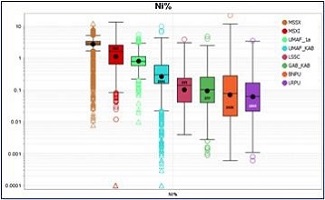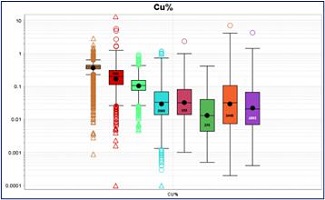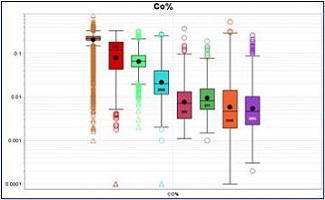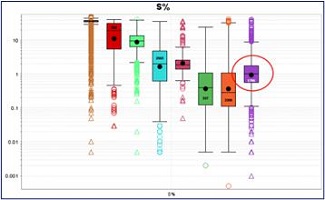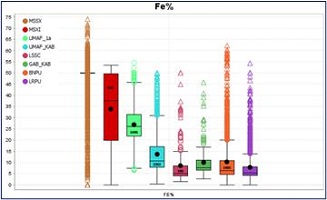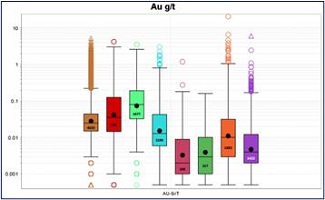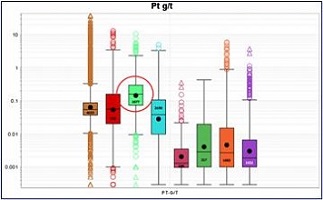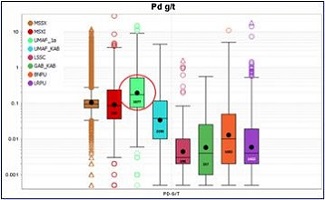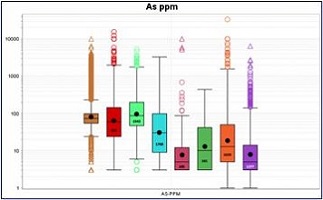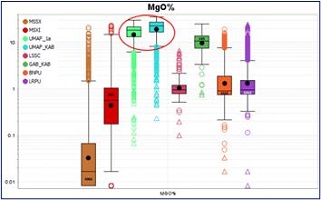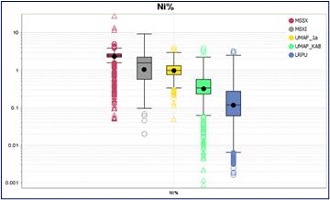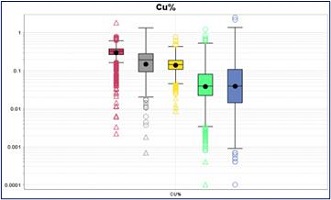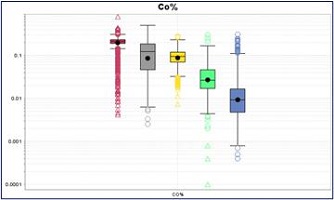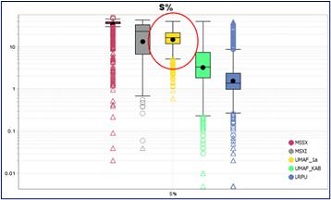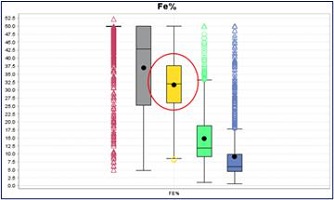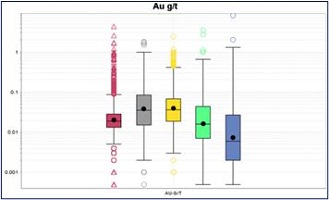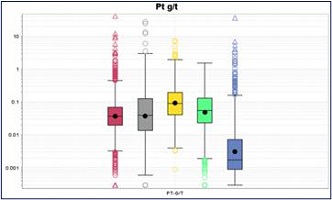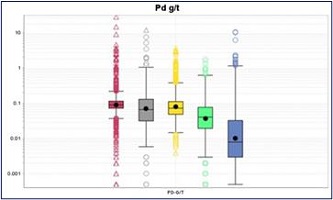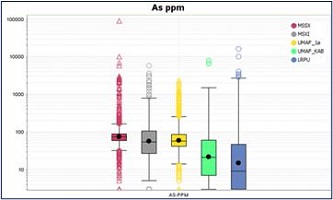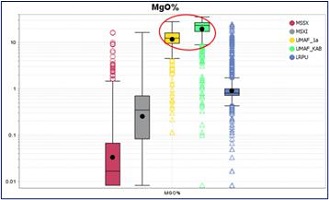Exhibit 96.1
Lifezone Holdings Ltd
Kabanga 2023 Mineral Resource
16/02/2023
Kabanga Nickel
| Rev | Description of Change | Project Leader | Approved |
| 0 | Final Draft | GM | RLK |
| | | | |
| | | | |
Lifezone Holdings Ltd
Table of Contents
| 1 | Executive Summary | | 1 |
| 1.1 | Introduction | | 1 |
| 1.2 | Accessibility, Climate, Local Resources, Infrastructure, and Physiography | | 1 |
| 1.3 | Land Tenure and Ownership | | 3 |
| | 1.3.1 | Ownership | | 3 |
| | 1.3.2 | Tanzanian Legislation | | 4 |
| | 1.3.3 | Kabanga Framework Agreement Summary | | 5 |
| | 1.3.4 | Special Mining Licence | | 7 |
| | 1.3.5 | BHPB Investment in Kabanga Nickel Limited | | 8 |
| 1.4 | Geology and Mineralisation | | 8 |
| | 1.4.1 | Regional Geology | | 8 |
| | 1.4.2 | Property Geology | | 9 |
| | 1.4.3 | Lithologies and Stratigraphy | | 10 |
| | 1.4.4 | Structural Setting | | 10 |
| | 1.4.5 | Deposit Description | | 11 |
| | 1.4.6 | Mineralisation Style | | 11 |
| | 1.4.7 | Alteration and Weathering | | 11 |
| 1.5 | Exploration | | 11 |
| 1.6 | Mineral Resources | | 13 |
| | 1.6.1 | Resource Modelling | | 13 |
| | 1.6.2 | Classification | | 13 |
| | 1.6.3 | Cut-off Grade | | 14 |
| | 1.6.4 | Reasonable Prospects for Eventual Economic Extraction (Initial Assessment) | | 14 |
| | 1.6.5 | Mineral Resources Estimates | | 14 |
| 1.7 | Mineral Reserves | | 16 |
| 1.8 | Market Studies | | 16 |
| 1.9 | Environmental and Permitting | | 16 |
| | 1.9.1 | Environmental and Social Governance | | 17 |
| | 1.9.2 | Resettlement | | 17 |
| | 1.9.3 | Community Investment | | 18 |
| | 1.9.4 | Local Employment, Procurement, and Training | | 18 |
| 1.10 | Interpretation and Conclusions | | 18 |
| 1.11 | Recommendations | | 18 |
| 2 | Introduction | | 19 |
| 2.1 | Ownership History | | 19 |
| 2.2 | Terms of Reference | | 19 |
| 2.3 | Qualified Persons | | 20 |
| 2.4 | Qualified Persons Property Inspection | | 20 |
| 2.5 | Units and Currency | | 21 |
| 2.6 | Effective Dates | | 21 |
| 3 | Property Description | | 22 |
| 3.1 | Location | | 22 |
| 3.2 | Ownership | | 23 |
| 3.3 | Tanzanian Mining Sector Legislation | | 24 |
| | 3.3.1 | Introduction | | 24 |
| | 3.3.2 | Primary Mining Sector Legislation | | 25 |
| | 3.3.3 | Environmental and Social Legislation and Land Legislation | | 25 |
| 3.4 | Framework Agreement Summary | | 27 |
| 3.5 | Special Mining Licence | | 28 |
| 3.6 | BHPB Investment in Kabanga Nickel Limited | | 31 |
| | 3.6.1 | T1A Agreement | | 31 |
| | 3.6.2 | T1B Agreement | | 31 |
| | 3.6.3 | T2 Agreement | | 31 |
| 3.7 | Mineral Rights, Surface Rights, and Environmental Rights | | 32 |
| 3.8 | Other Significant Factors and Risks | | 32 |
| 4 | Accessibility, Climate, Local Resources, Infrastructure, and Physiography | | 33 |
| 4.1 | Topography, Elevation, and Vegetation | | 33 |
| 4.2 | Access | | 33 |
| 4.3 | Climate | | 34 |
| 4.4 | Infrastructure / Services | | 34 |
| 4.5 | Local Resources | | 35 |
| 5 | History | | 36 |
| 6 | Geological Setting, Mineralisation, and Deposit | | 38 |
| 6.1 | Regional Geological Setting | | 38 |
| 6.2 | Property Geology | | 39 |
| 6.3 | Lithologies and Stratigraphy | | 40 |
| 6.4 | Structural Setting | | 41 |
| 6.5 | Deposit Description | | 43 |
| 6.6 | Mineralisation Style | | 43 |
| 6.7 | Alteration and Weathering | | 43 |
| 7 | Exploration | | 44 |
| 7.1 | Exploration Timeline | | 44 |
| | 7.1.1 | Early Regional Exploration | | 44 |
| | 7.1.2 | Sutton Era Exploration | | 44 |
| | 7.1.3 | Barrick Era Exploration | | 45 |
| | 7.1.4 | KNL Era Exploration | | 48 |
| 7.2 | Exploration and Drillhole Database | | 48 |
| | 7.2.1 | Mineral Resource Drillhole Database | | 48 |
| 7.3 | Drilling, Core Logging, Downhole Survey, and Sampling | | 49 |
| | 7.3.1 | Drilling | | 49 |
| | 7.3.2 | Core Recovery | | 49 |
| | 7.3.3 | Core Logging | | 49 |
| | 7.3.4 | Core Sampling | | 50 |
| 7.3.5 | Collar Survey | | 50 |
| | 7.3.6 | Downhole Survey | | 50 |
| | 7.3.7 | Borehole Electromagnetic Data | | 52 |
| | 7.3.8 | Drillhole Database | | 52 |
| 7.4 | Density Measurements | | 52 |
| 7.5 | Planned Drilling Campaigns (2023) | | 55 |
| 8 | Sample Preparation, Analyses, and Security | | 55 |
| 8.1 | Introduction | | 55 |
| 8.2 | Sample Preparation | | 56 |
| 8.3 | Assaying | | 56 |
| 8.4 | QA/QC | | 58 |
| | 8.4.1 | QA/QC Sample Frequency | | 58 |
| | 8.4.2 | Sample Preparation QA/QC – Screen Test | | 58 |
| | 8.4.3 | Duplicates and Check Assays – ALS-Chemex Coarse Reject Duplicates | | 59 |
| | 8.4.4 | Genalysis Pulp Check Assays | | 61 |
| | 8.4.5 | SGS Lakefield Pulp Check Assays | | 65 |
| | 8.4.6 | Quarter Core Replicates | | 65 |
| | 8.4.7 | Reference Material Standards | | 67 |
| | 8.4.8 | Blanks | | 75 |
| 8.5 | QP Opinion | | 75 |
| 9 | Data Verification | | 76 |
| 9.1 | Verifications by the QP | | 76 |
| | 9.1.1 | Site Visit | | 76 |
| | 9.1.2 | Verifications of Analytical Quality Control Data | | 76 |
| | 9.1.3 | Discussion | | 76 |
| 9.2 | QP Comments | | 76 |
| 10 | Mineral Processing and Metallurgical Testing | | 77 |
| 10.1 | Concentrate Testwork | | 77 |
| 10.2 | Downstream Processing Assumption | | 79 |
| | 10.2.1 | Pressure Oxidation Testwork | | 80 |
| 10.3 | Discussion | | 80 |
| 10.4 | QP Comments | | 80 |
| 11 | Mineral Resource Estimates | | 81 |
| 11.1 | Mineral Resource Estimates – Introduction | | 81 |
| 11.2 | Mineral Resource Drillhole Database | | 81 |
| 11.3 | Mineral Resource Domain Interpretations | | 82 |
| 11.4 | Waste Model | | 84 |
| 11.5 | Mineral Resource Domain Statistics | | 84 |
| | 11.5.1 | Grade and Lithology | | 84 |
| | 11.5.2 | Principal Component Analysis | | 90 |
| | 11.5.3 | Compositing | | 92 |
| | 11.5.4 | Top Cutting | | 93 |
| | 11.5.5 | Variography | | 93 |
| | 11.5.6 | Search Parameters | | 94 |
| | 11.5.7 | Kriging Neighbourhood Analysis | | 96 |
| | 11.5.8 | Grade Estimation | | 96 |
| | 11.5.9 | Model Validation | | 96 |
| | 11.5.10 | Classification | | 96 |
| 11.6 | Other Mineralised Zones | | 96 |
| 11.7 | Mineral Resource Cut-off Grade | | 97 |
| | 11.7.1 | 2023 Cut-off Grade | | 97 |
| 11.8 | Reasonable Prospects for Economic Extraction | | 98 |
| 11.9 | Kabanga 2023 Mineral Resource Statement 104 | | 99 |
| 11.10 | Risks and Opportunities | | 101 |
| | 11.10.1 | Risks | | 101 |
| | 11.10.2 | Opportunities | | 101 |
| 11.11 | QP Opinion | | 101 |
| 12 | Mineral Reserve Estimates | | 102 |
| 13 | Mining Methods | | 103 |
| 14 | Processing and Recovery Methods | | 104 |
| 15 | Infrastructure | | 105 |
| 16 | Market Studies | | 106 |
| 16.1 | Marketing and Metal Prices | | 106 |
| 16.2 | QP Opinion | | 106 |
| 17 | Environmental Studies, Permitting, and Plans, Negotiations, or Agreements with Local Individual or Groups | | 107 |
| 17.1 | Water Management | | 107 |
| | 17.1.1 | Mine Dewatering | | 107 |
| | 17.1.2 | Site Water Balance | | 108 |
| | 17.1.3 | Surface Water Management | | 108 |
| | 17.1.4 | Water Stewardship | | 108 |
| 17.2 | Environmental, Social, and Governance | | 109 |
| | 17.2.1 | Key Features of the Environmental and Social Setting | | 109 |
| | 17.2.2 | Environmental and Social Management | | 111 |
| | 17.2.3 | Stakeholder Engagement and Grievance Management | | 112 |
| 17.3 | Resettlement | | 112 |
| 17.4 | Community Investment | | 113 |
| 17.5 | Local Employment, Procurement, and Training | | 113 |
| 17.6 | Closure | | | 114 |
| 17.7 | Salient ESG Issues | | 114 |
| | 17.7.1 | ESIA Baseline | | 114 |
| | 17.7.2 | Environmental Certificate | | 114 |
| | 17.7.3 | Stakeholder Expectations | | 114 |
| | 17.7.4 | Resettlement | | 114 |
| | 17.7.5 | In-migration | | 115 |
| | 17.7.6 | Carbon footprint | | 115 |
| | 17.7.7 | Water and Geochemistry | | 115 |
| 18 | Capital and Operating Costs | | 116 |
| 19 | Economic Analysis | | 117 |
| 20 | Adjacent Properties | | 118 |
| 21 | Other Relevant Data and Information | | 119 |
| 22 | Interpretation and Conclusions | | 120 |
| 23 | Recommendations | | 121 |
| 23.1 | Environment, Social, and Governance | | 121 |
| | 23.1.1 | Stakeholder Expectations and Resettlement | | 122 |
| | 23.1.2 | In-migration | | 122 |
| | 23.1.3 | Water and Geochemistry | | 122 |
| 23.2 | KNL Work Plan | | 123 |
| | 23.2.1 | Work Plan Cost Estimate | | 123 |
| 23.3 | QP Comments | | 124 |
| 24 | References | | 124 |
| 25 | Reliance on Information Provided by the Registrant | | 125 |
Table of Figures
| Figure 1.1 | | – | | Kabanga Nickel Project Location | | 2 |
| Figure 1.2 | | – | | Local Area Plan | | 3 |
| Figure 1.3 | | – | | Lifezone and Kabanga Nickel Group Structure | | 4 |
| Figure 1.4 | | – | | Location of the Project showing Tenements | | 6 |
| Figure 1.5 | | – | | Location of the Project showing Detail of SML 651 / 2021 | | 7 |
| Figure 1.6 | | – | | Plan View Schematic of Geology of the Kabanga Area | | 10 |
| Figure 1.7 | | – | | Projected Long-section Schematic of Kabanga Mineralised Zones | | 11 |
| Figure 3.1 | | – | | Kabanga Nickel Project Location | | 22 |
| Figure 3.2 | | – | | Local Area Plan | | 23 |
| Figure 3.3 | | – | | Lifezone and Kabanga Nickel Group Structure | | 24 |
| Figure 3.4 | | – | | Location of the Project showing SML 651 / 2021 | | 29 |
| Figure 4.1 | | – | | KNL Camp | | 35 |
| Figure 6.1 | | – | | Stratigraphic Column for the Kagera Supergroup | | 39 |
| Figure 6.2 | | – | | Plan View Schematic of Geology of the Kabanga Area | | 40 |
| Figure 6.3 | | – | | Typical Stratigraphy Cross Section Schematics for North and Tembo | | 41 |
| Figure 6.4 | | – | | Major Structures – Kabanga Sulfide Zones | | 42 |
| Figure 6.5 | | – | | Comparative Interpretation of 3D and 2D VTEM Data | | 42 |
| Figure 6.6 | | – | | Projected Longitudinal Section Schematic of Kabanga Mineralised Zones | | 43 |
| Figure 7.1 | | – | | Kabanga Drillhole Locations Proximal to Mineral Resources (local grid) | | 51 |
| Figure 7.2 | | – | | Comparison of Water Immersion vs. Pycnometry Density for Massive Sulfide | | 53 |
| Figure 7.3 | | – | | Pycnometer Density Measurements for North and Tembo Massive Sulfide | | 54 |
| Figure 7.4 | | – | | Pycnometer Density Measurements for North and Tembo UMAF_1a | | 54 |
| Figure 8.1 | | – | | Percent Reject Passing –2 mm Screen – 2005–2009 | | 59 |
| Figure 8.2 | | – | | ALS-Chemex – Percent Relative Difference for Ni Duplicates – 2005–2009 | | 60 |
| Figure 8.3 | | – | | ALS-Chemex – Percent Relative Difference for Cu Duplicates – 2005–2009 | | 60 |
| Figure 8.4 | | – | | ALS-Chemex – Percent Relative Difference for Co Duplicates – 2005–2009 | | 61 |
| Figure 8.5 | | – | | Genalysis vs. ALS-Chemex Pulp Check Assays Percent Relative Difference for Ni Grades 2005–2009 Sequential Analysis for MSSX Ni>2% | | 62 |
| Figure 8.6 | | – | | Impact of Oxidation of Pulps on Assay Results – 2005 ALS-Chemex Test – Relative Percentage Decrease in Ni Grade vs. Number of Days between Pulverisation and Analysis (pulps allowed to oxidise) | | 63 |
| Figure 8.7 | | – | | Genalysis vs. ALS-Chemex Pulp Check Assays Percent Relative Difference for Ni Grades 2005–2009 | | 63 |
| Figure 8.8 | | – | | Genalysis vs. ALS-Chemex Pulp Check Assays Percent Relative Difference for Cu Grades 2005–2009 | | 64 |
| Figure 8.9 | | – | | Genalysis vs. ALS-Chemex Pulp Check Assays Percent Relative Difference for Co Grades 2005–2009 | | 64 |
| Figure 8.10 | | – | | SGS Lakefield vs. ALS-Chemex Pulp Check Assays Percent Relative Difference for Ni Grades | | 65 |
| Figure 8.11 | | – | | ALS-Chemex – Percent Relative Difference for Ni Grades for Quarter Core Replicates – 2005–2007 | | 66 |
| Figure 8.12 | | – | | ALS-Chemex – Percent Relative Difference for Cu Grades for Quarter Core Replicates – 2005–2007 | | 66 |
| Figure 8.13 | | – | | ALS-Chemex – Percent Relative Difference for Co Grades for Quarter Core Replicates – 2005–2007 | | 67 |
| Figure 8.14 | | – | | Kabanga MSSX CRM Ni Values 2005–2009 | | 69 |
| Figure 8.15 | | – | | Kabanga UMAF CRM Ni Values 2005–2009 | | 69 |
| Figure 8.16 | | – | | Kabanga MSSX CRM Ni% Values by Genalysis 2005–2009 | | 70 |
| Figure 8.17 | | – | | ALS-Chemex Internal Forrest B Reference Material Standard – Results from 2005–2009 | | 71 |
| Figure 8.18 | | – | | Kabanga MSSX CRM Cu Values 2005–2009 | | 73 |
| Figure 8.19 | | – | | Kabanga MSSX CRM Co Values 2005–2009 | | 73 |
| Figure 8.20 | | – | | Kabanga UMAF CRM Cu Values 2005–2009 | | 74 |
| Figure 8.21 | | – | | Kabanga UMAF CRM Co Values 2005–2009 | | 74 |
| Figure 8.22 | | – | | Blanks – Ni Results 2005–2009 | | 75 |
| Figure 10.1 | | – | | Conceptual Flow Sheet for the Proposed MMPF Process | | 80 |
| Figure 11.1 | | – | | Schematic Long-section View of the Kabanga Mineralised Zone Wireframes with the Topography Surface (looking west) | | 84 |
| Figure 11.2 | | – | | Pie Chart of Assayed Lithologies – North Zone | | 85 |
| Figure 11.3 | | – | | Ni Box Plot Ranked for all Assayed Lithologies – North Zone | | 85 |
| Figure 11.4 | | – | | Box Plots for a Suite of Elements for the Main Assayed Lithologies – North Zone | | 86 |
| Figure 11.5 | | – | | Pie Chart of Assayed Lithologies – Tembo Zone | | 87 |
| Figure 11.6 | | – | | Ni Box Plot Ranked for all Assayed Lithologies – Tembo Zone | | 87 |
| Figure 11.7 | | – | | Box Plots for a Suite of Elements for the Main Assayed Lithologies – Tembo Zone | | 88 |
| Figure 11.8 | | – | | Average Grades (Ni, Ag, Cu, Co, S, and Fe) by Lithology for North (N) and Tembo (T) | | 89 |
| Figure 11.9 | | – | | PC1–PC2 Diagram – North Zone | | 90 |
| Figure 11.10 | | – | | PC1–PC2 Diagram – Tembo Zone | | 90 |
| Figure 11.11 | | – | | Histograms of Sample Lengths – North Zone | | 92 |
| Figure 11.12 | | – | | Histograms of Sample Lengths – Tembo Zone | | 93 |
| Figure 17.1 | | – | | Project Location and Protected Areas | | 110 |
| Figure 17.2 | | – | | Local Area Plan | | 111 |
Table of Tables
| Table 1.1 | | – | | Exploration Drilling Summary (to 31 December 2022) | | 12 |
| Table 1.2 | | – | | Kabanga Mineral Resource Estimates as at 31 December 2016 Based on $9.50/lb Ni Price, $4.00/lb Copper, and $26.00/lb Cobalt | | 15 |
| Table 3.1 | | – | | Special Mining Licence SML 651 / 2021 Corner Coordinates | | 30 |
| Table 7.1 | | – | | Exploration Drilling Summary | | 44 |
| Table 7.2 | | – | | Number of Drillholes with/without Assays for North and Tembo | | 48 |
| Table 7.3 | | – | | Downhole Survey Statistics | | 50 |
| Table 7.4 | | – | | Overall Downhole Survey Statistics for North and Tembo | | 51 |
| Table 8.1 | | – | | Summary of Analytical Techniques for Mineral Resource Drilling | | 57 |
| Table 8.2 | | – | | Frequency of QA/QC Samples 2005–2009 | | 58 |
| Table 8.3 | | – | | Kabanga MSSX and UMAF CRM – Accepted Grades | | 67 |
| Table 8.4 | | – | | Kabanga MSSX and UMAF CRM – Tracking of Ni% Results 2005–2009 | | 70 |
| Table 8.5 | | – | | Kabanga MSSX CRM – Tracking of Ni% Results by Era | | 70 |
| Table 8.6 | | – | | Kabanga CRMs – Summary Statistics 2005–2009 | | 71 |
| Table 8.7 | | – | | ALS-Chemex Internal Reference Material Standards – Tracking of Ni% Results 2005–2009 | | 72 |
| Table 8.8 | | – | | ALS-Chemex Internal Forrest B Standard – Summary Statistics 2005–2009 | | 72 |
| Table 10.1 | | – | | Metallurgical Testwork Summary | | 77 |
| Table 11.1 | | – | | Parameters used Inform 2010 Mineralisation Interpretation and Estimation | | 83 |
| Table 11.2 | | – | | Interpretation Extrapolation Guidelines | | 83 |
| Table 11.3 | | – | | PCA Correlation Matrix – MSSX, MSXI, UMAF_la, and UMAF_KAB – North Zone | | 91 |
| Table 11.4 | | – | | PCA Correlation Matrix – MSSX, MSXI, UMAF_la, and UMAF_KAB – Tembo Zone | | 91 |
| Table 11.5 | | – | | MSSX Variogram Parameters – North Zone | | 94 |
| Table 11.6 | | – | | UMIN Variogram Parameters – North Zone | | 94 |
| Table 11.7 | | – | | MSSX Search Parameters – North Zone | | 95 |
| Table 11.8 | | – | | UMIN Search Parameters – North Zone | | 95 |
| Table 11.9 | | – | | NiEq23 Input Parameters | | 97 |
| Table 11.10 | | – | | 2023 Cut-off Grade Parameters | | 98 |
| Table 11.11 | | – | | Kabanga Mineral Resource Estimates as at 31 December 2016 Based on $9.50/lb Ni Price, $4.00/lb Copper, and $26.00/lb Cobalt | | 100 |
| Table 16.1 | | – | | Metal Prices | | 106 |
| Table 23.1 | | – | | Work Programme Cost Estimate | | 123 |
| Lifezone Holdings Ltd | viii |
The Kabanga Mineral Resource 2023 Technical Report Summary (2023MRE) has been prepared in accordance with the U.S. Securities and Exchange Commission (US SEC) Regulation S-K subpart 1300 rules for Property Disclosures for Mining Registrants (S-K 1300) for Lifezone Holdings Ltd (LHL) on the Kabanga nickel project (the Project). The 2023MRE is a preliminary technical and economic study of the economic potential of the Project mineralisation to support the disclosure of Mineral Resources.
The Mineral Resource estimates are based on Mineral Resources originally disclosed by the previous owners of the Project as being current as at 31 December 2016.
Studies undertaken and data subsequently collected by LHL support the Mineral Resource tabulations disclosed by the previous owners of the Project. The 2023MRE QP has reviewed the supplied data and information and it appears acceptable to use as Mineral Resource estimates.
The Mineral Resource estimates in the 2023MRE are reported in accordance with subpart 1300 of US Regulation S-K Mining Property Disclosure Rules (S-K 1300).
The 2023MRE QP has reviewed the supplied data and information and it appears acceptable to use for the public reporting of Mineral Resource estimates.
The Project operating entity, Kabanga Nickel Ltd (KNL), is the primary source of technical data and information discussed within this Technical Report Summary (TRS).
Having reviewed the supplied data and information, the 2023MRE QP accepts this information for use in the 2023MRE on the basis that it appears accurate. Information and data supplied by LHL that were relied upon when forming the findings and conclusions of this report but were outside the areas of expertise of the QP are detailed in Section 25. Any individual or entity referenced within the 2023MRE as having completed work, but not identified therein as being a QP, does not constitute a QP.
The 2023MRE should be construed in light of the methods, procedures, and techniques used in its preparation. Sections or parts of the 2023MRE should not be read in isolation from or removed from their original context.
| 1.2 | Accessibility, Climate, Local Resources, Infrastructure, and Physiography |
The Kabanga nickel project is located in the Ngara district in north-west Tanzania, 44 km south of the town of Ngara, south-east of the nearest town of Bugarama, and close to the border with Burundi. Figure 1.1 shows the Project location in Tanzania. Figure 1.2 shows the Project site, nearby villages, and the Burundi border. The exploration camp is located at 02°53.161’S and 30°33.626’E.
The Ngara district is one of the eight districts of the Kagera region of Tanzania. It is bordered to the north by Karagwe district, to the east by Biharamulo district, to the south by the Kigoma region, to the north-east by Muleba district, and to the west by the countries of Rwanda and Burundi. Lake Victoria is approximately 130 km north-east of the Project area.
The proposed mine site is accessible by road connecting to the National Route B3 at Muzani. Three potential access routes have been identified: northern, central, and southern, with the southern route currently preferred due to its shorter distance (approximately 80 km to Muzani) and being considered to have the lowest environmental and social impact. The southern route is presently a dirt road prone, in at least two places, to rutting in the rainy season and occasional flooding.
There is a railway from Dar es Salaam to Isaka that is currently being upgraded. Isaka is approximately 350 km south-east of the Project (approximately 90 km south–south-east of Bulyanhulu).
Figure 1.1 – Kabanga Nickel Project Location
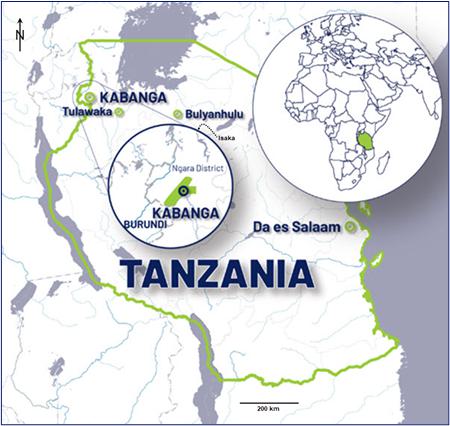
Within the Project area, domestic water supplies are typically obtained from the small tributary streams, from springs on the Project ridge, and from shallow dug wells in the valley bottom lands. The rivers are not used for domestic water supply. The Project area is located in the moist sub-humid climate zone of east-central Africa, which is dominated by monsoonal weather patterns. The long-term average annual rainfall in the Project area is 1,013 mm.
Infrastructure in the Ngara district is limited in terms of national grid power and reticulated potable water supplies. A transmission line and sub-station from a new hydroelectric project to the north-west of Tanzania is within 70 km of the Project site and an extension of the 200kV line to the project is planned within the development time of the Project.
Financial and human resources for district-level facilities are limited and there are difficulties in attracting and retaining qualified and experienced staff in Ngara district. Despite resource shortfalls, the local government system is functional and all of the 15 villages adjacent to the Project have at least one primary school, all wards have secondary schools, and most villages and wards have health facilities.
Figure 1.2 – Local Area Plan
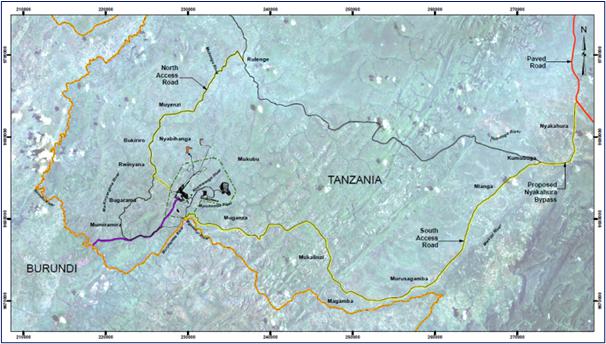
| 1.3 | Land Tenure and Ownership |
The relationship between Lifezone Holdings Ltd (LHL) and the operating entities that will manage the Project are shown in Figure 1.3.
The Kabanga project is 84% owned and operated by Kabanga Nickel Ltd (KNL), with the remaining 16% held by the Government of Tanzania (the Government) under the terms of a framework agreement.
KNL is jointly owned by LHL (83%) through its 100% entity, Lifezone Limited, with the remaining 17% directly owned by BHP Billiton (UK) DDS Limited (BHPB).
For Mineral Resource reporting, the LHL direct ownership share is 69.713% of the in situ mineralisation after excluding the shares of the Government and direct BHPB ownership.
Figure 1.3 – Lifezone and Kabanga Nickel Group Structure
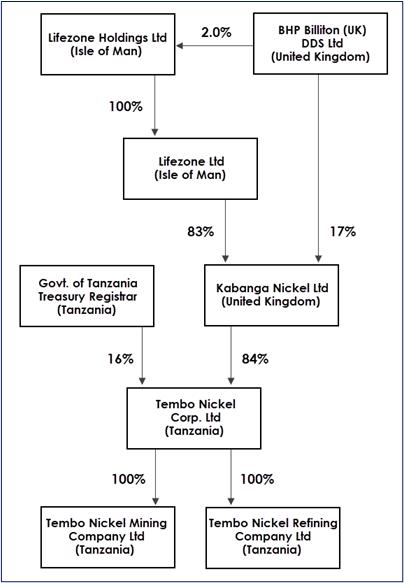
| 1.3.2 | Tanzanian Legislation |
In Tanzania, minerals and natural resources are state owned and the rights to explore and mine minerals and to use natural resources are obtained from regulatory bodies defined in legislation that have a defined duration and are conditioned.
Mineral rights are held in the form of prospecting licences and mining licences. There are several types of prospecting licences and mining licences, depending on the nature of the minerals being mined and the size of the mine. A Special Mining Licence (SML) is the type of licence required for large-scale mining operations (‘large-scale’ being defined as those requiring a capital investment not less than US$100 million), and so this is the type of licence required for Kabanga.
Associated with each SML is an Investor–State Framework Agreement between the holder of the SML and the Government. The agreement includes clauses on the conduct of mining operations, the grant of the Government free-carried interest, and State participation in mining and the financing of any mining operations.
Mining legislation requires observance of environmental legislation and mining licences cannot be granted without an environmental approval certificate being in place. After mining licences are received, several secondary permits are required for activities that could impact on people and the environment.
Under modern Tanzanian legislation, mineral rights do not confer surface rights. Surface rights were strengthened with the passing of the Land Act 1999, and the Village Act 1999, and application of these Acts to the mining sector was enhanced by the Mining Act 2010.
| 1.3.3 | Kabanga Framework Agreement Summary |
The following summary and description of the Kabanga Framework Agreement has been prepared by LHL.
The Kabanga Framework Agreement (Framework Agreement) is focussed on equitable economic benefit sharing according to the principles included in Article 3 of that agreement. It recognises the formation of a Joint Venture Company (JVC) that is called Tembo Nickel Corporation Limited (TNCL), which has two subsidiaries – Tembo Nickel Mining Company Limited, and Tembo Nickel Refining Company Limited. TNCL is referred to as both ‘JVC’ and ‘Tembo Nickel Corporation Limited’ in the Framework Agreement and in the SML. As is required under the Miscellaneous Amendments Act 2017, which amends the Mining Act 2010, the Framework Agreement:
| § | Provides for the Government to have a 16% non-dilutable, fee-carried share interest in the capital of TNCL (with the remaining interest being held by KNL, |
| § | Includes royalties on the gross value of minerals to be paid at a rate of 6%, where ‘gross value’ means the market value of minerals determined through valuation as defined in the Miscellaneous Amendments Act 2017. The Government can reject the valuation if it is low due to market volatility and can buy the minerals at the low value ascertained, |
| § | Requires beneficiation of mineral products of operations in country, and |
| § | Includes requirements to procure goods and services locally. |
In addition to royalties, the Framework Agreement elaborates on other taxes, fiscal levies, and funding mechanisms that will apply, notably:
| § | An inspection fee of 1% of gross revenue, |
| § | A service levy of 0.3% of gross revenue, |
| § | Non-deductibility of royalty for the calculation of corporate income tax, |
| § | Corporate income tax of 30%, |
| § | Indefinite carry-forward of losses but with the ability to offset against taxable income in any given tax year subject to a cap of 70% of the taxable income in a given tax year, |
| § | Application of straight-line pooled asset depreciation at a rate of 20% per annum, and |
| § | The ability for KNL to lend funding to TNCL through shareholder loans at an interest rate of zero percent. |
The beneficiation facility in the Framework Agreement is referred to in that agreement as a ‘Multi-purpose Mineral Processing Facility’ (MMPF, or multi-metal mineral processing facility), and its purpose is stated as ‘processing, smelting and refining of nickel and other mineral concentrates’, albeit that it should be noted that no smelting is envisaged in this project as all metal extraction will utilise a hydrometallurgical process. TNCL will manage the operations of the mine and the MMPF through subsidiaries, while the Government will assist TNCL in acquiring suitable land for the construction of the MMPF within the vicinity of Kahama township. KNL is required to oversee the construction of the MMPF at Kahama and to prepare the requisite reports on Kabanga, including feasibility studies for the mine and the MMPF, and the corresponding environmental impact assessments (EIA) required by law.
The Framework Agreement states that upon granting of the SML, TNCL (or any relevant subsidiary) will begin the process of identifying a physical location for the MMPF with the Kahama region being the initial priority location to assess given the beneficial infrastructure advantages. Upon confirmation of site identification, JVC (or any relevant subsidiary) may submit an application for a Refining Licence for the MMPF.
The Framework Agreement requires that the management of JVC’s operations is carried out in Tanzania, with a focus on engaging local talent to maximise employment of Tanzanians, including: preference for Tanzanian nationals to be appointed to management positions within the JVC, and implementing a local procurement plan that emphasises spending in Tanzania, except where goods or supplies are not available in Tanzania (or on commercially viable or competitive terms in Tanzania) or supplies are permitted to be procured from sources outside Tanzania as provided for under relevant laws.
The Framework Agreement contains a number of schedules. These schedules provide a process for the establishment of the various legal entities, shareholder agreements, and importantly a series of timebound undertakings to facilitate the development of the Project.
By May 2022, TNCL had been granted six prospecting licences covering a combined area of 101.44 km2: these are PL 11852 / 2022, PL 11853 / 2022, PL 11854 / 2022, PL 11855 / 2022, PL 11856 / 2022, and PL 11924 / 2022 (see Figure 1.4).
All field work since December 2021 has been conducted on SML 651 / 2021.
Figure 1.4 – Location of the Project showing Tenements
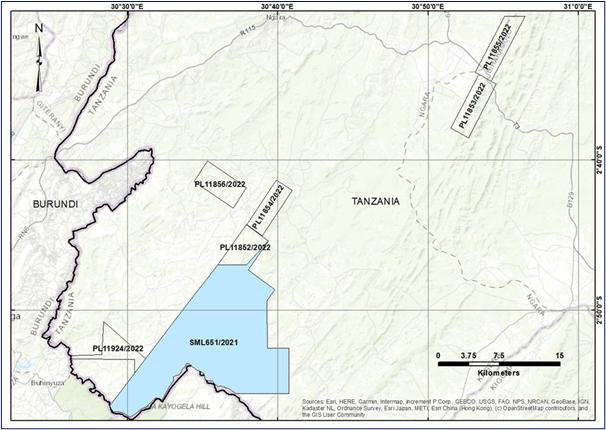
| 1.3.4 | Special Mining Licence |
The following is a summary of the SML 651 / 2021 document, dated 25 October 2021.
On 25 October 2021, following the signing of the Framework Agreement on 19 January 2021, the Government granted SML 651 / 2021 to Tembo Nickel Corporation Limited (JVC) for the Project. JVC held the area under Retention Licence RL 0001 / 2009 and submitted a Feasibility Study over the licence area in compliance with Parts A, B, and C of the SML for the grant.
The SML (refer Figure 1.5) confers to JVC the exclusive right to search for mine, dig, mill, process, refine, transport, use, and/or market nickel, or other minerals found to occur in association with that mineral, in and vertically under the SML area, and execute such other works as are necessary for that purpose.
Pursuant to the provisions of the Mining Act, the SML shall be valid for a period of up to 33 years, effective from 25 October 2021, subject to terms and conditions set out under Parts A, B, and C annexed to the SML, unless cancelled, suspended, or surrendered sooner.
Figure 1.5 – Location of the Project showing Detail of SML 651 / 2021
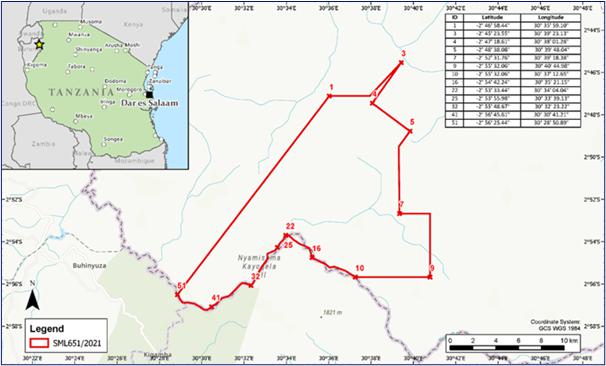
The SML requires JVC to strictly observe the mining laws, in particular, but not limited to, the recognition that all mineral data and exploration information over the licence area is the property of the Government and must be submitted to the Geological Survey of Tanzania in accordance the Mining Act 2010.
With the grant of the SML, JVC agreed to become a strategic partner to the Government, which shall have not less than 16% of the capital of the entity established, to carry out mining activities over the licence area in the form of non-dilutable free-carried interest in accordance with the Mining Act, and subject to the provisions of the Mining Act and of the regulations made thereunder now in force, or which may come into force during the continuance of this licence, or any renewal thereof.
| 1.3.5 | BHPB Investment in Kabanga Nickel Limited |
The following summary of the commercial arrangement between LHL and BHPB has been prepared by LHL.
LHL and BHPB have three agreements: T1A, T1B, and T2.
KNL entered into a loan agreement with BHPB, dated 24 December 2021 (the T1A Agreement), pursuant to which KNL received investment of US$40 million from BHPB by way of a convertible loan. Following receipt of approval from the Tanzanian Fair Competition Commission and the fulfilment of other conditions, the convertible loan was converted into an 8.9% equity interest in KNL on 1 July 2022.
KNL entered into a US$50 million equity subscription agreement with BHPB, dated 14 October 2022 (the T1B Agreement). All the conditions precedent of the T1B Agreement were satisfied or waived on or before 8 February 2023 and, in accordance with the T1B Agreement, BHPB subscribed US$50 million for an additional 8.9% equity interest in KNL on 15 February 2023, giving BHPB a total equity interest in KNL of 17% (the T1B Investment).
The T1B Investment proceeds will be used for the ongoing funding requirements of the Project in accordance with a budget agreed between KNL and BHPB.
KNL and Lifezone Limited entered into an option agreement with BHPB, dated 14 October 2022 (the T2 Agreement), under which KNL will (at BHPB's option) receive investment from BHPB by way of an equity subscription (the Option). The Option grants BHPB the right, subject to certain conditions, to subscribe for the required number of KNL shares that, in aggregate with its existing KNL shareholding, would result in BHPB indirectly owning 51% of the total voting and economic equity rights in TNCL on a fully diluted basis as at the date of the subscription (the Option Shares) at a price to be determined through an independent expert valuation (the T2 Investment). If exercised as at the date of the T2 Agreement, the Option would result in BHPB owning 60.71% of the total voting and economic equity rights in KNL on a fully diluted basis.
| 1.4 | Geology and Mineralisation |
The Kabanga deposit is located within the East African Nickel Belt (EANB), which extends approximately 1,500 km along a north-east trend that extends from Zambia in the south-west, though the Democratic Republic of Congo (DRC), Burundi, Rwanda, Tanzania, and Uganda in the north-east, and straddles the western boundary of the Tanzania Craton to the east and the eastern boundary of the Congo Kasai Craton to the west.
In the northern and central sections of the EANB, a thick package of Paleoproterozoic to Mesoproterozoic metasedimentary rocks, known as the Karagwe–Ankole Belt (KAB), overlies this boundary, within which occurs a suite of broadly coeval, bimodal intrusions, (Evans et al, 2016). These igneous rocks correspond to the Mesoproterozoic Kibaran tectonothermal event between 1,350 to 1,400 Ma, (Kokonyangi et al, 2006; Tack et al, 2010).
The KAB has been divided into several broad domains, (Tack et al, 1994), as follows:
| § | An Eastern Domain (ED) that is characterised by lower degrees of metamorphism and tectonism and the absence of Kibaran-aged granite magmatism, |
| § | A Western Domain (WD) characterised by higher degrees of metamorphism and polyphase deformation and the voluminous Kibaran granite intrusion, and |
| § | A Transitional Domain (TD) between the other two domains, which is marked by a north-east trending line of mafic–ultramafic intrusions known as the Kabanga–Musongati Alignment (Tack et al, 1994). |
The sedimentary rocks of the ED and WD form uncorrelated and distinct sub-basins, both comprising alternating arenaceous and pelitic rocks including quartzites, schists, greywackes, and conglomerates, developed in long-lived, shallow-water intracratonic and pericontinental basins, (Fernandez-Alonso et al, 2012).
The Kibaran igneous rocks comprise mafic–ultramafic intrusions, including well-differentiated lopolithic layered intrusions and small, narrow, tube-like sills, often concentrically zoned, called chonoliths. The nickel mineralisation zones discovered to date at the Project have exclusively been found associated with the mafic–ultramafic intrusions, in particular, along the Kabanga–Musongati Alignment, (Deblond and Tack, 1999; Evans et al, 2000). Felsic intrusions occur coeval with the mafic–ultramafic intrusions. Recent ages (U-Pb zircon SHRIMP) from Kabanga date the marginal mafic rocks of the North intrusion at 1,403 ± 14 Ma, (Maier et al, 2007).
The intrusions that host the known potentially economic nickel-bearing massive sulfide zones in the Project area (Figure 1.6), namely North, Tembo, Main, and MNB, are found within steeply dipping overturned metasediments (dipping to the west (70° to 80°) with a north–north-east strike orientation (025°) from Main to North zone, changing to a north-east strike orientation (055°) from North to Tembo.
The mineralised zones are located within, and at the bottom margin of, the mafic–ultramafic chonoliths. The chonoliths are concentrically zoned with a gabbronorite margin and an ultramafic cumulate core zone that ranges in composition from sulfidic dunite, plagioclase-peridotite, orthopyroxenite, to olivine melanorite, (Evans et al, 2000).
The metasediments comprise approximately 90% metapelites and metasandstones, with the remainder comprising clean arenitic metasandstones or quartzites, (Evans et al, 2016). Lenses and bands of iron sulfides (up to 5% modal of pyrrhotite) and graphite are common in the more-pelitic rocks, and it has been demonstrated that the sulfur within the different mineralised zones has similar isotopic signatures, indicating significant assimilation of external sulfur from the KAB sediments, (Maier et al, 2010).
Figure 1.6 – Plan View Schematic of Geology of the Kabanga Area
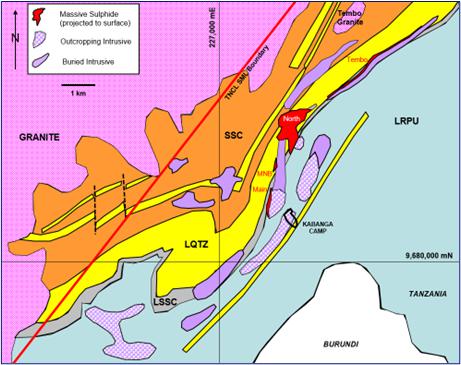
| 1.4.3 | Lithologies and Stratigraphy |
Three lithological groups are present at Kabanga:
| § | Remobilised massive sulfide (>80% sulfide) (MSSX), which carries 90% of the sulfide occurrence and massive sulfide with xenoliths of metasedimentary or gabbro / ultramafic rock (≥50% to 80% sulfides) (MSXI). |
| § | Ultramafic–mafic intrusive complex rocks, which display a wide range of metamorphism / metasomatism. These lithologies can also carry significant sulfide mineralisation, such as in the ultramafic unit named UMAF_1a (≥30% sulfides, located adjacent to the MSSX, present at Tembo and North). |
| § | Metasediments comprising a series of pelitic units, schists, and quartzites, forming the hangingwall and footwall of the massive sulfide lenses. |
The massive sulfide comprises principally pyrrhotite, with up to 15% pentlandite. The pentlandite shows distinct globular recrystallisation textures and crystals may reach up to 5 cm in size. Accessory sulfides include chalcopyrite and traces of pyrite, galena, arsenopyrite, cubanite, niccolite, cobaltite, and mackinawite.
The Kabanga sulfide lenses are thought to have been remobilised within a large shear zone, initially conforming to early-phase folding geometries, and subsequently modified and partitioned by low-angle thrusting and cross-faulting. The Project area has been found to be structurally complex, with five fault sets identified to date.
Structural modelling has been undertaken (2008–2009) to support the current structural interpretation of the Project area.
The Project comprises six distinct mineralised zones, namely (from south-west to north-east) Main, MNB, Kima, North, Tembo, and Safari, which occur over a strike length exceeding 7.5 km. The four mineralised zones that contribute to the Mineral Resource estimates (Tembo, North, MNB, and Main), extend over a total strike length of 6 km and for up to 1.3 km below surface. Figure 1.7 is a projected long-section schematic showing all the mineralised zones identified to date at Kabanga.
Figure 1.7 – Projected Long-section Schematic of Kabanga Mineralised Zones

| 1.4.6 | Mineralisation Style |
Kabanga sulfide mineralisation occurs both as:
| § | Disseminated to net textured interstitial sulfides within the cumulate core zone of the Kabanga chonoliths, as well as externally, and |
| § | Massive and semi-massive bodies along the lower or side margins of the chonolith, that being the contact with the stratigraphic base, (Evans et al, 1999). |
| 1.4.7 | Alteration and Weathering |
At the surface, the ultramafic bodies are completely weathered to saprolite. The depth of the saprolite profile ranges from 40–100 m in the Project area. At the North zone, massive sulfides are weathered to depths of 80–100 m. The massive sulfide horizon at the Tembo zone is more than 98% within fresh material, with minor oxidation present in the upper southern and northern parts of the mineralisation. In general, nickel laterite formation over the associated ultramafic rock is only weakly developed with minor nickel-bearing serpentine and rare garnierite.
Exploration at Kabanga has been undertaken in a number of different phases spanning over 45 years, with more than 596 km of drilling having been completed in total, 26.8 km of which was on regional targets.
The Project drilling history is summarised in Table 1.1.
The first drilling on the deposit was undertaken between 1976 and 1979 by the United Nations Development Program (UNDP), and by the start of the year 2000 a total of 127 km of drilling had been carried out on the Project by various parties.
In 2003, a scoping study was completed by Barrick on the Project, and in 2005, Barrick issued a press release announcing a signed JV partnership with Falconbridge Limited, along with an Inferred Mineral Resource estimate of 26.4 Mt grading 2.6% Ni, representing the sum of the Main and North zone models from 2003.
Table 1.1 – Exploration Drilling Summary (to 31 December 2022)
| TABLE | | | |
| Years | Companies | Metres Drilled | Discovery (purpose) |
| 1976–1979 | UNDP Regional Exploration | 20,068 | Main zone |
| 1991–1992 | Sutton Resources | 12,974 | |
| 1993–1995 | Sutton–BHP JV | 37,947 | North zone |
| 1997–1999 | Sutton–Anglo American JV | 56,227 | |
| 2000–2004 | Barrick Gold Corporation | 39,931 | MNB zone |
| 2005–2008 | Glencore–Barrick Gold JV | 64,957
81,256
242,347 | North Deep zone (scoping study 1)
Tembo Zone (scoping study 2)
Safari / Kima zones (prefeasibility study) |
2008–2009
2011–2012
2014 | Glencore–Barrick Gold JV | 21,368
5,303
3,320 | (Feasibility study) |
| 2021–2022 | KNL | 8,611
4,163 | Tembo North (infill) and Safari
Tembo and North (metallurgical) |
| Total | | 598,472 | |
A combined total of 146,213 m in 257 drillholes was completed for the scoping studies. Borehole electromagnetic (BHEM) surveys with physical properties were completed, SQUID and fixed loop TEM surface geophysical surveys, as well as an airborne helicopter VTEM survey were conducted to characterise the mineralised zones and explore the surrounding area.
A total of 5,508 kg of sample across the two scoping study phases was shipped for metallurgical testing.
Five geotechnical holes were drilled at proposed infrastructure sites.
A further 242,347 m in 555 drillholes was completed for the prefeasibility study phase. This exploration programme was designed to continue to improve the confidence of the North and Tembo resources and discover additional resources to improve the project’s economics within 15 km trucking distance of planned mine infrastructure. Further metallurgical samples were also required for two pilot plant test runs.
Mineral Resource estimates were reported for the June 2008 models in the 2008 Xstrata Nickel annual report.
From December 2008 through August 2009, a total of 21,368 m of drilling was completed. The drilling programme was successful in transferring an estimated 2.8 Mt in the North Mid area from Inferred to Indicated status. An independent consultancy performed a QA/QC audit and a Mineral Resource audit.
From 2010 to 2014, extensive geological / geophysical interpretation was carried out over the Kabanga licence area, coupled with assaying of non-sampled historical BHP / Anglo American Corporation (Anglo) holes in the Main zone area, and led to the development of several high-tenor nickel targets in the southern part of the Project area. Regional exploration work in this era was confined to geological mapping over regional licences and establishing access routes for planned 2011 programmes. Subsequent drilling in 2014 was limited to four holes, which were drilled testing two new target areas, and an additional two holes were drilled into the north end of the Tembo zone.
In December 2021, KNL recommenced activities after the granting of SML 651 / 2021. Two diamond drilling campaigns have been conducted over SML 651 / 2021 by KNL to date, as follows:
| § | December 2021 to May 2022: 4,163 m of drilling in 14 holes to provide 2,727 kg of metallurgical sample (in three bulk samples) from the North and Tembo zones for hydrometallurgical test work in Perth, Australia. |
| § | May 2022 to 31 December 2022: 7,843 m of infill drilling in 23 holes at Tembo North to increase confidence in this zone over a 700 m strike length, and to provide an additional bulk sample (464 kg) for hydrometallurgical test work in Perth, Australia. An additional 768 m in one drillhole was completed at the Safari prospect. |
The KNL drilling is yet to be incorporated into the Mineral Resource database, therefore is currently not able to be considered in the discussion of the Mineral Resources.
Mineral Resource estimates for the Project have been reviewed and are considered to be based on industry best practices and conform to the requirements of S-K 1300 and are suitable for reporting as current estimates of mineral resources.
The Mineral Resource estimates discussed in this section are those included in the unpublished 2014 Technical Report on the Kabanga nickel project prepared for the Glencore–Barrick Gold JV (Glencore–Barrick).
The Project has a long project history, with the first drilling starting in 1976. By the end of 2012, under the Glencore–Barrick Gold joint venture (JV), 582 km of diamond drilling had been completed at the Project. The North and Tembo mineralised zones are the most densely drilled of all the mineralised zoned identified to date.
A resource estimate was completed in 2008 as part of a prefeasibility study. An independent technical audit of the database, QA/QC, and the resource estimate was completed in 2009. The final estimate update from the Glencore–Barrick Gold JV was completed in 2010 after an infill drilling campaign. This 2010 estimate forms the basis of a 2014 draft feasibility study.
A check model was completed for North and Tembo in 2021 using the same drillhole database as the 2010 estimates with a different modelling approach. All grade elements and density were estimated by ordinary kriging (OK). Additionally, inverse distance weighting to the power of 2 (ID2) and nearest neighbour (NN) estimates were completed for validation purposes. The 2010 and 2021 models were validated and compared visually and statistically for all grade elements estimated and for density. The 2023MRE QP has reviewed and accepted this information for validation purposes in the 2023MRE.
The classification criteria and zoning used for the 2010 Mineral Resource estimates are based on the distance from the cell centroid to drillhole samples.
The higher classifications were assigned using wireframe solids defined to enclose areas of consistent geology with drill spacing meeting the recommended drill spacings based on a conditional simulation study.
As the Kabanga North and Tembo zones contain multi-element mineralisation, a nickel-equivalent (NiEq) formula updated for current metal prices, costs and other modifying factors has been used for reporting from the Mineral Resource.
The 2023 nickel equivalent (NiEq23) formula is as follows:
NiEq23 (%) = Ni% + Cu% x 0.411 + Co% x 2.765
The 2023 NiEq cut-off grade is 0.58% NiEq.
Metal price assumptions used for cut-off grade determination were $9.50/lb for nickel, $4.00/lb for copper, and $26.00/lb for cobalt. Other input parameters and assumptions used for the NiEq23% formula and determining the cut-off grade are discussed in Section 11.7.
| 1.6.4 | Reasonable Prospects for Eventual Economic Extraction (Initial Assessment) |
The 2023MRE describes the Mineral Resource estimates of the Kabanga project.
The Initial Assessment assumes an underground mining rate of 2.2 Mtpa. The mining method is underground stoping with backfill, and the extracted mineralised material will feed into an on-site concentrator. Concentrate is assumed to be transported to an off-site hydrometallurgical processing facility to produce final nickel, copper, and cobalt metal, with transport of the final metal to Dar es Salaam and export to markets for sale.
A cash flow analysis was not performed for the Project. The Initial Assessment has been prepared to demonstrate reasonable prospects of economic extraction, not the economic viability of the Mineral Resource estimates. The Initial Assessment is preliminary in nature, it includes Inferred Mineral Resources that are considered too speculative geologically to have modifying factors applied to them that would enable them to be categorised as Mineral Reserves, and there is no certainty that this economic assessment will be realised.
Macroeconomic trends, taxes, royalties, data, and assumptions, interest rates, marketing information and plans, legal matters such as statutory and regulatory interpretations affecting the mine plan and environmental matters are outside the expertise of the QP and are within the control of the registrant (see Section 25).
As significant environmental and social analysis has been conducted for the Project over an extended period, and LHL employs professionals with responsibility in these areas, and these personnel have the best understanding of these areas, and following a review of the current supplied information, the opinion of the QP is that it is reasonable to rely on the information supplied by LHL.
The QP has concluded that the Mineral Resource estimates meet reasonable prospects for eventual economic extraction.
| 1.6.5 | Mineral Resources Estimates |
The Kabanga 2023 Mineral Resource estimates are based on the Mineral Resources reported by Glencore and Barrick, as current in their 2016 annual reports. The nickel-equivalent grade and the modifying factors for the cut-off grade were updated with 2023 assumptions for reporting of the Mineral Resource estimates. Only the portion of the total mineralisation that is attributable to LHL’s interest in the property are shown in Table 1.2.
The Mineral Resource estimates have an effective date of 15 February 2023.
Mineral Resource estimates have been reported in accordance with the US SEC Regulation S-K subpart 1300 rules for Property Disclosures for Mining Registrants (S-K 1300). This is the first time the Kabanga Mineral Resource estimates have been reported under S-K 1300 guidelines.
Table 1.2 – Kabanga Mineral Resource Estimates as at 15 February 2023
Based on $9.50/lb Nickel Price, $4.00/lb Copper, and $26.00/lb Cobalt
| TABLE | | | |
| Mineral Resource Classification | LHL Tonnage (Mt) | Grades | Contained Metal |
NiEq23
(%) | Ni
(%) | Cu
(%) | Co
(%) | NiEq23
(Mlb) | Nickel
(Mlb) | Copper
(Mlb) | Cobalt
(Mlb) |
| MAIN |
| Measured | – | – | – | – | – | – | – | – | – |
| Indicated | 2.14 | 2.44 | 1.92 | 0.28 | 0.15 | 115 | 91 | 13 | 7 |
| Inferred | – | – | – | – | – | – | – | – | – |
| Main Total | 2.14 | 2.44 | 1.92 | 0.28 | 0.15 | 115 | 91 | 13 | 7 |
| MNB |
| Measured | – | – | – | – | – | – | – | – | – |
| Indicated | – | – | – | – | – | – | – | – | – |
| Inferred | 0.51 | 1.98 | 1.52 | 0.20 | 0.13 | 22 | 17 | 2 | 2 |
| MNB Total | 0.51 | 1.98 | 1.52 | 0.20 | 0.13 | 22 | 17 | 2 | 2 |
| NORTH |
| Measured | 4.7 | 3.37 | 2.64 | 0.35 | 0.21 | 348 | 273 | 37 | 22 |
| Indicated | 11.9 | 3.80 | 3.05 | 0.41 | 0.21 | 998 | 801 | 107 | 55 |
| Inferred | 12.0 | 3.29 | 2.64 | 0.35 | 0.18 | 868 | 698 | 93 | 48 |
| North Total | 28.6 | 3.52 | 2.81 | 0.37 | 0.20 | 2,214 | 1,772 | 236 | 125 |
| TEMBO |
| Measured | 4.9 | 3.03 | 2.34 | 0.32 | 0.20 | 325 | 251 | 34 | 22 |
| Indicated | 2.2 | 2.20 | 1.69 | 0.22 | 0.15 | 108 | 83 | 11 | 7 |
| Inferred | 2.1 | 3.05 | 2.41 | 0.31 | 0.18 | 140 | 111 | 14 | 8 |
| Tembo Total | 9.2 | 2.83 | 2.20 | 0.29 | 0.19 | 573 | 445 | 60 | 37 |
| OVERALL MINERAL RESOURCE |
| Measured | 9.6 | 3.20 | 2.49 | 0.34 | 0.21 | 673 | 525 | 71 | 43 |
| Indicated | 16.3 | 3.40 | 2.71 | 0.36 | 0.19 | 1,221 | 974 | 131 | 70 |
| Inferred | 14.6 | 3.21 | 2.57 | 0.34 | 0.18 | 1,031 | 826 | 109 | 58 |
| Total | 40.4 | 3.28 | 2.61 | 0.35 | 0.19 | 2,925 | 2,325 | 311 | 171 |
| 1. | Mineral Resources are reported exclusive of Mineral Reserves. There are no Mineral Reserves to report. |
| 2. | Mineral Resources are reported showing only the LHL attributable tonnage portion, which is 69.713% of the total. |
| 3. | Cut-off uses the NiEq23 using a nickel price of $9.50/lb, copper price of $4.00/lb, and cobalt price of $26.00/lb with allowances for recoveries, payability, deductions, transport, and royalties.
NiEq23% = Ni% + Cu% x 0. 411 + Co% x 2.765. |
| 4. | The point of reference for Mineral Resources is the point of feed into a processing facility. |
| 5. | All Mineral Resources in the 2023MRE were assessed for reasonable prospects for eventual economic extraction by reporting only material above a cut-off grade of 0.58% NiEq23. |
| 6. | Totals may vary due to rounding. |
Mineral Reserves were not estimated for the 2023MRE.
The metal prices used in the 2023MRE are based on an internal assessment of recent market prices, long-term forward curve prices, and consensus among analysts regarding price estimates. The prices selected are at the upper range of long-term consensus price forecasts over the last 10 years. This is an optimistic view of prices for use in the Mineral Resource cut-off grade analysis to ensure that the Mineral Resource does not exclude material that can be included in further studies for defining Mineral Reserves. Metal price assumptions used for cut-off grade determination were $9.50/lb for nickel, $4.00/lb for copper, and $26.00/lb for cobalt.
A nickel concentrate is assumed to be produced on site, and then transported to the multi-metal mineral processing facility (MMPF) to produce final nickel, copper, and cobalt metal, with transport of final nickel, copper, and cobalt metal to Dar es Salaam, and export to markets for sale.
Markets for nickel, copper and cobalt are well established and decarbonisation plans and activities have indicated that they will add to demand of these metals. The demand for these metals is expected to be robust in the long term. As yet, no contracts or detailed marketing studies have been prepared by LHL.
| 1.9 | Environmental and Permitting |
An environmental impact assessment (EIA) certificate (EC/EIS/824) for the mine was granted in 2013 based on the EIA process, and report completed in 2013. The EIA certificate was granted to Kabanga Nickel Company Limited, and the Tanzanian authorities have recognised the validity of the 2013 EIA certificate and authorised the transfer of the certificate to TNCL on 16 June 2021.
This area of Tanzania is largely devoid of large mammals. The most numerous types of fauna identified during the EIA included reptiles, birds, and small rodents. All plant communities identified during the EIA have already been affected to some degree by human activity.
There are no protected areas within the immediate vicinity of the Kabanga project site. The nearest protected area within Tanzania is a small Forest Reserve several kilometres to the north-east.
The site is located only a few kilometres upstream from the Burundi border, which is demarcated by the Muruhamba river. The proposed tailings storage facility (TSF) is located on the Nyamwongo river located within the Muruhamba sub-watershed, approximately 7 km upstream from the border with Burundi.
A programme of comprehensive field investigations and baseline monitoring was undertaken across the Project area between 2005 and 2009, including continuous and manual streamflow monitoring, packer testing, pumping tests (up to 30-day duration), continuous and manual water level measurements, seepage surveys, and a water user census.
Baseline water quality monitoring shows groundwater concentrations with Tanzanian water quality standard exceedances in Al, Fe, and Mn, and surface water exceedances in Al, Fe, Mn, and Ni.
A predictive water balance has been developed for the Project, which has been integrated with the TSF design studies given the critical role that the TSF plays in the Project in terms of water storage. The 2012 EIS considers groundwater and surface water impacts during operations, closure, and post-closure. All of the predicted surface water and groundwater impacts were rated low or negligible.
Due to potential impacts from acid rock drainage and metal leaching (ARDML) from the mine, waste dumps, and TSF, several specific water management measures are required to limit potential water quality impacts from the project during operations and into post-closure (refer to Section 17.7.1 for further detail). The project has a detailed closure plan prepared during the EIA process. The plan is comprehensive and has been incorporated in the project execution as part of the 2014 draft feasibility study programme.
| 1.9.1 | Environmental and Social Governance |
The EIS produced for the project in 2012 contains a series of social and environmental commitments to which the Project will be required to adhere. Following the submission of the EIS to the Government authorities, an EIA certificate was issued to Kabanga Nickel Mining Company in 2013. This certificate was transferred to TNCL in June 2021, and all the commitments within the EIS are therefore transferred to the new company.
The environmental management plan (EMP) was developed in 2012 as part of the EIA to comply with the Mining Act 2010. The EMP has supporting management plans to mitigate the negative impacts, and enhance the positive ones, including the biophysical management plan, the social management plan, the relocation–resettlement action plan (RRAP), the local stakeholder engagement plan (LSEP), and various operational management plans.
The EIS states the Company’s commitment to the goal of sustainable development through its sustainable development policy and framework. This framework provides the organisational arrangements for implementing, reviewing, and continually improving the organisation’s management of sustainability, and guided the development of the EMP and the supporting management plans. The sustainable development framework is supported by a detailed set of 17 sustainable developments standards, and is also aligned with international guidelines, such as the UN Global Compact, and ICMM’s sustainable development framework.
LHL has also made public commitments via its website to adhere to industry leading practices for the production of nickel metal and is in the process of adding to the existing environmental, social, and governance (ESG) management team, including the recruitment of community relations personnel to re-engage with the local project stakeholders.
Stakeholder engagement is an integral part of KNL’s corporate responsibility. A local stakeholder engagement plan (LSEP) was developed in 2013. The LSEP describes the Company’s strategy and programme for engaging with stakeholders in a culturally appropriate manner through the timely provision of relevant and understandable information. Since 2021, KNL has re-engaged with local stakeholders and the project communities. KNL has developed a new 2022 LSEP to continue to engage with the local, regional, and national levels.
The relocation–resettlement action plan (RRAP) prepared in 2013 describes the baseline conditions and anticipated impacts of land acquisition and resettlement on affected persons. The RRAP also serves as the foundational resettlement policy framework (RPF) to guide the overall resettlement process for the Project.
Surveys were conducted for the RRAP in 2012–2013 to identify affected households physically and/or economically displaced by the Project. A resettlement execution plan was also prepared in 2013 detailing the structure and process for undertaking the resettlement activities. This plan covers all work elements including the engineering, procurement, construction and handover of the resettlement houses, community buildings, and associated infrastructure.
KNL engaged independent consultants to undertake a new RRAP in 2022. To date, the land survey and the asset and valuation survey have been completed over the Project area. The socio-economic survey will be complete shortly. Further analysis of these surveys is ongoing including livelihood assessment and planning, as the RRAP moves to the next stage and then implementation.
| 1.9.3 | Community Investment |
KNL has committed to being an active participant in the sustainable development of the local community, in partnership with affected people, the government and other development partners. Previous community development initiatives have been implemented in response to participatory engagements with the local communities and local government authorities.
| 1.9.4 | Local Employment, Procurement, and Training |
To ensure compliance with Tanzanian legislation and regulations, the Project will provide local employment, procurement, and training opportunities. A local procurement plan has been prepared to maximise opportunities for farmers and local businesses and in alignment with the community development strategy. KNL has confirmed it will continue to comply with the Mining (Local Content) Regulations 2018.
| 1.10 | Interpretation and Conclusions |
The Mineral Resource estimates are based on Mineral Resources disclosed by the previous owners of the Project in December 2016 and from studies by LHL. The studies corroborated the Mineral Resource tabulations by the previous owners of the Project. The 2023MRE QP has reviewed the supplied data and information and it appears acceptable to use as Mineral Resource estimates.
Mineral Resource estimates in the 2023MRE are reported in accordance with subpart 1300 of US Regulation S-K subpart 1300 rules for Property Disclosures for Mining Registrants (S-K 1300).
Mineral Resource estimates were shown to meet reasonable prospects for eventual economic extraction through an Initial Assessment analysis. A cash flow analysis was not performed for the Project. The Initial Assessment has been prepared to demonstrate reasonable prospects of economic extraction, not the economic viability of the Mineral Resource estimates. The Initial Assessment is preliminary in nature, it includes Inferred Mineral Resources that are considered too speculative geologically to have modifying factors applied to them that would enable them to be categorised as Mineral Reserves, and there is no certainty that this economic assessment will be realised.
Key recommendations from the 2023MRE are:
| § | Continue targeted exploration and resource definition drilling. |
| § | Conduct further geotechnical and hydrological studies. |
| § | Continue to update and evaluate the Mineral Resources. |
| § | Ensure any Project design changes being considered are taken into account with regards to environmental and social management. |
| § | Continue to collect and update the social and environmental baseline data. |
| § | Continue engagement with the local communities and other local stakeholders and retaining the key members of the previous community relations team. |
| § | Continue with the relocation action and resettlement plans. |
| § | Further study of the 2023MRE Initial Assessment scenario and advance to next stage of study: |
| - | Update Mineral Resources |
| - | EIA and permitting updates |
The Kabanga Mineral Resource 2023 Technical Report Summary (2023MRE) has been prepared in accordance with the U.S. Securities and Exchange Commission (US SEC) Regulation S-K subpart 1300 rules for Property Disclosures for Mining Registrants (S-K 1300) for Lifezone Holdings Ltd (LHL) on the Kabanga nickel project (the Project) located in the Ngara district of north-west Tanzania. The Project operating entity, Kabanga Nickel Ltd (KNL), is the primary source of information contained within this TRS.
KNL has advised that the total cost of the gross mineral properties, plant, and equipment as of 31 December 2022 was US$0.6 million.
The Project has undergone several distinct phases of exploration and assessment since the 1970s.
The first drilling programme was undertaken by the United Nations Development Program (UNDP) between 1976 and 1979. This programme targeted ultramafic bodies throughout the region (Burundi and Tanzania) and comprised some 20,068 m of drilling in 61 drillholes.
After the UNDP programme, there was a 10-year hiatus in which a government policy did not allow exploration by foreign companies.
In 1988, Sutton Resources Ltd (Sutton) entered into negotiations with the Government in and in 1990 Kabanga Nickel Company Limited (KNCL), and Kagera Mining Company Limited (Kagera Mining) were formed, with exploration resuming later that same year.
Sutton, in joint venture (JV) with BHP Billiton PLC (BHP), explored the property between 1991 and 1995. BHP subsequently withdrew from the JV in 1995, and in July 1997, Anglo signed a JV agreement with Sutton. Between 1997 and 1999, this new JV completed a prefeasibility study.
In 1999, Barrick Gold Corporation (Barrick) purchased Sutton thereby acquiring Kabanga Nickel Company Limited and Kagera Mining and becoming, through two wholly owned subsidiaries, a JV partner with Anglo.
After the withdrawal of Anglo from the Project in 2000, Barrick went on to complete the first scoping study on the Project in 2003, and then entered a JV agreement with Glencore, which produced an updated scoping study in November 2006. This updated scoping study was followed by a prefeasibility study in 2008, and an unpublished draft feasibility study in 2014.
After 2015 the project was put on care and maintenance, and Barrick prepared a number of studies of the Project in the intervening period.
KNL acquired the site in 2019 and since then has refurbished the camp and is currently progressing a new drilling programme.
The 2023MRE is a Technical Report Summary (TRS) on the Mineral Resource estimates for the Project, prepared for LHL by the 2023MRE Qualified Persons (QP) as part of the Project development strategy. This is the first TRS produced for the Project under S-K 1300 guidelines. The TRS is based on information and data supplied to the QP by LHL and KNL and other parties, where necessary. Any individual or entity referenced as having completed work relevant to the 2023MRE, but not identified therein as a QP, does not constitute a QP. The 2023MRE QP has reviewed the supplied data and information and it appears reasonable and suitable for use in the 2023MRE.
Information and data supplied by LHL and KNL that were outside the areas of expertise of the QP and was relied upon when forming the findings and conclusions of this report are detailed in Section 25.
The QP has used his experience and industry expertise to produce the estimates and approximations in the 2023MRE. It should be noted that all estimates and approximations contained in the 2023MRE will be prone to fluctuations with time and changing industry circumstances.
The purpose of the 2023MRE is to report Mineral Resource estimates for the Project. This 2023MRE report is a preliminary technical and economic study of the economic potential of the Kabanga mineralisation to support the disclosure of Mineral Resource estimates that represents forward-looking information. The forward-looking information includes metal price assumptions, cash flow forecasts, projected capital and operating costs, metal recoveries, mine life and production rates, and other assumptions used in the 2023MRE. Readers are cautioned that actual results may vary from those presented. The factors and assumptions used to develop the forward-looking information, and the risks that could cause the actual results to differ materially are presented in the body of this report under each relevant section.
The conclusions and estimates stated in the 2023MRE are to the accuracy stated in the 2023MRE only and rely on assumptions stated in the 2023MRE. The results of further work may indicate that the conclusions, estimates, and assumptions in the 2023MRE need to be revised or reviewed.
The 2023MRE should be construed in light of the methods, procedures, and techniques used to prepare the 2023MRE. Sections or parts of the 2023MRE should not be read in isolation from or removed from their original context.
The 2023MRE is intended to be used by LHL. The QP consents to the filing of the 2023MRE with US SEC. Except for the purposes legislated, any other use of this report by any third party is at that party's sole risk.
The following person served as the QP as defined in subpart 1300 of US Regulation S-K Mining Property Disclosure Rules (S-K 1300):
Raymond Kohlsmith, BSc (Hons.) (Geol) 1980, P.Geo (1044) PGO Canada, employed by Tembo Nickel Corporation Limited as Exploration Geology Manager, responsible for the preparation of all sections (1–25) of the Mineral Resource Technical Report Summary.
| 2.4 | Qualified Persons Property Inspection |
The QP has worked on the Kabanga nickel project for a combined period of 12 years during the period from 2005 through 2023.
The QP is currently employed by Tembo Nickel Corporation Limited as Exploration Geology Manager and has been in this role since November 2021, based at the Kabanga nickel project site.
Prior to this, the QP was employed to work at the Kabanga nickel project site by Glencore Canada Limited as Senior Geologist from 2005 through 2015.
All aspects that could materially impact the integrity of the data informing the Mineral Resource estimates (core logging, sampling, analytical results, database management, QA/QC, geological interpretation, grade estimation) were overseen by the QP.
This TRS uses metric measurements except where otherwise noted.
The currency used in this TRS is US dollars (US$), unless otherwise stated.
The report has several effective dates, as follows:
| § | Effective date of the Technical Report Summary: 15 February 2023 |
| § | Effective date of Mineral Resources: 15 February 2023 |
The Kabanga nickel project is located in the Ngara District, 44 km south of the town of Ngara, south-east of the nearest town of Bugarama, and close to the border with Burundi. Figure 3.1 shows the Project location in Tanzania. Figure 3.2 shows the Project site, nearby villages, and the Burundi border. The exploration camp is located at 02°53.161’S and 30°33.626’E.
The Ngara District is one of the eight districts of the Kagera Region of Tanzania. It is bordered to the north by Karagwe District, to the east by Biharamulo District, to the south by the Kigoma Region, to the north-east by Muleba District, and to the west by the countries of Rwanda and Burundi. Lake Victoria is approximately 130 km north-east of the Project area.
Figure 3.1 – Kabanga Nickel Project Location
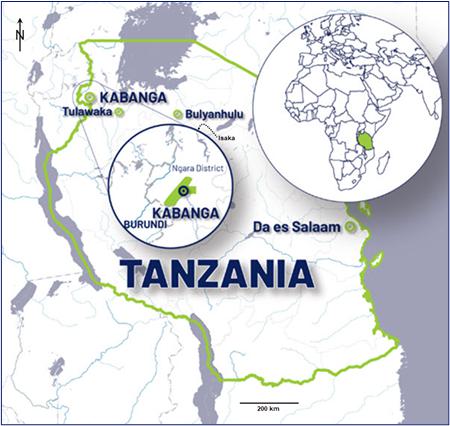
KNL envisages that the Project will comprise an underground mine, processing facilities, and supporting infrastructure; all of which will be within the Special Mining Licence (SML).
Figure 3.2 – Local Area Plan
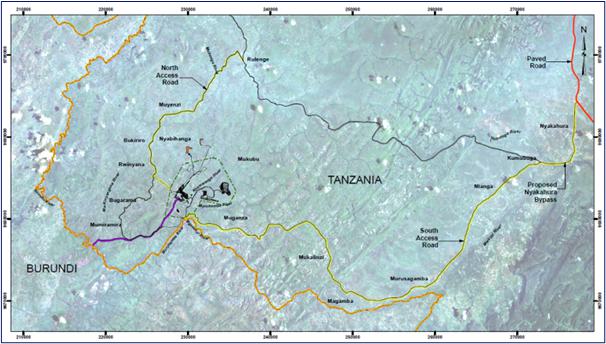
The relationship between Lifezone Holdings Ltd (LHL) and the operating entities that will manage the Project are shown in Figure 3.3.
The Project is 84% owned and operated by Kabanga Nickel Ltd (KNL), with the remaining 16% held by the Government of Tanzania under the terms of a framework agreement.
KNL is jointly owned by LHL (83%) through its 100% entity, Lifezone Limited, with the remaining 17% directly owned by BHP Billiton (UK) DDS Limited (BHPB).
For Mineral Resource reporting, the LHL direct ownership share is 69.713% of the in situ mineralisation after excluding the shares of the Government and the direct BHPB ownership.
Figure 3.3 – Lifezone and Kabanga Nickel Group Structure
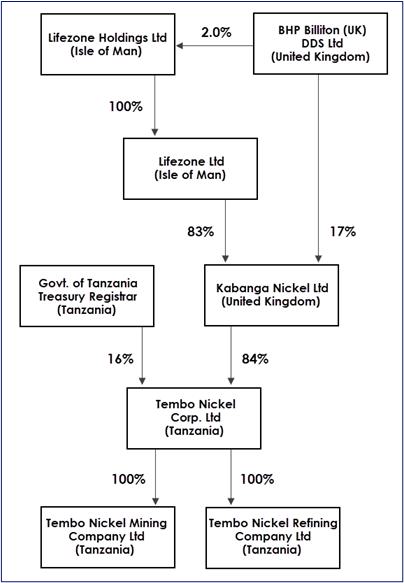
| 3.3 | Tanzanian Mining Sector Legislation |
In Tanzania, mineral rights are held in the form of prospecting licences and mining licences. There are several types of prospecting licences and mining licences, depending on the nature of the minerals being mined and the size of the mine. A Special Mining Licence (SML) is the type of licence required for large-scale mining operations (‘large-scale’ being defined as those projects requiring a capital investment not less than $100 million), therefore this is the type of licence required for the Kabanga project.
Associated with each SML is an Investor–State Framework Agreement (Framework Agreement) between the holder of the SML and the Government. This Framework Agreement includes clauses on the conduct of mining operations, the grant of the Government free carried interest and State participation in mining, and the financing of any mining operations.
Mining legislation requires observance of environmental legislation. Mining licences cannot be granted without an environmental approval certificate being in place. After mining licences are approved, several secondary permits are required for activities that could impact on people and the environment.
Under modern Tanzanian legislation, mineral rights do not confer surface rights. Surface rights were strengthened with the passing of the Land Act 1999, and the Village Act 1999, and application of these Acts to the mining sector was enhanced by the Mining Act 2010.
| 3.3.2 | Primary Mining Sector Legislation |
Mining legislation in Tanzania has changed considerably in recent times. A period of nationalisation initiated in the 1960s was followed by a period of liberalisation in the 1990s. In the last two decades, there has been ongoing strengthening of the role of State actors in governing investments in the mining sector. Recent changes to legislation provide for State partnerships with investors and measures to maximise the socio-economic benefits of mining for Tanzania, (Pederson et al, 2016, and Jacob et al, 2016). The Framework Agreement described above is a product of these more recent changes.
The Mining Act 2010 introduced provisions to meet the following objectives:
| § | Increased integration of the mining sector with other sectors of the economy, |
| § | Increased contribution of the mining sector to the gross domestic product, |
| § | Increased revenue paid to the Government by the mining companies, and |
| § | Increased Government capacity to effectively administer and regulate the sector. |
Further changes to the legal regime governing the mining sector have been made recently to facilitate achievement of these objectives through the enactment of the following laws:
| § | The Tanzania Extractive Industries (Transparency and Accountability) Act 2015 (TEITA Act), |
| § | The Natural Wealth and Resources (Permanent Sovereignty) Act 2017 (Permanent Sovereignty Act), |
| § | The Natural Wealth and Resources Contracts (Review and Re-negotiation of Unconscionable Terms) Act 2017 (Unconscionable Terms Act), and |
| § | The Written Laws (Miscellaneous Amendments) Act 2017 (Miscellaneous Amendments Act). |
The Miscellaneous Amendments Act amends the Mining Act 2010.
New regulations were created under the amended Mining Act 2010 in 2018 and 2019. Changes introduced by the abovementioned Acts and the new regulations are discussed in the following section of this TRS.
| 3.3.3 | Environmental and Social Legislation and Land Legislation |
| 3.3.3.a | Requirements in the Mining Act 2010 and Subordinate Legislation |
The Mining Act 2010 requires that applications for mining licences are accompanied by:
| § | An approval certificate issued in terms of the Environment Management Act, |
| § | A proposed plan for resettlement and compensation of people within the mining areas, |
| § | A plan for procurement plan of goods and services in Tanzania, and |
| § | A plan for employment and training of citizens of Tanzania, coupled with a succession plan for expatriate employees. |
An environmental impact assessment (EIA) process must be followed to obtain the environmental certificate as outlined in the following section on environmental management legislation.
Surface rights and resettlement are covered in Sections 95 to 97 of the Mining Act 2010. From these sections of the Act, mineral rights clearly do not confer surface rights. Restrictions applicable to both mineral rights and surface rights holders are explained as follows:
| § | Holders of mineral rights (mining licence holders) must get permission from landowners and land users to undertake activities on surface. Consultation with the relevant local government authority, including the village council is required, and thereafter, the written consent of the lawful occupier, must be obtained. |
| § | In a mining licence area, lawful occupiers of land must get consent to erect structures in the area from the mining licence holder. The consent cannot be withheld unreasonably. |
| § | Where mining development necessitates displacement of occupiers of land, a resettlement and compensation plan must be developed and implemented. The plan must observe procedures defined under the Land Act and Village Act, including procedures for determining fair and reasonable compensation. |
The Mining Act 2010 requires that each mine has an environmental management plan (EMP), and a closure plan, and that mineral wastes are managed as provided for in the EMP and relevant regulations. It also requires that the abovementioned plans and licence conditions are implemented. Furthermore, it provides for posting of a rehabilitation bond to finance the costs of rehabilitating and making safe the mining area on termination of mining operations if the holder of the SML fails to meet obligations.
The Mining (Safety, Occupational Health, and Environmental Protection) Regulations 2010 (Mining Regulations 2010) require mine closure plans to be submitted by applicants for a SML and for posting of adequate financial assurance for mine closure by holders of SML. Closure-related topics in the regulations include land productivity (Regulation 198), physical stability (Regulation 199), national heritage (Regulation 200), reclamation of mine facilities (Regulations 201 and 204), monitoring (Regulation 205), mine closure plan (Regulation 206), and posting of a rehabilitation bond (Regulation 207).
The closure plan must be updated regularly and must also be reviewed, deliberated, and approved by the National Mine Closure Committee. This committee is convened by the Ministry of Mines. It must include representatives of ministries responsible for the management of the environment, land use and natural resources. It must also include regional and district authorities.
Rehabilitation bonds can be in the form of an escrow account, capital bond, insurance guarantee bond, or bank guarantee bond. The bond will be coupled with an agreement between the mining licence holder and the Government.
| 3.3.3.b | Legislation Relevant to Surface Rights and Resettlement |
Surface rights and resettlement are addressed in Sections 95 to 97 of the Mining Act 2010.
The Mining Act 2010 has two provisions for compensation of surface land rights holders:
| § | Entitlement to compensation for disturbance or damage during operations (Section 96), and |
| § | If compulsory acquisition of land becomes necessary, mining companies are required to ensure smooth implementation of a plan on compensation, relocation, and resettlement of the owners or occupiers of the land before commencement of any mining operations (Section 97). |
The Mining Act 2010 is specific on compensation for compulsory land acquisition and requires this to be settled under guidance from the Land Act and the Village Land Act, (Jacob et al, 2016).
| 3.3.3.c | Environmental Management Legislation |
The regulatory authority responsible for environmental management in Tanzania is the National Environment Management Council (NEMC), which falls under the jurisdiction of the Vice President’s Office. The Environmental Management Act 2004 covers EIA requirements for new developments, environmental management, pollution prevention and control, waste management, environmental quality standards, and public participation in environmental decision making.
The Environmental Management Act requires an applicant for mineral rights to undertake an EIA to inform the decision on approval of their project. The supporting EIA and Audit Regulations 2005 elaborate on EIA procedure to the followed, the form and content of EIA reports, the review process, decision-making processes, and appeals. An activity listed in the first schedule of the EIA and Audit Regulations 2005 cannot proceed without first obtaining the necessary licence from the relevant licensing authority (line ministry, which is the Ministry of Minerals in the case of the mining industry). The licensing authority cannot issue a licence without having first received an EIA certificate from the NEMC.
Safe decommissioning, site rehabilitation, and ecosystem restoration before closure of an operation and environmental performance bonds are provided for in Section 102 of the Environmental Management Act 2004. In practice, NEMC does not require a separate bond to be posted under this provision if provision has been made under the Mining Act.
| 3.4 | Framework Agreement Summary |
The Kabanga Framework Agreement is focussed on equitable economic benefit sharing according to the principles included in Article 3 of that agreement. It recognises the formation of a Joint Venture Company (JVC) that is called Tembo Nickel Corporation Limited (TNCL), which has two subsidiaries – Tembo Nickel Mining Company Limited, and Tembo Nickel Refining Company Limited. TNCL is referred to as both ‘JVC’ and ‘Tembo Nickel Corporation Limited’ in the Framework Agreement and in the SML. As is required under the Miscellaneous Amendments Act 2017, which amends the Mining Act 2010, the Framework Agreement:
| § | Provides for the Government to have a 16% non-dilutable, free-carried share interest in the capital of TNCL (with the remaining interest being held by KNL), |
| § | Includes royalties on the gross value of minerals to be paid at a rate of 6%, where ‘gross value’ means the market value of minerals determined through valuation as defined in the Miscellaneous Amendments Act 2017. The Government can reject the valuation if it is low due to market volatility and can buy the minerals at the low value ascertained, |
| § | Requires beneficiation of mineral products of operations in country, and |
| § | Includes requirements to procure goods and services locally. |
In addition to royalties, the Framework Agreement elaborates on other taxes, fiscal levies, and funding mechanisms that will apply, notably:
| § | An inspection fee of 1% of gross revenue, |
| § | A service levy of 0.3% of gross revenue, |
| § | Non-deductibility of royalty for the calculation of corporate income tax, |
| § | Corporate income tax of 30%, |
| § | Indefinite carry-forward of losses but with the ability to offset against taxable income in any given tax year subject to a cap of 70% of the taxable income in a given tax year, |
| § | Application of straight-line pooled asset depreciation at a rate of 20% per annum, and |
| § | The ability for KNL to lend funding to TNCL through shareholder loans at an interest rate of zero percent. |
The beneficiation facility in the Framework Agreement is referred to in that agreement as a ‘Multi-purpose Mineral Processing Facility’ (MMPF, or multi-metal mineral processing facility), and its purpose is stated as ‘processing, smelting and refining of nickel and other mineral concentrates’, albeit that it should be noted that no smelting is envisaged in this project as all metal extraction will utilise a hydrometallurgical process. TNCL will manage the operations of the mine and the MMPF through subsidiaries, while the Government will assist TNCL in acquiring suitable land for the construction of the MMPF within the vicinity of Kahama township. KNL is required to oversee the construction of the MMPF at Kahama and to prepare the requisite reports on Kabanga, including feasibility studies for the mine and the MMPF and the corresponding EIAs required by law.
The Framework Agreement states that upon granting of the SML, TNCL (or any relevant subsidiary) will begin the process of identifying a physical location for the MMPF with the Kahama region being the initial priority location to assess given the beneficial infrastructure advantages. Upon confirmation of site identification, JVC (or any relevant subsidiary) may submit an application for a Refining Licence for the MMPF.
The Framework Agreement requires that the management of JVC’s operations is carried out in Tanzania, with a focus on engaging local talent to maximise employment of Tanzanians, including: preference for Tanzanian nationals to be appointed to management positions within the JVC, and implementing a local procurement plan that emphasises spending in Tanzania, except where goods or supplies are not available in Tanzania (or on commercially viable or competitive terms in Tanzania) or supplies are permitted to be procured from sources outside Tanzania as provided for under relevant laws.
The Framework Agreement contains a number of schedules. These schedules provide a process for the establishment of the various legal entities, shareholder agreements, and importantly a series of timebound undertakings to facilitate the development of the Project.
| 3.5 | Special Mining Licence |
Following the signing of the Framework Agreement on 19 January 2021, the Government, on 25 October 2021, granted a Special Mining Licence (SML) No. SML 651 / 2021 to Tembo Nickel Corporation Limited (JVC) for the Project.
The SML confers to JVC the exclusive right to search for, mine, dig, mill, process, refine, transport, use, and/or market nickel or other minerals found to occur in association with that mineral, in and vertically under the SML area, and execute such other works as are necessary for that purpose.
The SML shall remain valid for a period of the esteemed life of the ore body indicated in the feasibility study report or such period as the applicant may request unless it is cancelled, suspended, or surrendered in accordance with the law.
The SML requires JVC to strictly observe the mining laws, in particular but not limited to, the recognition that all mineral data and exploration information over the licence area is the property of the United Republic of Tanzania and must be submitted to the Geological Survey of Tanzania in accordance with the Mining Act.
Conditions of the SML include:
| § | Submission of a Feasibility Study to the Mining Commission. |
| § | An update of the proposed plan for compensation, relocation and resettlement and submission to the Mining Commission. |
| § | An update of the environmental management plan and submission to the Mining Commission. |
| § | Preparation of an annual social responsibility plan agreed by the relevant government authorities. |
| § | The commencement of mining activities. |
| § | An undertaking by the JVC to beneficiate in-country. |
| § | The JVC complying with Tanzanian regulations relating to mining operations, financing arrangements and local content. |
| § | The JVC complying with the Statement of Integrity Pledge in accordance with Part VIII of the Mining Act and the Mining (Integrity Pledge) Regulations, 2018. |
With the grant of the SML, JVC agreed to become a strategic partner to the Government, which shall have not less than 16% of the capital of the entity established, to carry out mining activities over the licence area in the form of non-dilutable free-carried interest in accordance with the Mining Act, and subject to the provisions of the Mining Act and of the regulations made thereunder now in force, or which may come into force during the continuance of this licence, or any renewal thereof.
The SML at Kabanga is within the geographical district of Ngara in the Kagera region (QDS 29/ 3, 29W/ 4), defined by the vertices coordinates shown in Table 3.1 with an approximate area of 201.85 km2.
A map of the property showing SML 651 / 2021 is provided in Figure 3.4.
Figure 3.4 – Location of the Project showing SML 651 / 2021
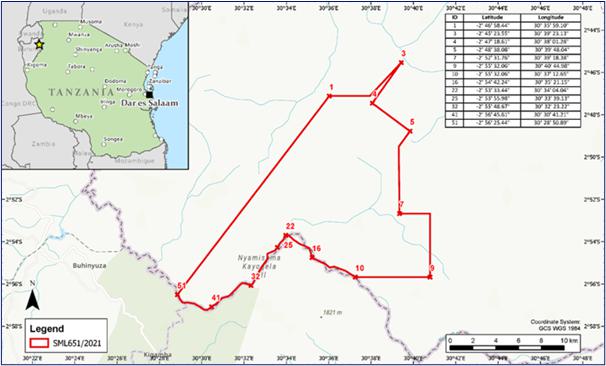
Table 3.1 – Special Mining Licence SML 651 / 2021 Corner Coordinates
TABLE | | |
| Corner | Latitude | Longitude |
| 1 | 02° 46’ 58.44” | 30° 35’ 59.10” |
| 2 | 02° 46’ 58.44” | 30° 37’ 54.17” |
| 3 | 02° 45’ 23.55” | 30° 39’ 23.13” |
| 4 | 02° 47’ 18.61” | 30° 38’ 01.28” |
| 5 | 02°, 48’ 38.08” | 30° 39’ 48.04” |
| 6 | 02° 49’ 21.97” | 30° 39’ 16.01” |
| 7 | 02° 52’ 31.76” | 30° 39’ 18.38” |
| 8 | 02° 52’ 31.76” | 30° 40’ 44.98” |
| 9 | 02° 55’ 32.06” | 30° 40’ 44.98” |
| 10 | 02° 55’ 32.06” | 30° 37’ 12.65” |
| 11 | 02° 55’ 14.27” | 30° 36’ 45.37” |
| 12 | 02° 55’ 02.41” | 30�� 36’ 13.34” |
| 13 | 02° 55’ 04.78” | 30° 36’ 00.29” |
| 14 | 02° 54’ 55.29” | 30° 35’ 48.43” |
| 15 | 02° 54’ 42.24” | 30° 35’ 37.75” |
| 16 | 02° 54’ 42.24” | 30° 35’ 21.15” |
| 17 | 02° 54’ 36.31” | 30° 35’ 10.47” |
| 18 | 02° 54’ 12.59” | 30° 35’ 03.35” |
| 19 | 02° 54’ 03.10” | 30° 34’ 49.12” |
| 20 | 02° 53’ 58.35” | 30° 34’ 36.07” |
| 21 | 02° 53’ 46.49” | 30° 34’ 18.28” |
| 22 | 02° 53’ 33.44” | 30° 34’ 04.04” |
| 23 | 02° 53’ 33.44” | 30° 33’ 55.74” |
| 24 | 02° 53’ 46.49” | 30° 33’ 48.62” |
| 25 | 02° 53’ 55.98” | 30° 33’ 39.13” |
| 26 | 02° 54’ 07.84” | 30° 33’ 32.02” |
| 27 | 02° 54’ 16.14” | 30° 33’ 26.09” |
| 28 | 02° 54’ 25.63” | 30° 33’ 03.55” |
| 29 | 02° 54’ 41.06” | 30° 33’ 03.55” |
| 30 | 02° 55’ 02.41” | 30° 32’ 48.13” |
| 31 | 02° 55’ 19.01” | 30° 32’ 38.64” |
| 32 | 02° 55’ 48.67” | 30° 32’ 23.22” |
| 33 | 02°, 55’ 55.79” | 30° 32’ 17.29” |
| 34 | 02° 55’ 51.04” | 30° 32’ 04.24” |
| 35 | 02° 55’ 48.67” | 30° 31’ 52.38” |
| 36 | 02° 55’ 55.79” | 30° 31’ 44.07” |
| 37 | 02° 56’ 07.65” | 30° 31’ 33.40” |
| 38 | 02° 56’ 15.95” | 30° 31’ 23.91” |
| 39 | 02° 56’ 25.44” | 30° 31’ 15.60” |
| 40 | 02° 56’ 31.37” | 30° 30’ 55.44” |
| 41 | 02° 56’ 45.61” | 30° 30’ 41.21” |
| 42 | 02° 56’ 56.28” | 30° 30’ 25.78” |
| 43 | 02° 57’ 04.58” | 30° 30’ 13.92” |
| 44 | 02° 57’ 04.58” | 30° 30’ 04.43” |
| 45 | 02° 56’ 55.09” | 30° 29’ 50.20” |
| 46 | 02° 56’ 47.98” | 30° 29’ 37.15” |
| 47 | 02° 56’ 44.42” | 30° 29’ 19.36” |
| 48 | 02° 56’ 44.42” | 30° 29’ 09.87” |
| 49 | 02° 56’ 44.42” | 30° 29’ 03.94” |
| 50 | 02° 56’ 36.12” | 30° 28’ 56.82” |
| 51 | 02° 56’ 25.44” | 30° 28’ 50.89” |
| 52 | 02° 56’ 21.88” | 30° 28’ 48.52” |
| 3.6 | BHPB Investment in Kabanga Nickel Limited |
The following summary of the commercial arrangement between LHL and BHP Billiton DDS Limited (BHPB) has been prepared by LHL.
LHL and BHPB have three agreements: T1A, T1B, and T2.
KNL entered into a loan agreement with BHPB dated 24 December 2021, pursuant to which KNL received investment of $40 million from BHPB by way of a convertible loan. Following receipt of approval from the Tanzanian Fair Competition Commission and the fulfilment of the other conditions, such convertible loan was converted into an 8.9% equity interest in KNL on 1 July 2022.
KNL entered into an equity subscription agreement with BHPB dated 14 October 2022 (the T1B Agreement). All the conditions precedent of the T1B Agreement were satisfied or waived on or before 8 February 2023 and, in accordance with the T1B Agreement, BHPB subscribed $50 million for an additional 8.9% equity interest in KNL on 15 February 2023, giving BHPB a total equity interest in KNL of 17% (the T1B Investment)
The T1B Investment proceeds will be used for the ongoing funding requirements of the Project in accordance with a budget agreed between KNL and BHPB.
KNL and Lifezone Limited entered into an option agreement with BHPB dated 14 October 2022 pursuant to which KNL will (at BHPB's option) receive investment from BHPB by way of an equity subscription. The option grants BHPB the right, subject to certain conditions, to subscribe for the required number of KNL shares that, in aggregate with its existing KNL shareholding, would result in BHPB indirectly owning 51% of the total voting and economic equity rights in TNCL on a fully diluted basis as at closing at a price to be determined through an independent expert valuation. If exercised as at the date of the agreement, the option would result in BHPB owning 60.71% of the total voting and economic equity rights in KNL on a fully diluted basis.
BHPB may (at its sole option) deliver a maximum of one valuation notice to KNL and Lifezone Limited requiring the commencement of a valuation process in respect of KNL during the period which shall:
| § | Commence on the later of the date on which: |
| - | (i) the feasibility study relating to the Kabanga project is agreed (or finally determined) between BHPB and KNL (the Feasibility Study Agreement Date); and |
| - | (ii) the Joint Financial Model in respect of the Kabanga Project is agreed between BHPB and KNL, or such earlier date as the parties may agree in writing, and |
| § | End on the date falling 30 calendar days after the later of: |
| - | (i) the Feasibility Study Agreement Date; and |
| - | (ii) the date on which the Joint Financial Model is agreed between BHPB, KNL, and the Government of Tanzania. |
The investment is subject to certain conditions, including the receipt of approval from the FCC.
The proceeds of the investment shall be used for the ongoing funding requirements of the Kabanga project.
| 3.7 | Mineral Rights, Surface Rights, and Environmental Rights |
This section was prepared by LHL.
Under the Framework Agreement described above, the Government is committed to working with TNCL to facilitate the acquisition of the necessary mineral and surface rights and also the environmental approvals required in Tanzania.
TNCL will need to acquire surface use rights for up to 4,300 ha of land in order to develop the Project. The Project will trigger both physical and economic displacement of households across the different villages that have administrative control over land within the Project area boundary. A Relocation–Resettlement Action Plan (RRAP) was produced for the Project in 2013, which also serves as the foundational Resettlement Policy Framework (RPF) to guide any further Project components that might result in displacement. According to the RRAP, a Resettlement Working Group (RWG) was established in 2007, and consultations were initiated with impacted households and local government authorities to collectively develop the resettlement strategy.
The RRAP was submitted to the Government as part of the application for a SML and TNCL now needs to apply for Granted Rights of Occupancy to the area. Resettlement is discussed further in Section 17.7.4.
An EIA certificate (EC/EIS/824) for the mine was granted in 2013 based on the EIA process, and report completed in 2013. The certificate, originally granted to KNCL, was transferred to TNCL on 16 June 2021.
The transfer certificate specifically states that the project’s objective is ‘mining, processing and refining of class 1 nickel with cobalt and copper co-products’. The EIA certificate requires compliance with the environmental management plan (EMP), which is in the process of being updated.
| 3.8 | Other Significant Factors and Risks |
KNL has advised that there are no other known significant risks that may affect access, title or the right or ability to perform mining related work at the Project.
Legal matters such as statutory and regulatory interpretations affecting the mine plan and environmental matters are outside the expertise of the QP (see Section 25). The 2023MRE QP considers it reasonable to rely on KNL because KNL employs professionals with responsibility in these areas and these personnel have the best understanding of these areas.
Following a review of the current supplied information, the opinion of the QP is that the current plans appear adequate to address any known issues related to environmental compliance, permitting, and local individuals or groups.
| 4 | Accessibility, Climate, Local Resources, Infrastructure, and Physiography |
| 4.1 | Topography, Elevation, and Vegetation |
The SML lies in the Ruvubu river sub-watershed of the Kagera river, a major river that flows into Lake Victoria. The Ruvubu river, which originates in Burundi and flows in a general northerly direction, defines a portion of the international boundary between Tanzania and Burundi near the Project area. Thereafter, the Ruvubu river continues northwards through Tanzania, and joins the Kagera river at the international boundary with Rwanda, and then flows north, and then east to Lake Victoria.
The local terrain is dominated by a rocky ridge (the Rubona Ridge) that trends in a north–north- east direction through the Project area at an elevation in excess of 1,640 metres above sea level (masl). Adjacent landforms comprise sloping plateaux dissected by numerous streams, along with valley bottom lands associated with the Nyamwongo and Muruhamba rivers and the lower reaches of their tributary streams. The adjacent valleys, of the Nyamwongo, and Muruhamba rivers to the east, and the Mu Kinyangona and Muhongo rivers to the west, lie approximately 150–200 m below the elevation of the Project ridge. These rivers discharge into the Ruvubu river.
There is a long history of subsistence agriculture in the area that has contributed to a highly modified landscape with few mature trees and limited wildlife. Although Tanzania is known internationally for its large wild game reserves and parks and diversity of wildlife, the area of Tanzania local to the Project is largely devoid of large mammals. The most numerous types of fauna identified during the EIA included reptiles, birds, and small rodents. All plant communities identified during the EIA have been affected to some degree by human activity.
Much of Rubona Ridge is too rocky and/or too steep to support sustained agricultural use but is used for grazing, collection of wood, fruit, and beekeeping. Grasslands with some wooded areas and sparse shrubs cover the sloping plateau lands that support wet season cultivation of maize, cassava and bananas, and some grazing of cattle. The valley bottom lands support more intensive dry season cultivation, primarily of beans and other vegetable crops. Extensive papyrus growth exists on valley bottom lands that are too wet for cultivation. There is little soil erosion in the Project area reflecting the low-intensity use of the land. The high concentration of total suspended solids in rivers and streams during the wet season is a result of cultivation to the edge of the local rivers and streams.
Within the Project area, domestic water supplies are typically obtained from the small tributary streams, from springs on the ridge and from shallow dug wells in the valley bottom lands. The rivers are not used for domestic water supply.
The Project is located approximately 25 km (via unpaved road) from Rulenge, which is a further 50 km away from the district capital of Ngara. Ngara is connected by a paved trunk road to Dar es Salaam, (approximately 1,300 km to the south-east), and to Burundi (approximately 40 km to the south-west) (see Figure 3.2).
The proposed mine site is accessible by road connecting to the National Route B3 at Muzani. Three potential access routes have been identified: northern, central, and southern, with the southern route currently preferred due to the shorter distance (approximately 80 km to Muzani) and having the lowest environmental and social impact. This is presently a dirt road prone to rutting in the rainy season and occasional flooding in at least two places, and a study is underway to assess alternatives to upgrade and seal this road.
There is a railway from Dar es Salaam to Isaka, which is currently being upgraded and rehabilitated. From Isaka to site is approximately a further 350 km.
The Project area is located in the moist sub-humid climate zone of east-central Africa, which is dominated by monsoonal weather patterns. The long-term average annual rainfall in the Project area is 1,013 mm with most of this falling during the wet season between November and April.
The wettest months are March and April with average precipitation amounts of 146 mm and 172 mm, respectively. The driest months are June and July when the monthly rainfall typically drops below 10 mm. Much of the rain falls as high-intensity events. These events heavily influence stream flows, flood frequency, soil erosion rates, and water infiltration rates. Evapotranspiration within the Project area is approximately 92% of the average annual rainfall.
The average annual air temperature within the Project area is 20°C, with an average monthly variation of 2°C and a normal daytime temperature variation of approximately 8°C. The annual average relative humidity is 66% with the lowest humidity occurring between June and October.
| 4.4 | Infrastructure / Services |
Infrastructure in the Ngara district is limited in terms of national grid power and reticulated potable water supplies. A transmission line and sub-station from a new hydroelectric project to the north-west of Tanzania is within 70 km of the Project site and an extension of the 200kV line to the project is planned within the development time of the Project.
The KNL camp, which was on care and maintenance from 2015 through 2020, is in an overall good state of repair. It comprises buildings for administration and security, geology and technical services, community relations, canteen, clinic, workshops, staff housing, and dedicated spaces for sample and core storage (located both within the confines of the camp and one large overflow area to the north-west of the camp).
Power is supplied by diesel generators located on site. Water is provided by a borehole located 900 m to the north-west of the camp, near the summit of the hill.
Figure 4.1 – KNL Camp

The camp facilities shown in Figure 4.1 are:
| A. | Administration and Security Office | | B. | Geology Office |
| C. | Community Relations Office | | D. | Meeting Hall |
| E. | Canteen | | F. | Clinic |
| G. | Workshop | | H. | Generators |
| I. | Diesel tanks | | J. | Recreation Hall |
| K. | Gym | | L. | Main Gate |
One of the legacies of Tanzania’s post-colonial socialist heritage is a highly organised system of administration which extends down to the village level. Tanzania has six formal levels of government, from the national level via the district level and down to the village level. Much of the planning and administration for Ngara district is handled at the district level.
Financial and human resources for district level facilities are limited, and there are difficulties in attracting and retaining qualified and experienced staff in Ngara district. Despite resource shortfalls, the local government system is functional and all of the 15 villages adjacent to the Project have at least one primary school, all wards have secondary schools, and most villages and wards have health facilities.
Exploration at Kabanga has been undertaken in a number of different phases for over 45 years, with more than 598 km of drilling having been completed in total (to 31 December 2022).
The first drilling on the deposit was undertaken between 1976 and 1979 by the United Nations Development Program (UNDP), as part of a regional targeting for ultramafic bodies to identify nickel sulfide and nickel laterite mineralisation within the East Africa nickel belt (EANB) in Tanzania and Burundi. These holes intersected five separate mafic–ultramafic bodies over a 7.5 km strike length and resulted in the delineation of an Indicated Mineral Resource for the Main zone. The UNDP work delineated another 48 geochemical stream anomalies and 30 magnetic / radiometric anomalies.
Work on the Project was stopped in 1979, with the outbreak of hostilities between Tanzania and Uganda. Following a 10-year government moratorium on further exploration, Sutton Resources Ltd (Sutton) negotiated the mineral rights to the deposit and formed KNCL in 1990.
Initial work on the Main zone was expanded in 1992 to include the Kagera licence to the north-west, with the formation of a JV with BHP. Drilling of the resource continued, and by the end of 1995, when BHP exited the KNCL JV, the Main zone Indicated Mineral Resource, stood at 5.95 Mt at 1.16% Ni, and the North zone was reported to contain an Indicated Mineral Resource of 4.18 Mt with a mean grade of 2.21% Ni.
After the withdrawal of BHP, Sutton, and Anglo American Corporation (Anglo) signed a JV agreement on both properties in July 1997. Drilling commenced in October 1997 following refurbishment of the Kabanga camp. The initial focus of this drilling campaign was to extend the North zone high-grade massive sulfide resource, which appeared to be open at depth to the north.
In April 1998, after drilling a total of 53 holes, the North zone resource was estimated at 14.3 Mt at 2.56% Ni.
In 1999, Barrick, through its purchase of Sutton Resources, gained control of Bulyanhulu and other gold properties, thereby becoming ground holders at Kabanga and JV partners with Anglo.
Anglo withdrew from the project in 2000. Barrick recommenced exploration of the down dip extension of the North zone massive sulfide body. Drilling in January 2001 intersected mineralisation at depth, which appeared to be separate from North zone, and similar in style to the Main zone mineralisation. This zone was named MNB.
Drilling through to 2002 focussed on the North zone, extending the massive sulfide body to the north. Deep drilling below the North zone (1,500–1,700 m below surface) intersected massive sulfide mineralisation that is now interpreted to be part of the Kima zone.
In 2003, Barrick completed a scoping study that was largely based on its work with Anglo. The study used a model generated in 2002 based on drilling undertaken up to the end of 2001.
In 2005, Barrick issued a press release announcing a signed JV partnership with Falconbridge Limited, in the press release Barrick also publicly released an Inferred Mineral Resource estimate for Kabanga of 26.4 Mt grading 2.6% Ni, representing the sum of the Main and North zone models from 2003.
A total of 64,957 m in 127 drillholes was completed for the scoping study Phase I between January 2005 and March 2006. Work focussed on verifying and infilling the resource models at Main, North, and MNB zones.
Borehole electromagnetic (BHEM) surveys with physical properties were completed, SQUID and Fixed Loop TEM surface geophysical surveys, as well as an airborne helicopter VTEM Survey were conducted to characterise the zones and explore the surrounding area. Collection of metallurgical samples was undertaken between April 2005 and the end of July 2005. A total of 2,908 kg of sample was shipped for metallurgical testing. Five geotechnical holes at proposed infrastructure sites were drilled.
In 2006, a total of 81,256 m in 148 drillholes was completed. This programme was designed to continue to improve the confidence of the resource and discover additional shallow, large tonnage mineralisation required to improve the project’s economics. Further metallurgical sample was also required for preliminary grinding / flotation testing at XPS in Canada. Work focussed on verifying and infilling the resource models in North and MNB zones. A total of 2,600 kg of sample was shipped to the Falconbridge Technology Centre for metallurgical testing. Resource models were generated for each of Main, MNB, North, and Tembo zones.
A total of 242,347 m in 555 drillholes was completed for the prefeasibility study between the December 2006 and November 2008. This exploration programme was designed to continue to improve the confidence of the North and Tembo resources and discover additional resources to improve the project’s economics within 15 km trucking distance of planned mine infrastructure. Further metallurgical samples were also required for two pilot plant test runs. During 2007, the Kima massive sulfide zone was discovered to underlie the lower portion of the North zone.
Regional exploration drilling tested seven high priority regional exploration targets at Bonde, Nyoka, Jabali, Balima, Kilimanjaro, Safari, and Nyundo (Keza-3). In November 2007, massive sulfide mineralisation was intersected at the Safari target with the discovery hole grading 1.88% Ni over 10.1 m drilled width.
Resource estimates were reported for the June 2008 models in the 2008 Xstrata Nickel annual report.
From December 2008 through August 2009 a total of 21,368 m of drilling was completed. The drilling programme was successful in transferring an estimated 2.8 Mt in the North Mid area from Inferred to Indicated status. An independent consultant performed both a QA/QC audit and a resource audit.
From 2010 through 2014, extensive geological / geophysical interpretation was carried out over the Kabanga licence area, coupled with assaying of non-sampled historical BHP / Anglo holes in the Main zone area, and led to the development of several high-tenor nickel targets in the southern part of the Project area. Regional exploration work in the post-feasibility study period was confined to geological mapping over regional licences and establishing access routes for planned 2011 programmes. Subsequent drilling in 2014 was limited to four holes, which were drilled testing two new target areas and an additional two holes were drilled into the Tembo North mineralisation.
In December 2021, KNL recommenced activities after the granting of SML 651 / 2021. Two diamond drilling campaigns have been conducted over SML 651 / 2021 by KNL to date, as follows:
| § | December 2021 to May 2022: 4,163 m of drilling in 14 holes to provide 2,727 kg of metallurgical sample (in three bulk samples) from the North and Tembo zones for hydrometallurgical test work in Perth, Australia. |
| § | May 2022 to 31 December 2022: 7,843 m of infill drilling in 23 holes at Tembo North to increase confidence in this zone over a 700 m strike length, and to provide an additional bulk sample (464 kg) for hydrometallurgical test work in Perth, Australia. An additional 768 m in one drillhole was completed at the Safari prospect. |
The KNL drilling is yet to be incorporated into the Mineral Resource database, therefore is currently not considered in the discussion of the Mineral Resources.
| 6 | Geological Setting, Mineralisation, and Deposit |
| 6.1 | Regional Geological Setting |
Geologically, the Kabanga nickel deposit is located within the East African Nickel Belt (EANB), which extends approximately 1,500 km along a north-east trend that extends from Zambia in the south-west, though the Democratic Republic of Congo (DRC), Burundi, Rwanda, Tanzania, and Uganda in the north-east, and straddles the western boundary of the Tanzania Craton to the east, and the eastern boundary of the Congo Kasai Craton to the west.
In the northern and central sections of the EANB, a thick package of Paleoproterozoic to Mesoproterozoic metasedimentary rocks, known as the Karagwe–Ankole Belt (KAB), overlies this boundary, within which occurs a suite of broadly coeval, bimodal intrusions, (Evans et al, 2016). These igneous rocks correspond to the Mesoproterozoic Kibaran tectonothermal event between 1,350 to 1,400 Ma, (Kokonyangi et al, 2006; Tack et al, 2010).
The KAB has been divided into several broad domains, (Tack et al, 1994):
| § | An Eastern Domain (ED) that is characterised by lower degrees of metamorphism and tectonism and the absence of Kibaran-aged granite magmatism, |
| § | A Western Domain (WD) characterised by higher degrees of metamorphism and polyphase deformation and the voluminous Kibaran granite intrusion, and |
| § | A Transitional Domain (TD) between the other two domains, which is marked by a north-east trending line of mafic–ultramafic intrusions known as the Kabanga–Musongati Alignment (Tack et al, 1994). |
The sedimentary rocks of the ED and WD form uncorrelated and distinct sub-basins, both comprising alternating arenaceous and pelitic rocks, including quartzites, schists, greywackes, and conglomerates developed in long-lived, shallow-water intracratonic and pericontinental basins, (Fernandez-Alonso et al, 2012).
The Kibaran igneous rocks comprise mafic–ultramafic intrusions, including well-differentiated lopolithic layered intrusions and small, narrow, tube-like sills, often concentrically zoned, called chonoliths. The nickel zones discovered to date have exclusively been found associated with the mafic–ultramafic intrusions, in particular, along the Kabanga–Musongati Alignment, (Deblond and Tack, 1999; Evans et al, 2000). Felsic intrusions occur coeval with the mafic–ultramafic intrusions. Recent ages (U-Pb zircon SHRIMP) from Kabanga date the marginal mafic rocks of the intrusion at 1,403 ± 14 Ma, (Maier et al, 2007).
Figure 6.1 shows a stratigraphic column of the regional geology of the area.
Figure 6.1 – Stratigraphic Column for the Kagera Supergroup
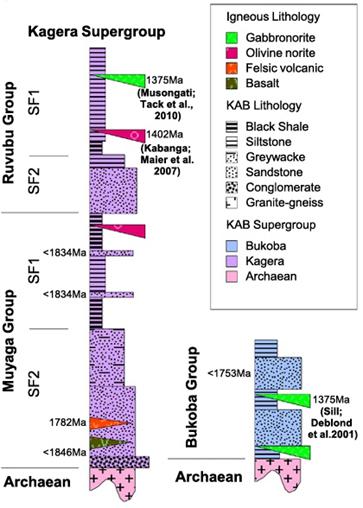
KNL, 2023 (modified from Fernandez Alonso et al. (2012), and Koegelenberg et al. (2015))
The intrusions that host the known potentially economic nickel-bearing massive sulfide zones in the Project area, namely North, Tembo, Main, and MNB, are found within steeply dipping overturned metasediments (dipping 70° to 80° to the west), with a north–north-east strike orientation (025°) from Main to North zone, changing to a north-east strike orientation (055°) from North to Tembo. The zones are located within, and at the bottom margin of, the mafic–ultramafic chonoliths. The chonoliths are concentrically zoned with a gabbronorite margin and an ultramafic cumulate core zone that ranges in composition from sulfidic dunite, plagioclase-peridotite, orthopyroxenite, to olivine melanorite, (Evans et al, 2000).
The metasediments comprise approximately 90% metapelites and metasandstones, with the remainder comprising clean arenitic metasandstones or quartzites, (Evans et al, 2016). Lenses and bands of iron sulfides (up to 5% modal of pyrrhotite) and graphite are common in the more pelitic rocks, and it has been demonstrated that the sulfur within the different zones has similar isotopic signatures indicating significant assimilation of external sulfur from the KAB sediments, (Maier et al, 2010).
| 6.3 | Lithologies and Stratigraphy |
Three lithological groups are present at Kabanga:
| § | Remobilised massive sulfide (>80% sulfide) (MSSX), which carries 90% of the sulfide occurrence and massive sulfide with xenoliths of metasedimentary or gabbro / ultramafic rock (≥50% to 80% sulfides) (MSXI). |
| § | Ultramafic–mafic intrusive complex rocks, which display a wide range of metamorphism / metasomatism. These lithologies can also carry significant sulfide mineralisation, such as in the ultramafic unit termed UMAF_1a (≥30% sulfides, located adjacent to the MSSX, present at Tembo and North). |
| § | Metasediments comprising a series of pelitic units, schists, and quartzites, forming the hanging wall and footwall of the massive sulfide lenses. |
The massive sulfide comprises principally pyrrhotite, with up to 15% pentlandite. Pentlandite shows distinct globular recrystallisation textures and crystals may reach up to 5 cm in size. Accessory sulfides include chalcopyrite and traces of pyrite, galena, arsenopyrite, cubanite, niccolite, cobaltite, and mackinawite.
Typical Main and Tembo zone cross sections displaying the local stratigraphy are shown in Figure 6.3.
Figure 6.2 – Plan View Schematic of Geology of the Kabanga Area
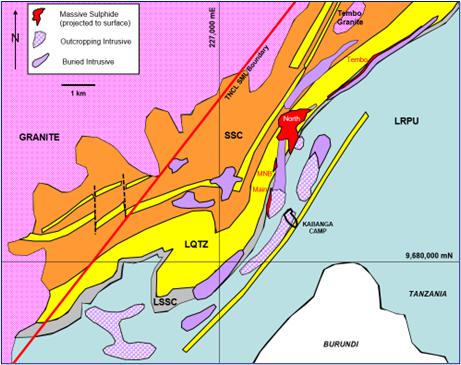
Figure 6.3 – Typical Stratigraphy Cross Section Schematics for North and Tembo
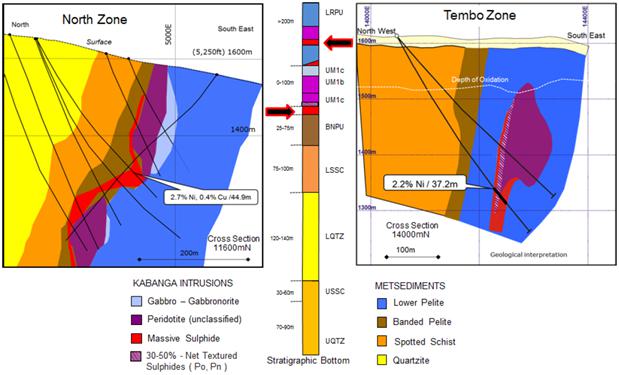
The Kabanga sulfide lenses are thought to have been remobilised within a large shear zone, initially conforming to early-phase folding geometries, and subsequently modified and partitioned by low-angle thrusting and cross-faulting. The Project area has been found to be structurally complex, with five fault sets identified to date. The complexity of the structural setting is best illustrated by the interpreted satellite imagery and a schematic 3D interpretation presented Figure 6.4 and Figure 6.5.
Of note is the existence of an RQD model completed by an independent consultancy (2008–2009) to support the current structural interpretation of the Project area.
Figure 6.4 – Major Structures – Kabanga Sulfide Zones
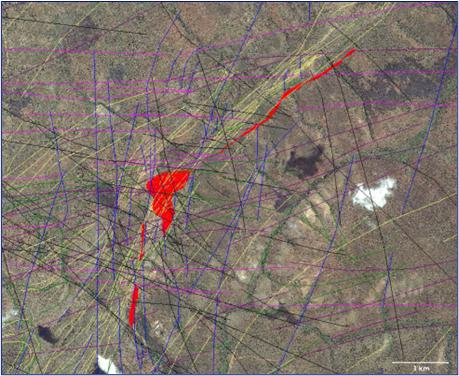
Yellow=Set A; Blue=Sets B and D; Black=Set C; and Purple=Set E
Figure 6.5 – Comparative Interpretation of 3D and 2D VTEM Data
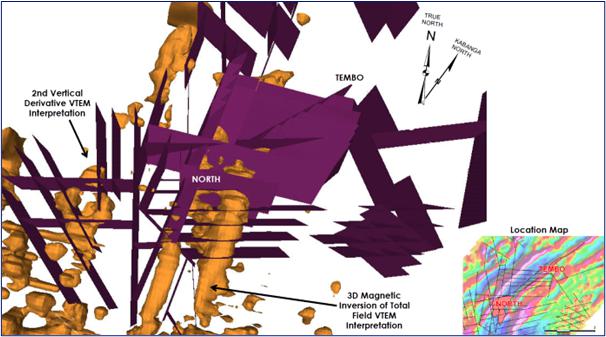
The Project comprises six distinct mineralised zones, namely (from south-west to north-east) Main, MNB, Kima, North, Tembo, and Safari, which occur over a strike length exceeding 7.5 km. The four mineralised zones that contribute to the Mineral Resource estimate (Tembo, North, MNB, and Main), extend over a total strike length of 6 km and for up to 1.3 km below surface.
Figure 6.6 is a projected long-section schematic showing all the mineralised zones identified to date at Kabanga.
Kabanga sulfide mineralisation occurs both as:
| § | Disseminated to net textured interstitial sulfides within the cumulate core zone of the Kabanga chonoliths, as well as externally, and |
| § | Massive and semi-massive bodies along the lower or side margins of the chonolith, that being the contact with the stratigraphic base, (Evans et al, 1999). |
The massive sulfides, defined as having >80% modal sulfide, comprise dominantly pyrrhotite, with trace-to-15% pentlandite, and these account for the vast majority of the Mineral Resource estimates reported in this report. Pentlandite exhibits distinct recrystallisation textures expressed as globules up to 5 cm in diameter. Accessory sulfides include chalcopyrite and trace pyrite, galena, arsenopyrite, cubanite, niccolite, cobaltite, and mackinawite. Remobilised, generally pyrrhotite-rich, massive sulfides also occur as cross-cutting and conformable veins within the ultramafic units.
The tenor composition of the sulfides (as represented by the percentage of nickel in 100% sulfide) ranges from 5% to 6% near the basal margins to 0.5% to 1% in the upper cumulates, (Evans et al, 1999; Maier and Barnes, 2010). Tenor also varies between mineralised zones, generally the smaller intrusive bodies (by cross-sectional area) that occur lower in the stratigraphy, such as North and Tembo, are more richly endowed.
| 6.7 | Alteration and Weathering |
At surface, the ultramafic bodies are completely weathered to saprolite. The depth of oxidation ranges from 40–100 m in the Project area. At North, massive sulfides are weathered to depths of 80–100 m. The Tembo massive sulfide horizon is located 98% in fresh material. In general, nickel laterite formation over the associated ultramafic is weakly developed with minor nickel-bearing serpentine and rare garnierite.
Figure 6.6 – Projected Longitudinal Section Schematic of Kabanga Mineralised Zones

Exploration at Kabanga has been undertaken in a number of different phases spanning over 45 years, with more than 598 km of drilling having been completed in total, 26.8 km of which was on regional targets. This drilling is summarised in Table 7.1.
Table 7.1 – Exploration Drilling Summary
| | | |
| Years | Companies | Metres Drilled | Discovery (purpose) |
| 1976–1979 | UNDP RegionalExploration | 20,068 | Main zone |
| 1991–1992 | Sutton Resources | 12,974 | |
| 1993–1995 | Sutton–BHP JV | 37,947 | North zone |
| 1997–1999 | Sutton–Anglo American JV | 56,227 | |
| 2000–2004 | Barrick Gold Corporation | 39,931 | MNB zone |
| 2005–2008 | Glencore–Barrick Gold JV | 64,957
81,256
242,347 | North Deep zone (scoping study 1)
Tembo Zone (scoping study 2)
Safari / Kima zones (prefeasibility study) |
2008–2009
2011–2012
2014 | Glencore–Barrick Gold JV | 21,368
5,303
3,320 | (Feasibility study) |
| 2021–202 | KNL | 8,611
4,163 | Tembo North (infill) and Safari
Tembo and North (metallurgical |
| Total | | 598,472 | |
| 7.1.1 | Early Regional Exploration |
The first drilling at Kabanga was undertaken between 1976 and 1979 by the United Nations Development Program (UNDP) as part of a regional programme targeting ultramafic bodies to identify nickel sulfide and nickel laterite mineralisation within the EANB in Tanzania and Burundi. This programme of work comprised some 20,068 m of drilling in 61 drillholes on the Kabanga licence area.
The UNDP drilling within the Kabanga licence area intersected five separate mafic–ultramafic bodies over a 7.5 km strike length and resulted in the estimation of a resource for the Main zone of 21.7 Mt grading 0.97% Ni at a 0.5% Ni cut-off grade. Regionally, the UNDP work delineated another 48 geochemical stream anomalies and 30 magnetic / radiometric anomalies. Work on the Project was stopped in 1979 with the outbreak of hostilities between Tanzania and Uganda.
| 7.1.2 | Sutton Era Exploration |
Following a 10-year government moratorium on further exploration, Sutton Resources (Sutton) negotiated the mineral rights to the deposit and formed the Kabanga Nickel Company Limited (KNCL) in 1990. Initial work on the Main zone was expanded in 1992 to include the Kagera licence to the north-west, with the formation of a JV with BHP. In 1993, drillhole KN93-36 was drilled targeting the down-dip extension of a gossanous ridge with associated geophysical anomaly, and intersected a pipe-like ultramafic body, now referred to as North zone, with more than 100 m of massive sulfide mineralisation. KNCL also drilled nine holes in the Main South area, with the best result 2.15 m at 1.2% Ni in hole KN95-99 (Block 1 South), and two holes in the Tembo area without intersecting any mineralisation.
By the end of 1995, when BHP exited the KNCL JV, the Main zone resource, which incorporated the ultramafic-hosted, disseminated and massive nickel sulfide mineralisation, stood at 5.95 Mt at 1.16% Ni, and the North Zone was estimated to contain a resource of 4.18 Mt with a mean grade of 2.21% Ni.
After the withdrawal of BHP, Sutton and Anglo signed a JV agreement on both properties in July 1997. The Kabanga camp was refurbished, and drilling commenced in October 1997.
The initial focus of the campaign was to extend the North zone high-grade massive sulfide resource, which appeared to be open at depth to the north. Little drilling had been completed by BHP below the 1,200 m level (approximately 400 m below surface). A drilling programme of 18,000 m was initially planned, and this was later extended to 26,000 m after continuous mineralisation had been shown to extend to depth. The deepest intersection of the Anglo programme (KN98-45) was 9 m of massive sulfide mineralisation at approximately the 720 m level (800 m below surface).
In April 1998, after drilling a total of 53 holes, the North zone resource was estimated at 14.3 Mt at 2.56% Ni.
Drilling re-commenced in the Main zone in May 1998 and continued until October 1998. The zone was re-modelled, concentrating on the contact massive sulfide mineralisation.
The Sutton and Anglo JV undertook additional drilling in the Block 1 South area (36 holes), and Nyanzali / Luhuma target areas, with low grade (<1% Ni) mineralisation encountered.
| 7.1.3 | Barrick Era Exploration |
In 1999, Barrick, through its purchase of Sutton Resources, gained control of Bulyanhulu and other gold properties, thereby becoming ground holders at Kabanga and JV partners with Anglo. Anglo withdrew from the project in 2000. Barrick recommenced exploration of the down-dip extension of the North zone massive sulfide body. Drilling in January 2001 intersected mineralisation at depth that appeared to be separate from North zone, and similar in style to the Main zone mineralisation. This zone was named MNB.
Initial interpretations suggested a 2 km long body at the base of an ultramafic conduit which could be interpreted as an extension to the Main zone. Drilling through to 2002 focussed on North zone, extending the massive sulfide body to the north with an additional six holes. Deep drilling below the North zone (1,500–1,700 m below surface) intersected massive sulfide mineralisation, which is now interpreted to be part of the Kima mineralised zone. Four exploration holes were completed by Barrick in the area of the Tembo zone without encountering any nickel sulfide mineralisation.
In 2003, Barrick completed a scoping study that was largely based on work completed during the Anglo JV. The study used a model generated in 2002 based on drilling undertaken up to the end of 2001. In late 2003, an updated model was generated by the exploration group to include all holes up to (and including) the 2003 drill programme.
In addition to the main Kabanga licence, Barrick also controlled eight other Prospecting Licence areas at the Project. Reports to the end of 2003 indicate that little work has been conducted on these licences other than litho-geochemical research studies (mafic–ultramafic rocks and gossans) and geochemical surveys (soil and stream sediment). Exploration grids for soil surveys were implemented in 2000 on three licences, where a total of 805 samples were taken. The results of the geochemical soil programmes showed tight linear and coherent nickel, copper, and cobalt anomalies coincident with known occurrences of mafic and ultramafic bodies. Stream sediment sampling (130 samples) was carried out on a regional licence in 2003 to coincide with a reconnaissance mapping programme.
In February 2004, Barrick began negotiations with Falconbridge Limited for a JV partnership. In January 2005, with negotiations still in progress, work resumed on an infill drill programme at Main zone. A total of 10,557 m of drilling had been completed when the JV agreement was signed on 22 April 2005.
In the press release announcing the new JV, Barrick publicly released an Inferred Mineral Resource number for Kabanga of 26.4 Mt grading 2.6% Ni, representing the sum of the Main and North zone models from 2003.
A total of 64,957 m in 127 drillholes was completed for the first scoping study between January 2005 and March 2006. Work focussed on verifying and infilling the mineralisation at Main zone, North zone, and MNB.
Borehole electromagnetic (BHEM) surveys with physical properties were completed in 42 drillholes. SQUID (17.6 km) and fixed loop TEM (12 km) surface geophysical surveys, as well as an airborne helicopter VTEM Survey (2,615 km) were conducted to characterise the mineralised zones and explore the surrounding area.
Collection of metallurgical samples was undertaken between April 2005 and the end of July 2005. A total of 2,908 kg of metallurgical sample was sent for metallurgical testing. Five geotechnical holes at proposed infrastructure sites were drilled.
From April through November 2006, a further 148 holes were drilled for a total of 81,256 m.
BHEM surveys with physical properties were completed in 95 drillholes. Work focussed on verifying and infilling the resource models in North zone and MNB zone.
Fixed loop TEM surface geophysical surveys (327 line-km) were conducted on Kabanga licences proximal to the then-current resource. A high priority, >10k Siemen conductive target was identified 2 km to the north-east of the North zone. This anomaly was located along a magnetic trend, which was also coincident with surface gossan boulders. The anomaly was drill tested and resulted in the discovery of Tembo zone. The significance of this discovery was quickly recognised, resulting in a reallocation of drill metres to the Tembo resource in lieu of the proposed MNB drilling. At the completion of this work, a total of 33,589 m in 71 holes had been completed at Tembo.
Collection of metallurgical samples were undertaken between April and November 2006. A total of 2,600 kg of sample was sent for metallurgical testing.
An exploration programme that was designed to continue to improve the confidence of the North and Tembo mineralisation and discover additional resources to improve the project’s economics within 15 km trucking distance of planned mine infrastructure. This programme commenced in December 2006 and ran from December 2006 through November 2008. Further metallurgical samples were also required for two pilot plant test runs.
A total of 242,347 m in 555 drillholes was completed for this phase of work, of which 121,051 m in 246 holes was located in the North zone, and 105,735 m in 280 holes in the Tembo zone.
BHEM surveys with physical properties were completed in 134 drillholes. During 2007, the Kima massive sulfide zone was discovered beneath the lower portion of the North zone.
In 2007, an additional drill programme that totalled 6,836 m tested 10 target horizons outside the then-current modelled limits. Nickel sulfide mineralisation was intersected in two of the drillholes, which increased the North resource by approximately 125 kt at 2.51% Ni and extended the Kima mineralisation. BHEM surveys were completed in all 2007 holes.
Regional exploration drilling totalled 8,725 m in 19 holes, testing seven high priority regional exploration targets at Bonde, Nyoka, Jabali, Balima, Kilimanjaro, Safari, and Nyundo (Keza-3), along with 16 BHEM surveys. In November 2007, massive sulfide mineralisation was intersected at the Safari zone with the discovery hole grading 1.88% Ni over a 10.1 m as drilled width.
Resource estimates were reported for the June 2008 models in the 2008 Xstrata Nickel annual report.
From December 2008 through September 2009, a total of 21,368 m of drilling was completed. This drilling was successful in transferring an estimated 2.8 Mt in the North Mid area from Inferred to Indicated status.
From October 2009 through September 2010, work was focussed on updating all resource models, completing a new North UMIN resource estimate, adding deleterious component estimates (Cr, As, Pb, and MgO) into the models, estimating density values by kriging methods, and conducting new variographic studies for the North and Tembo models. Waste models were also produced for North and Tembo.
An independent consultancy performed both a QA/QC audit and a Mineral Resource audit, with final reports submitted in August 2009.
Extensive geological / geophysical interpretation over the Kabanga licence area, coupled with assaying of non-sampled historical BHP / Anglo holes in the Main zone area, led to the development of several high-tenor nickel targets in the southern part of the Project area.
Crone FLEM surveys were conducted from 25 November to 17 December 2010, a total of eight loops – 40 line-km were surveyed. Preliminary results indicate a >500 m length 50 Siemen conductor associated with known high-tenor nickel drill intercepts in the BNPU footwall to the Main zone; the best historical drill result is 8.36% Ni over 4.6 m (Water Pump target).
Regional exploration work in this period was confined to geological mapping over regional licences and establishing access routes for planned 2011 programmes.
Subsequent drilling in 2014 was limited to four holes at North (KN14-01 through KN14-04 (2,507 m)), which were drilled testing two new target areas and an additional two holes were drilled into the Tembo North resource (KL14-01 and KL14-01A (813 m)). Figure 7.1 shows the collar locations of all of the drillholes completed at Kabanga to date and which are included within the current database as well as the vertically projected outlines of the main mineralised zones.
| 7.1.3.f | Regional Exploration |
The regional exploration programme tested six high-conductance FLEM target areas with a total of eight drillholes. All the surface geophysical S1 conductors targeted for drilling have been attributed to sulfidic metasediments considered to have masked any response from nickel-bearing massive sulfide.
Fixed loop EM (FLEM) surveys were conducted over 84.6 line-km. The surveys were targeted over conductors identified by the 2005 and 2008 VTEM airborne surveys and also over magnetic highs from the 1992 GEOTEM airborne survey.
Detailed FLEM surveys were also conducted in the Panda target area to determine if lower frequencies were capable of better resolving massive sulfide targets. It was found that the lower frequency work was not capable of distinguishing known mineralisation / BHEM plate from conductive metasediments.
Regional exploration work also included geological mapping over nine licence areas and a soil sampling survey over the southern part of the Kili FLEM conductor.
KNL recommenced field activities in December 2021 after the granting of SML 651 / 2021.
Up to 31 December 2022, KNL has conducted two diamond drilling campaigns across SML 651 / 2021, as follows:
| § | December 2021 to May 2022: 4,163 m of drilling in 14 holes to provide 2,727 kg of metallurgical sample (in three bulk samples) from the North and Tembo zones for hydrometallurgical test work in Perth, Australia. |
| § | May 2022 to 31 December 2022: 7,843 m of infill drilling in 23 holes at Tembo North to increase confidence in this zone over a 700 m strike length and to provide an additional bulk sample (464 kg) for hydrometallurgical test work in Perth, Australia. An additional 768 m in one drillhole was completed at the Safari prospect. |
The KNL drilling is yet to be incorporated into the Mineral Resource database, therefore is currently not considered in the discussion of the Mineral Resource estimates.
| 7.2 | Exploration and Drillhole Database |
The Project drilling database history spans from 1976 to present and is maintained in Fusion software. The majority of the drilling was completed during the Glencore–Barrick Gold JV in preparation for a scoping study, prefeasibility study, then feasibility study. Globally, the database totals over 598 km of diamond drilling.
| 7.2.1 | Mineral Resource Drillhole Database |
The database considered in the Mineral Resource estimates comprises 437 drillholes in the North area, and 287 drillholes in the Tembo area, all of which have assays. Assays are not available for all drilled lengths but only for mineralised zones with a typical 2 m buffer either side. Table 7.2 summarises the number of drillholes and samples assayed present in the Mineral Resource database for these two zones.
Twenty-four North drillholes / wedges were not used in the Mineral Resource estimate for various technical reasons.
Table 7.2 – Number of Drillholes with/without Assays for North and Tembo
| | |
| | North | Tembo |
With
Assays | Without
Assays | Total | With
Assays | Without
Assays | Total |
| No. of Drillholes | 437 | 156 | 593 | 287 | 87 | 374 |
| No. of Samples Assayed | 15,200 | – | – | 6,717 | – | – |
| Core Length Assayed (m) | 15,947 | – | – | 6,037 | – | – |
| Average Sample Length (m) | 1.0 | – | – | 0.89 | – | – |
| Median Sample Length (m) | 1.0 | – | – | 1.0 | – | – |
| | | | | | | | |
| 7.3 | Drilling, Core Logging, Downhole Survey, and Sampling |
Drilling has been completed exclusively by diamond drilling, with holes collared in PQ diameter to drill through the highly weathered quartzite, then downsizing to HQ diameter down to 300–600 m, and then typically finishing in NQ diameter for drilling into the deeper parts of the North zone. The PQ/HQ/NQ combination was considered essential to be able to successfully drill through the thick Rubona Quartzite formation, which contains frequent narrow schist interbeds that can cause deflection issues. At Tembo, over 90% of historical holes were collared using HQ diameter down to 50–100 m depth and then continued with NQ coring to target due to the much lower amount of Rubona Quartzite drilled.
Core recovery was assessed by trained geotechnical technicians at Kabanga site, based on the average 3 m core runs. All core was oriented by hand and any intervals of missing core was noted. In the massive sulfide intervals, the most common reason for any missing core was grinding by the drill bit, since massive sulfide is less hard than the hangingwall metasediments. This issue was addressed by informing the drill crews of the expected depth of intercept and slowing down the drill rate when approaching this depth. All Kabanga drill logs have a separate Fusion table for core recovery.
Core recovery throughout the drill programmes has been excellent with an average core recovery of 98%.
Kabanga geologists used a standardised geological unit classification comprising the following principal geological units:
| § | Massive sulfides (MSSX, MSXI) |
| § | Net-textured sulfides to semi-massive sulfides (UMAF_1a) |
| § | Gabbro-gabbronorite (KAB_GAB) |
| § | Spotted schist (USSC, LSSC) |
Massive sulfide mineralisation is broken into two logged units–remobilised massive sulfide (>80% sulfide) (MSSX), which carries 90% of the sulfide occurrence and massive sulfide with xenoliths of metasedimentary or gabbro / ultramafic rock (≥50% to 80% sulfides) (MSXI). The ultramafic-hosted UMIN was logged primarily as unit UMAF_1a and varies from net-textured to heavily disseminated to semi-massive sulfide.
The stratigraphic sequence at Kabanga is overturned, therefore the younging direction is towards the south-east.
Sampling procedures at Kabanga were basically unchanged from 2001 through 2009:
| § | All geological contacts were respected during sampling. |
| § | Mineralised intervals, including massive sulfide, were sampled keeping a typical maximum of 1.0 m sample length, and a minimum 0.25 m sample length. All samples respected geological contacts. |
| § | Weakly mineralised intervals (mainly within ultramafic) were sampled keeping a maximum 2.0 m sample length. |
All drill collars from 2001 through 2009 were surveyed to decimetre scale accuracy by either a TCR703 Leica, or Thales Promark 3 instrument. DGPS was only used following the demobilisation of Direct Systems Australia from site in late 2009.
Downhole survey was completed for all Tembo drillholes (100% by Gyro method), and all but 1% of the drillholes for North (82% by Gyro method, 17% by Maxibor method).
Table 7.3 summarises all surveyed drillholes utilised for the 2010 resource model. In addition, repeat Gyro surveys were conducted in a minimum 10% of all drillholes drilled at Kabanga from 2005 onwards and progressive Gyro surveys were conducted in all deep drillholes at North zone. A number of historical holes at North were re-entered for Gyro surveys and 15 drillholes at North Shallow / Mid were excluded from the MSSX model due to either erroneous historical survey data or being replaced by 2005–2009 KNCL holes. In addition, drillholes drilled for metallurgical / geotechnical purposes were generally only used to shape the wireframe since usually no samples were taken in the massive sulfide zone. As a verification measure, multi-shot surveys were conducted by the drilling companies in all 2001–2009 drilling at a nominal 30 m interval and compared with the Gyro surveys. In addition, all holes surveyed by BHEM used a RAD orientation tool (234 holes at North and Tembo): these results were also compared to Gyro surveys.
Table 7.4 provides the overall statistics in terms of downhole survey for the complete North and Tembo drillhole database.
Table 7.3 – Downhole Survey Statistics
| TABLE | | | |
| Mineralised Zone | No. of Drillholes used in the 2010 models | Downhole Survey Method |
| Gyro Method | Single/Multi-Shot Method |
| North Massive Sulfide | 380 | 90% | 10% |
| North UMIN | 86 | 80% | 20% |
| Tembo Massive Sulfide | 240 | 100% | 0% |
| Tembo UMIN | 99 | 100% | 0% |
| | | | | |
Table 7.4 – Overall Downhole Survey Statistics for North and Tembo
| | |
| Survey Type | North | Tembo |
| Gyro + Multi-shot | 82% | 100% |
| Maxibor | 17% | none |
| No Survey | 1% | none |
The drilling, core logging, downhole survey, and sampling activities can be summarised as follows:
| § | Diamond drilling is used exclusively, collared in PQ, then downsizing to HQ diameter down to 300–600 m, then typically finishing in NQ diameter at North; collared in HQ down to 50–100 m, then typically finishing in NQ diameter at Tembo. |
| § | Core logging geology and geotechnical was performed by experienced geologists following standardised logging codes. |
| § | Collar survey was completed to within 30 cm accuracy. |
| § | Downhole survey was completed for all Tembo drillholes (100% by Gyro method), and all but 1% of the drillholes for North (82% by Gyro method, 17% by Maxibor method). |
| § | The average core recovery is 98%. |
| § | Sampling was routinely done on 1 m intervals, with a maximum of 2 m intervals in weakly mineralised zones. All samples respected geological contacts. |
Drillhole collar locations are shown in Figure 7.1.
Figure 7.1 – Kabanga Drillhole Locations Proximal to Mineral Resources (local grid)
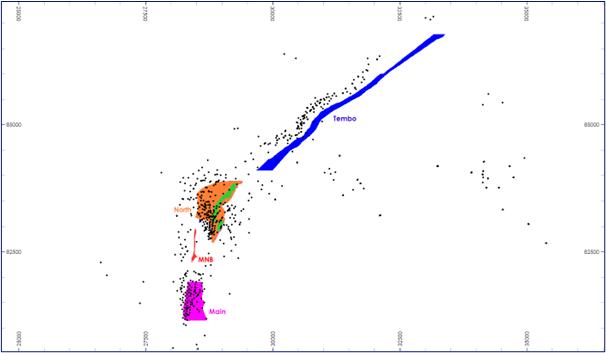
| 7.3.7 | Borehole Electromagnetic Data |
During the various exploration campaigns, borehole electromagnetic (BHEM) surveys have been completed on a significant number of drillholes: 42 drillholes in scoping study phase I, 95 in scoping study phase 2, and 134 in the prefeasibility study.
The data obtained is representative of the physical properties of the terrain and it is likely that the data measured could be used as indicators / confirmation of mineralogical / physical ground properties such as:
| § | Temperature = reactive ground relative to sulfide abundance exposed to oxygen; potential mineralisation marker. |
| § | Conductivity = sulfides would be more conductive, abundance giving greater results; potential mineralisation marker. |
| § | Magnetic susceptibility = likely associated with Fe (magnetite) alteration, which probably follows the sulfides. Possibly some other minerals present too. |
| § | Gamma tool (K, Th, U) = indicative of marker horizons such as shale (higher K, and possible Th). There may be some U alteration markers also that are potentially useful to help follow the stratigraphy. |
Fusion was the data management software used to facilitate the movement of data between a central database and a local database. Distributed database upgrades were responsible for moving any changes made to the configuration of the central database down to the local database. DHLogger was the data capture tool used for logging and editing drillhole data. Database validations were undertaken routinely.
The massive sulfide (MSSX and MSXI) and mineralised ultramafic (UMIN) that comprise the mineralisation within the Mineral Resources at all Kabanga zones lie below the level of oxidation (nominally 90–100 m below surface), and are competent, unaltered rock units that have no notable porosity.
The upper limit of the North mineralisation wireframe was trimmed to exclude all weathered / oxidised massive sulfide (based on visual examination of drill core / drill core photos and sulfur content). The massive sulfide horizon at the Tembo zone is more than 98% within fresh material, with minor oxidation present in the upper southern and northern parts of the mineralisation
Almost all Tembo assayed samples and 80% of North assayed samples have density measurements, which were obtained by pycnometry (i.e., by gravimetric method on pulverised pulp) at ALS-Chemex laboratory in Perth. Measurement of density by pycnometry started in 2003. Prior to this, during the BHP / Anglo exploration period, 4,831 water immersion measurements were completed. In 2005, it was decided to exclude the immersion measurements from the resource database as the technique as practised at Kabanga by BHP / Anglo resulted in a subset of erroneous data in the massive sulfide samples (Figure 7.2), possibly due to issues with repeatability by various technicians, calibration problems, and/or errors in manual data entry into the database.
An additional theoretical mineralogical density check calculation was made using the quantitative mineralogical data of samples from the pilot plant product. This was applied to the averaged resource grades for North and Tembo mineralised material to derive quantitative mineralogy profiles. The theoretical mineralogical density check values obtained for each material type fall within the expected limits.
Densities for pre-2003 samples (North and Main zones) were calculated using a regression equation based on sulfur (provided below). In the mineralised zones, density is highly correlated with sulfur content, as shown in the scatter plots in Figure 7.3 for massive sulfide and Figure 7.4 for mineralised ultramafics. The following density-to-sulfur linear equations were used to assign density values to North and Main intervals that had no pycnometry measurements:
MSSX density = 0.04 x S% + 2.93 based on 4,889 measurements, with r2 = 0.82
UMIN density = 0.04 x S% + 2.85 based on 1,325 measurements, with r2 = 0.80
With the exception of the upper part of North (which is not incorporated into the Mineral Resource estimates), all Tembo and North mineralised material only comprises unweathered rock. The massive sulfide material as shown by core photos is a competent massive lithology, and it is considered that the pycnometer method is suited to density determination at Kabanga.
Figure 7.2 – Comparison of Water Immersion vs. Pycnometry Density for Massive Sulfide
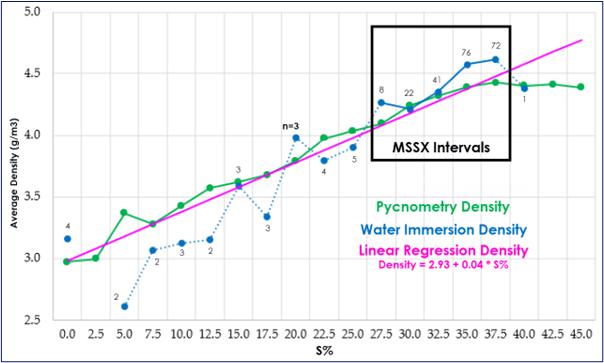
Figure 7.3 – Pycnometer Density Measurements for North and Tembo Massive Sulfide
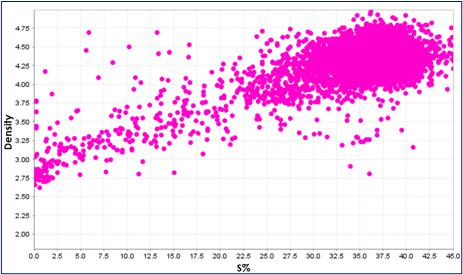
Figure 7.4 – Pycnometer Density Measurements for North and Tembo UMAF_1a
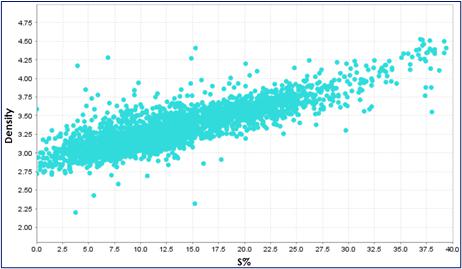
| 7.5 | Planned Drilling Campaigns (2023) |
KNL has a planned drilling programme of approximately 17 km of exploration drilling and 7 km of geotechnical drilling. Samples from the exploration drilling will also be used for metallurgical testwork as required.
The following exploration drilling programmes commenced in January 2023:
| § | Safari infill drilling – 9,235 m testing 14 targets over 500 m strike length (1 km north-east of Tembo) with the aim to bring this zone to a resource status. Safari currently has only three historical drillholes (0.4 Mt at 1.7% Ni). A target composite BHEM plate measures 480 m x 320 m at 350–700 m vertical depth. |
| § | Tembo–Safari drilling lines – 6,000 m testing ten targets on five drill lines over 1,500 m strike length to outline further potential economic nickel mineralisation at 500–700 m vertical depth along the known Tembo–Safari intrusive trend. |
| § | Rubona Hill target – 2,000 m in three holes to test potential ultramafic intrusive at nominal 400 m vertical depth 4 km south-west of planned infrastructure. Five historical drillholes all failed to intersect any ultramafic due to an incorrect magnetic model – the appropriate Magnetic Vector Inversion modelling was completed in late 2014. |
The following geotechnical drilling (7,300 m) is planned to start in Q1’23.
| § | 1,600 m for stress, rock properties drilling |
| § | 1,500 m for box cut pilot holes |
| § | 2,000 m for structure / fault drilling |
| § | 1,000 m for vent raise pilot holes |
| § | 1,100 m of water boreholes / dewatering holes |
| 8 | Sample Preparation, Analyses, and Security |
Kabanga sample preparation, assaying, and quality assurance and quality control (QA/QC) activities and protocols can be summarised as follows:
| § | Sample preparation was completed in Tanzania at ALS-Chemex laboratory in Mwanza. |
| § | All material was crushed to –2 mm and 2 x 250 g pulp bags were sent to ALS-Chemex Perth laboratory for analysis. |
| § | Perth samples were pulverised to –75 µm and analysed as follows: |
| - | 4-acid digest / ICP for Ni, Cu, Co, Ag, Fe, Cr, Mg, Mg, Mn, As, Pb, Bi, Cd, and Sb |
| - | Fire assay / ICP-MS for Au, Pd, and Pt |
| - | Ni and Cu samples exceeding 10,000 ppm, and Au, Pd, and Pt samples exceeding 1.0 g/t were re-analysed with a more accurate technique |
| - | Gravimetric method for density (pycnometry) on all samples |
| § | Not all samples have been assayed for the complete suite: only 66% for North (10,053 of 15,200 samples), and 95% for Tembo (6,422 of 6,717 samples). |
| § | QA/QC: An industry standard QA/QC protocol was used at Kabanga with the use of certified reference material standards (CRMs), blanks, check assays and duplicates. |
From 2003 onwards, sample preparation was completed in Tanzania at ALS-Chemex laboratory in Mwanza. Drill core was crushed to –2 mm and 2 x 250 g pulps were nitrogen purged and vacuum sealed in plastic bags and sent to ALS-Chemex Perth laboratory (with duplicate insertion at a rate of 1 in every 40 samples) where samples were pulverised to –75 µm prior to analysis.
Prior to February 2007, quarter core samples (NQ core) were sent for assaying (only North zone), thereafter, half core samples (NQ core) were used for assaying.
All coarse rejects (–2 mm crusher rejects) were preserved in vacuum sealed nitrogen purged bags, stored at Kabanga site.
All unused pulverised pulp material was hermetically sealed in a cryovac bag for long-term storage in Perth.
The ALS-Chemex Perth laboratory was the primary analytical laboratory for 100% of the Tembo assay results available in the database. For North, all 1994–1995, and 2001–2009 assay results are from ALS-Chemex, but for the 42 holes drilled in this zone by Anglo in 1997–1998, most of the results are from the Anglo American Research Laboratory (AARL) in Johannesburg using the ICP technique. The Anglo drillholes used for the North 2021 model update accounts for 11% of the total metres used to estimate the Mineral Resources.
A detailed list of the analytical laboratory and assaying technique used by drilling campaign is given below, with details in Table 8.1:
| § | 1991 – 1992 Sutton Resources – Cominco AA – Main zone only |
| § | 1992 – 1995 BHP – ALS Chemex Acid digest ICP primarily – Main and North zones |
| § | 1997 – 1999 Anglo– AARL Acid digest ICP primarily – Main and North zones |
| § | 2001 – 2004 Barrick – ALS Chemex Acid digest ICP – Main, MNB and North zones |
��
| § | 2005 – 2014 KNCL JV – ALS Chemex Acid digest ICP – Main, MNB, North and Tembo zones |
At the ALS-Chemex Perth laboratory, pulps were analysed as follows:
| § | 4-acid digest / ICP for Ni, Cu, Co, Ag, Fe, Cr, Mg, Mn, As, Pb, Bi, Cd, and Sb |
| § | Fire assay / ICP-MS for Au, Pd, and Pt |
| § | Ni and Cu samples exceeding 10,000 ppm, and Au, Pd, and Pt samples exceeding 1 g/t were re-analysed by a 3-acid digest / ICP finish with a high-degree of accuracy and precision |
| § | All Au, Pd, and Pt analyses exceeding 1.0 g/t also were assayed by a more accurate fire assay / ICP MS technique (see note below) |
| § | Gravimetric method for density (pycnometry) on all samples |
Notes:
| 1. | Not all samples have been assayed for the complete suite, only 66% for North (10,053 of 15,200 samples), and 95% for Tembo (6,422 of 6,717 samples). |
| 2. | The acid digest / ICP method has very limited incorporation of Ni originating from silicate minerals. However, as demonstrated by the results obtained from umpire assays on Kabanga massive sulfide samples by SGS using XRF, there are essentially no significant nickel-bearing silicates in Kabanga MSSX, and all nickel mineralisation is present as sulfides. In the ultramafic UMAF_1a material, however, the SGS XRF results report clearly higher total Ni in comparison to the acid digest / ICP results due to the presence of nickel silicates in this material. |
Table 8.1 – Summary of Analytical Techniques for Mineral Resource Drilling
| | | |
| Years | Campaign | Number of: | Analytical Techniques |
| Drillholes | Analyses |
| 1976–1979 | UNDP Regional Exploration | 17 | 3,435 | <unknown> |
| 1991–1992 | Sutton Resources | 34 | 3,897 | Cominco low-level Ni assay (AA) |
| 1993–1995 | Sutton – BHP JV | 58 | 3,898 | acid digest / ICP, Na peroxide fusion / ICP |
| 1997–1998 | Sutton – Anglo American JV | 81 | 3,903 | acid digest / AAS, |
| 1999 | Sutton – Anglo American JV | 25 | 1,170 | acid digest / ICP, Na peroxide fusion / ICP |
| 2001–2004 | Barrick Gold Corporation | 56 | 2,419 | acid digest / ICP |
| 2005–2006 | KNCL (Glencore – Barrick JV) scoping | 78 | 6,046 | acid digest / ICP |
| 2006 | KNCL scoping | 114 | 2,769 | acid digest / ICP |
| 2006–2008 | KNCL prefeasibility | 436 | 12,441 | acid digest / ICP |
| 2008–2013 | KNCL feasibility | 74 | 2,277 | acid digest / ICP |
| 2014 | KNCL regional | 6 | 73 | acid digest / ICP |
| Total | | 979 | 42,328 | |
| 8.4.1 | QA/QC Sample Frequency |
An industry standard QA/QC protocol was used at Kabanga with screen tests and the use of duplicates (coarse rejects, core), pulp check assays, certified reference material standards (CRMs), and blanks to monitor sample preparation and assaying quality.
The detailed QA/QC information and overall frequencies at which QA/QC samples were inserted in the sample batch stream from 2005 through 2009 are provided in Table 8.2.
Note:
| § | 100% of the assays in the project database from 2001–2009 are from ALS-Chemex Perth. There are no Genalysis or SGS Lakefield results in the database used for the Mineral Resource estimation. |
| § | Since routine QA/QC procedures started in 2005, 73% of the North data and 100% of the Tembo data has been subjected to a standard QA/QC protocol. |
Table 8.2 – Frequency of QA/QC Samples 2005–2009
| | | |
| QA/QC | Laboratory | Number of Samples | Frequency
(1 per …) |
| Screen Tests | ALS Mwanza | 1,075 | 20 |
| Coarse Reject Duplicates | ALS-Chemex Perth | 510 | 40 |
| Quarter Core Replicate (2005–2007 only) | ALS Mwanza-Perth | 353 | 50 |
| Pulp Check Analysis | Genalysis
SGS Lakefield | 1,006
52 | 20 |
CRM Standards
– KNCL
– ALS |
ALS-Chemex Perth
ALS-Chemex Perth |
872
1,593 |
30
15 |
| Blanks | ALS-Chemex Perth | 378 | 60 |
| 8.4.2 | Sample Preparation QA/QC – Screen Test |
From January through May 2005, Barrick requested that the ALS-Chemex sample preparation laboratory in Mwanza meet a p75 passing –2 mm criteria. Starting in May 2005, the JV then specified a p95 passing –2 mm screen criteria – this criterion was met by 99.9% of all crushed reject pulps from 2005 through 2009. The Barrick p75 screen criteria only affect samples prepared for the Main zone, not North or Tembo.
A total of 1,075 screen tests were performed on coarse pulp rejects (–2 mm crushed rejects) at ALS preparation laboratory in Mwanza from 2005 through 2009. Figure 8.1 shows the results of these screen tests.
Figure 8.1 – Percent Reject Passing –2 mm Screen – 2005–2009

| 8.4.3 | Duplicates and Check Assays – ALS-Chemex Coarse Reject Duplicates |
KNCL routinely submitted coarse reject duplicate samples produced by splitting the –2 mm crusher product (crusher duplicates) from the Mwanza sample preparation laboratory at a rate of 1 duplicate in every 20 samples. The duplicates, destined to be analysed by the primary laboratory ALS-Chemex Perth, were sent in the same batch as the original sample. The comparison between original samples and duplicates are presented as a graph of percentage relative difference according to grade in Figure 8.2 through Figure 8.4 for Ni, Cu, and Co from 2005 through 2009. These results indicate adequate precision and an absence of bias within grade ranges.
Figure 8.2 – ALS-Chemex – Percent Relative Difference for Ni Duplicates – 2005–2009
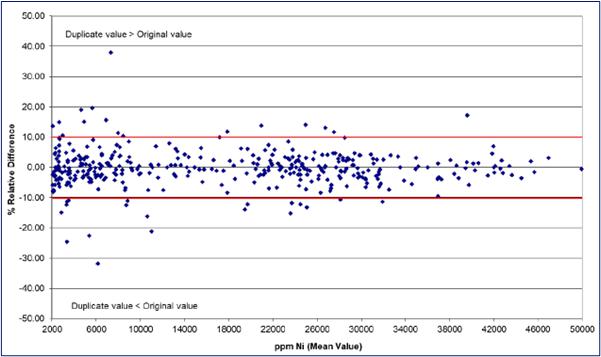
Figure 8.3 – ALS-Chemex – Percent Relative Difference for Cu Duplicates – 2005–2009
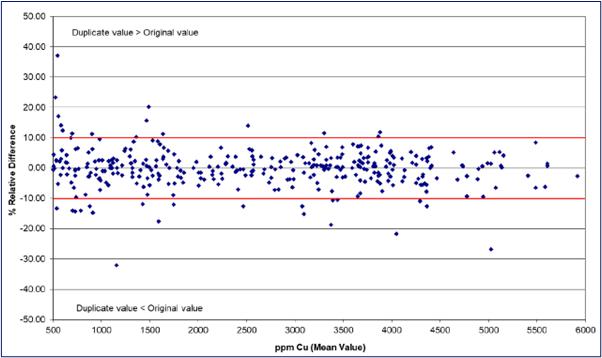
Figure 8.4 – ALS-Chemex – Percent Relative Difference for Co Duplicates – 2005–2009
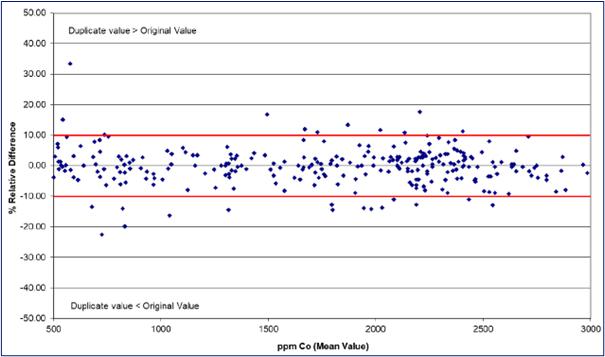
| 8.4.4 | Genalysis Pulp Check Assays |
In addition to the primary laboratory coarse rejects duplicates, since May 2005, duplicate pulverised sample pulps (every 20th sample) were prepared by ALS-Chemex in Perth and forwarded to Genalysis, Perth for analysis by the same method as ALS (4-acid digest / ICP). ALS-Chemex nitrogen purged / sealed all check assay pulps at the same time as samples were prepared for analyses at their laboratory. Genalysis conducted analyses for the same suite of elements as ALS-Chemex, using the same techniques.
Figure 8.5 through Figure 8.9 illustrate the comparison between Genalysis and ALS-Chemex pulp results for Ni, Cu, and Co.
In early-2008, 97 check analysis results indicated that for samples grading above 2,000 ppm Ni (Figure 8.5), 77% of check analyses displayed less than 10% relative difference in Ni grade (over 60 comparative values). However, as highlighted in the chart, in early 2008 a reduction in Ni grade was noted in the Genalysis values in comparison to the ALS-Chemex results. This difference was explained by the effect of oxidation of the sample pulps on the liberation of Ni during assaying. In 2005, a detailed study was completed at the ALS-Chemex laboratory to assess the effect of oxidation of sample pulps. The test was based on 47 pulp samples which were re-analysed sequentially in time once the oxidation of the pulps started. The results demonstrated that the oxidation of pulverised sample pulps causes the Ni assay result to linearly decrease with time after approximately 10 days of oxidation of the pulps, from the day of pulverisation to the time of analysis (Figure 8.6). In the case of the Genalysis pulp checks, in early 2008, 27 pulps were prepared at ALS-Chemex but not immediately vacuum-sealed, and therefore oxidised prior to their shipment to Genalysis, resulting in the low bias for Ni% highlighted on Figure 8.5.
When considering check analyses above 1% Ni, 94.7% of values displayed less than 10% relative difference (34 comparative values) and for samples grading above 2% Ni (essentially MSSX), 100% of values showed differences <10%. For samples grading above 1% Ni, results from Genalysis averaged 2.2% (relative) higher overall than those from ALS-Chemex. A limited number of analyses (eight) of MSSX CRMs (average of 2.89% Ni) indicated that Genalysis was also high-biased for nickel by approximately 3.2% relative to ALS-Chemex during the feasibility study phase – correcting for the shifted CRM value indicates very close comparative values for massive sulfide during this time. This divergence between the ALS and Genalysis results prompted KNCL to conduct additional assay tests using a different analysis method – a pyrosulphate fusion followed by XRF at SGS Lakefield.
For Cu, as displayed in Figure 8.8, the Genalysis check assays show that the Genalysis results presented a consistent low bias of 0.02% Cu grade in comparison to ALS results, which corroborates the comparison Genalysis-ALS for the CRM results.
For Co, both laboratories returned comparable results over the 2005 through 2009 period, (Figure 8.9).
Figure 8.5 – Genalysis vs. ALS-Chemex Pulp Check Assays Percent Relative Difference for Ni Grades 2005–2009 – Sequential Analysis for MSSX Ni>2%
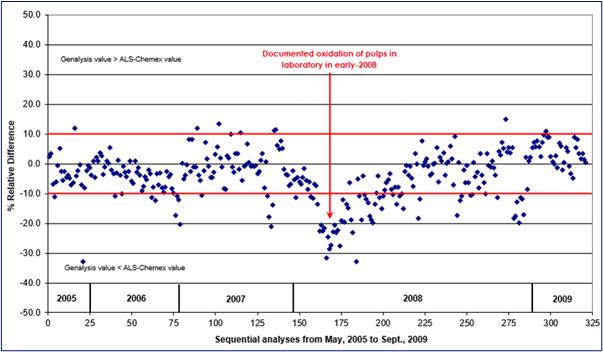
Figure 8.6 – Impact of Oxidation of Pulps on Assay Results – 2005 ALS-Chemex Test – Relative Percentage Decrease in Ni Grade vs. Number of Days between Pulverisation and Analysis (pulps allowed to oxidise)
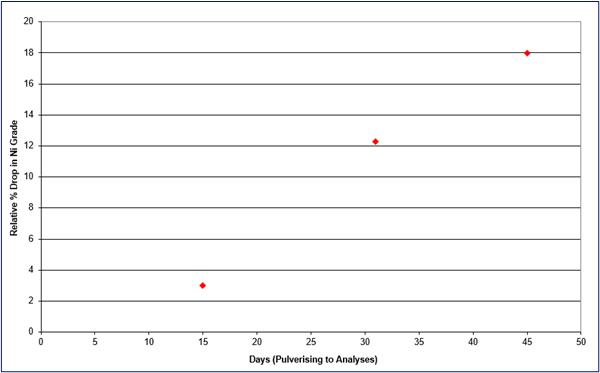
Figure 8.7 – Genalysis vs. ALS-Chemex Pulp Check Assays Percent Relative Difference for Ni Grades 2005–2009
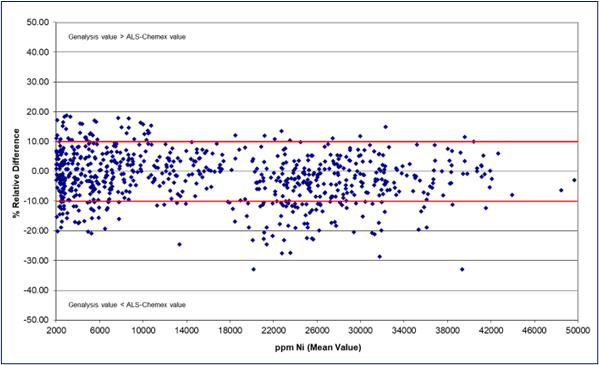
Figure 8.8 – Genalysis vs. ALS-Chemex Pulp Check Assays Percent Relative Difference for Cu Grades 2005–2009
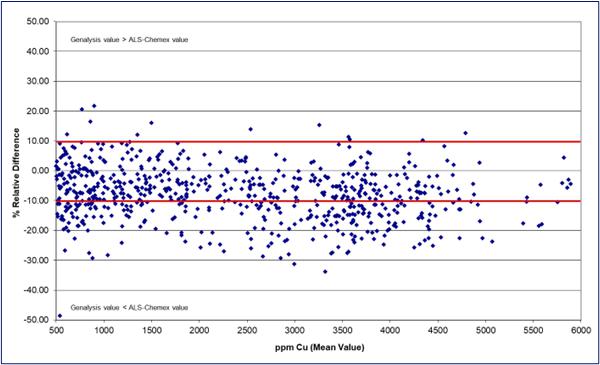
Figure 8.9 – Genalysis vs. ALS-Chemex Pulp Check Assays Percent Relative Difference for Co Grades 2005–2009
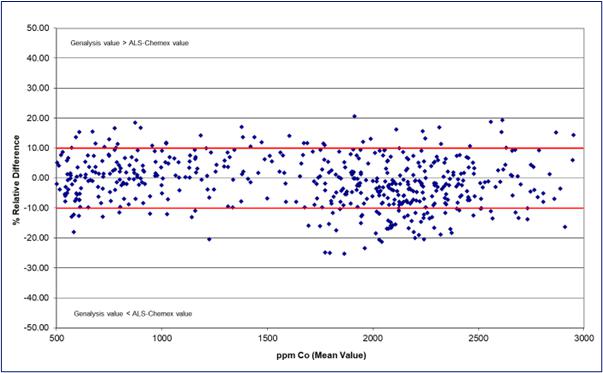
| 8.4.5 | SGS Lakefield Pulp Check Assays |
For umpire checks on the primary ALS laboratory 4-acid digest / ICP analyses, a total of 52 pulp samples (in nitrogen purged / vacuum sealed bags) were sent to SGS Lakefield. Relative difference percentages are shown in Figure 8.10. Results for MSSX samples (28) grading >2% Ni indicate that ALS was high biased by 0.03% Ni relative to the SGS XRF technique. Note that the SGS XRF technique results for Ni for UMAF-hosted mineralisation are higher than ALS since XRF provides results for total Ni, i.e., contained in sulfides and silicates.
Figure 8.10 – SGS Lakefield vs. ALS-Chemex Pulp Check Assays Percent Relative Difference for Ni Grades
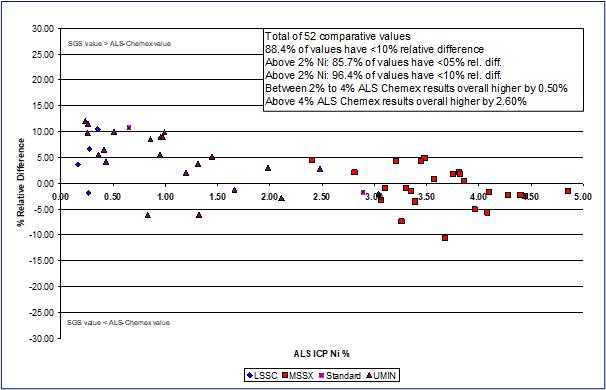
| 8.4.6 | Quarter Core Replicates |
Quarter core replicates were prepared from April 2005 through February 2007 for a total of 353 samples. The charted percentage relative differences vs. grades are shown in Figure 8.11 through Figure 8.13 for Ni, Cu, and Co.
Figure 8.11 – ALS-Chemex – Percent Relative Difference for Ni Grades for Quarter Core Replicates – 2005–2007
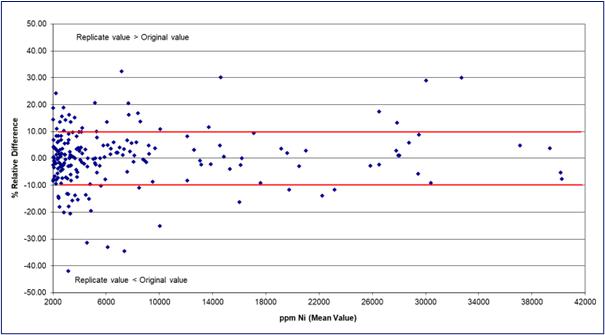
Figure 8.12 – ALS-Chemex – Percent Relative Difference for Cu Grades for Quarter Core Replicates – 2005–2007
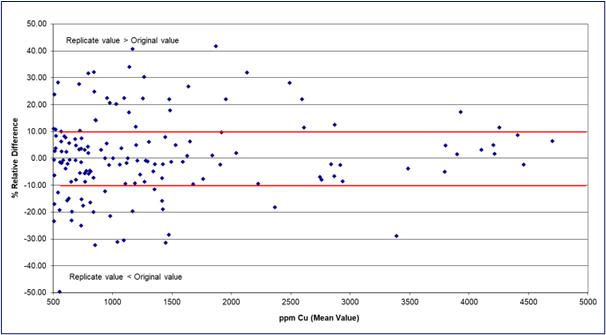
Figure 8.13 – ALS-Chemex – Percent Relative Difference for Co Grades for Quarter Core Replicates – 2005–2007
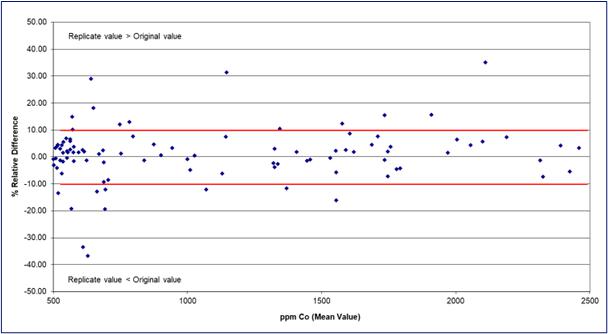
| 8.4.7 | Certified Reference Material Standards |
Certified reference material standards (CRMs) for the Project were collected from the North zone in 2004 by Barrick and shipped to the OREAS laboratory in Australia for certification using industry accepted practice. A round robin analytical exercise was conducted at seven laboratories worldwide using 4-acid digest / ICP finish for base metals, and fire assay / ICP for Au, Pd, and Pt. Two CRMs were prepared, a massive sulfide (MSSX) standard, and a disseminated (ultramafic-hosted UMAF) sulfides standard.
The massive sulfide and ultramafic material used to prepare the Kabanga CRMs was collected from the North zone at depths of 150 m and 400 m from surface. The Ni, Cu, and Co accepted grades for the Kabanga CRMs are as shown in Table 8.3.
Table 8.3 – Kabanga MSSX and UMAF CRMs – Accepted Grades
| | | | |
| CRM | Ni% | Cu% | Co% |
| Kabanga MSSX CRM | 2.68 | 0.38 | 0.23 |
| Kabanga UMAF CRM | 0.678 | 0.096 | 0.061 |
The two Project CRMs were stored as nitrogen-purged aliquots at the ALS-Chemex laboratory in Perth and inserted into the sample sequence according to the overall frequency presented in Table 8.2, using the appropriate CRM to match the submitted samples, either MSSX material or ultramafic material.
Following an audit of QA/QC procedures in May 2009, the Ni% value for the MSSX CRM was modified from 2.68% Ni to 2.71% Ni, with all scoping study and prefeasibility study (charts updated. There was no change to the UMAF CRM value of 0.659% Ni. Results from MSSX CRM analyses indicate 74% of all values lie within acceptable limits. Throughout the feasibility study, however, there had been a consistent average elevated mean value for this CRM of 2.80% Ni (27 samples) versus the (2009 revised) accepted mean value of 2.71% Ni. Figure 8.14 and Figure 8.15 illustrate the Ni% analytical results for both project CRMs since the start of the scoping study in early 2005. Table 8.4 and Table 8.5 present the project CRMs Ni% average values from 2005 through 2009.
The observed elevated MSSX CRM values during the feasibility study period were investigated. Because the two Kabanga CRMs were inserted in all sample batches submitted to both primary laboratory ALS-Chemex and the check laboratory, Genalysis in Perth, it is possible to follow over time the evolution of the reported CRM results from both laboratories. The overall rising trend in Ni% values for the MSSX CRM from 2005 is noted at both laboratories as shown on Figure 8.16 for the sequential Genalysis graph. The cause of the overall rising trend of Ni% grade for the Kabanga MSSX has not been clarified, but it is suspected that the Kabanga MSSX CRM may have lost its homogeneity during transport and handling of the pails of bulk material with the separation and settling of the denser nickel minerals (pentlandite density of 4.6–5.0t/m3) from the pyrrhotite (main nickel-bearing mineral in the Kabanga massive sulfide density of 4.6t/m3).
Note that the Kabanga UMAF CRM did not suffer the same issue over the period, and there was no appreciable variance during the feasibility study for the UMAF CRM (0.01% Ni), as shown in Table 8.4.
The statistical results including accuracy and precision for the Kabanga CRMs over the 2005–2009 period are detailed in Table 8.6.
The review results for the ALS-Chemex internal reference material standard (Forrest B) shown in Figure 8.17, and summarised in Table 8.7 with details for Forrest B in Table 8.8, corroborates the fact that the high Ni bias issue observed on the Kabanga MSSX CRM results for both ALS-Chemex and Genalysis laboratories is inherent to the Kabanga CRM itself rather than a drift of the ALS-Chemex laboratory results. Note that in 2005, ALS-Chemex results for the Forrest B standard show several results outside of the acceptable limits. The quality of the results improves from 2006-onwards, likely due to a better calibration of ALS-Chemex’s analytical equipment to these grade ranges.
The comparison between the ALS MSSX CRM results and those obtained by Genalysis showed that the Genalysis results were consistently higher than the ALS ones.
The phenomenon observed on Ni grades on the MSSX CRM results did not occur for Cu results as shown in Figure 8.18 and Figure 8.20, which display the ALS-Chemex sequential results for both project CRMs for Cu from 2005 through 2009. Cu grade results were not affected.
Co grades for the MSSX and UMAF CRMs are shown by Figure 8.19 and Figure 8.21. These show that approximately half of the Co grade results are below the minimum acceptable value.
Figure 8.14 – Kabanga MSSX CRM Ni Values 2005–2009
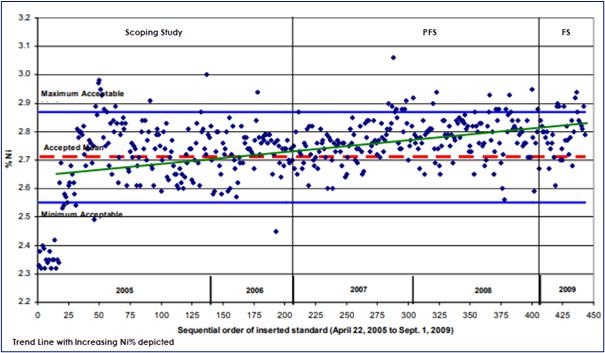
Figure 8.15 – Kabanga UMAF CRM Ni Values 2005–2009
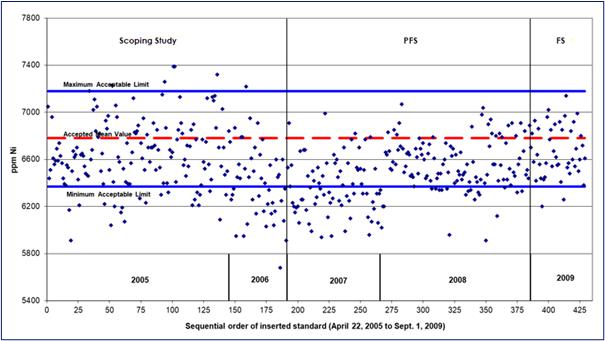
Table 8.4 – Kabanga MSSX and UMAF CRMs – Tracking of Ni% Results 2005–2009
| | | | |
| CRM | Accepted
Ni% Value | Average Ni% | Number of Samples |
| 2005 | 2006 | 2007 | 2008 | 2009 |
| MSSX | 2.71 | 2.75 | 2.72 | 2.77 | 2.78 | 2.80 | 412 |
| UMAF | 0.68 | 0.66 | 0.64 | 0.64 | 0.66 | 0.67 | 429 |
Table 8.5 – Kabanga MSSX CRM – Tracking of Ni% Results by Era
| | | | |
| Accepted Value 2.71% Ni |
| Phase | Years | Number of Analyses | Average Ni Values |
| Scoping Study | 2005–2006 | 173 | 2.74% |
| Prefeasibility Study | 2006–2008 | 212 | 2.77% |
| Feasibility Study | 2008–2009 | 27 | 2.80% |
| Total | 2005–2009 | 412 | 2.76% |
Figure 8.16 – Kabanga MSSX CRM Ni% Values by Genalysis 2005–2009

Table 8.6 – Kabanga CRMs – Summary Statistics 2005–2009
| | | |
| CRM | MSSX | UMAF |
Ni
(%) | Cu
(ppm) | Co
(ppm) | Ni
(%) | Cu
(ppm) | Co
(ppm) |
| Number of Sample | 443 | 443 | 443 | 429 | 429 | 429 |
| Accepted Value | 2.71 | 3,820 | 2,310 | 6,780 | 962 | 605 |
| Mean | 2.74 | 3,757 | 2,161 | 6,550 | 944 | 564 |
| Median | 2.76 | 3,770 | 2,160 | 6,540 | 939 | 563 |
| Minimum | 2.32 | 2,310 | 1,645 | 5,680 | 827 | 487 |
| Maximum | 3.06 | 4,960 | 2,590 | 7,390 | 1,080 | 647 |
| Standard Deviation | 0.12 | 274 | 134 | 280 | 41 | 29 |
| Accuracy | 1.03 | –1.93 | –6.87 | –3.53 | –2.04 | –7.15 |
| Precision (at 95%) | 2.90 | 5.54 | 5.27 | 3.14 | 2.73 | 4.40 |
Note:
Accuracy is calculated as the mean of the percent relative differences
Precision (at 95%) is calculated as 1.96 x standard deviation of the absolute percent relative differences / 2
Figure 8.17 – ALS-Chemex Internal Forrest B Standard – Results from 2005–2009
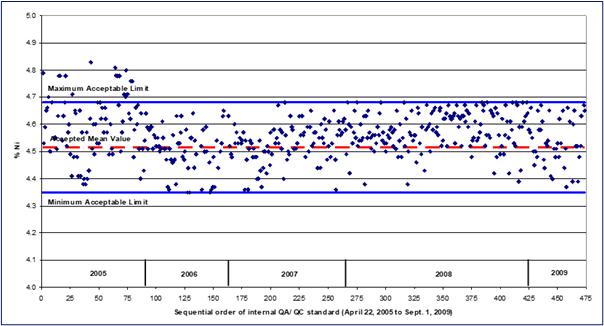
Table 8.7 – ALS-Chemex Internal Reference Material Standards – Tracking of Ni% Results 2005–2009
| | | | |
| ALS-Chemex Internal Standard | Accepted
Ni% Value | Average Ni% | Number of Samples |
| 2005 | 2006 | 2007 | 2008 | 2009 |
| Forrest B | 4.52 | 4.61 | 4.51 | 4.53 | 4.58 | 4.54 | 452 |
| BM-44 | 1.27 | 1.29 | 1.27 | 1.28 | 1.29 | – | 354 |
| GBM306-12 | 0.95 | – | – | – | 0.96 | 0.94 | 150 |
| BM-64 | 0.60 | 0.63 | 0.61 | 0.60 | 0.62 | – | 475 |
| GBM398-4c | 0.41 | – | – | – | 0.40 | 0.40 | 162 |
Table 8.8 – ALS-Chemex Internal Forrest B Standard – Summary Statistics 2005–2009
| | |
| | Ni% |
| Number of Samples | 452 |
| Accepted Value | 4.515 |
| Mean | 4.56 |
| Median | 4.56 |
| Minimum | 4.35 |
| Maximum | 5.01 |
| Standard Deviation | 0.09 |
| Accuracy | 0.95 |
| Precision (at 95%) | 1.40 |
Note:
Accuracy is calculated as the mean of the percent relative differences
Precision (at 95%) is calculated as 1.96 x standard deviation of the absolute percent relative differences / 2
Figure 8.18 – Kabanga MSSX CRM Cu Values 2005–2009
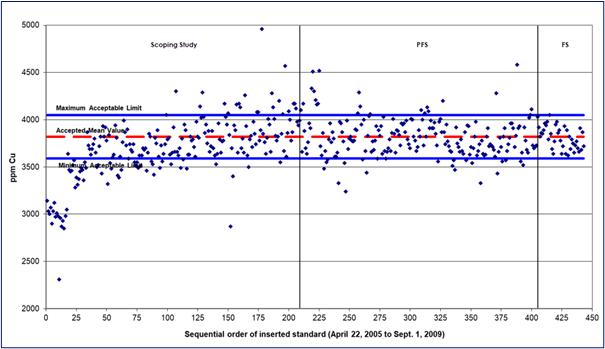
Figure 8.19 – Kabanga MSSX CRM Co Values 2005–2009
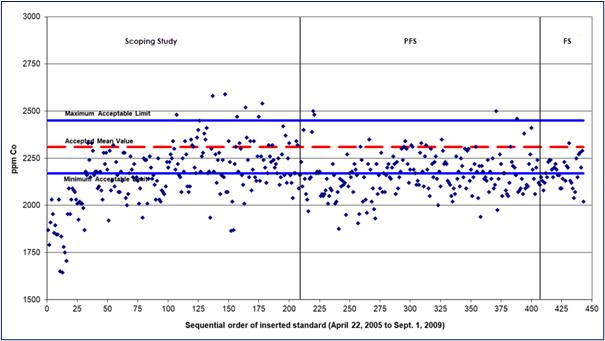
Figure 8.20 – Kabanga UMAF CRM Cu Values 2005–2009
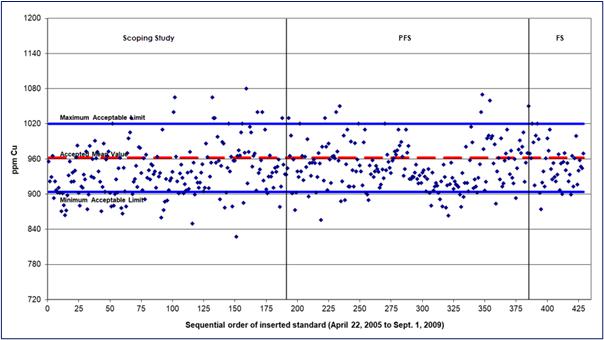
Figure 8.21 – Kabanga UMAF CRM Co Values 2005–2009
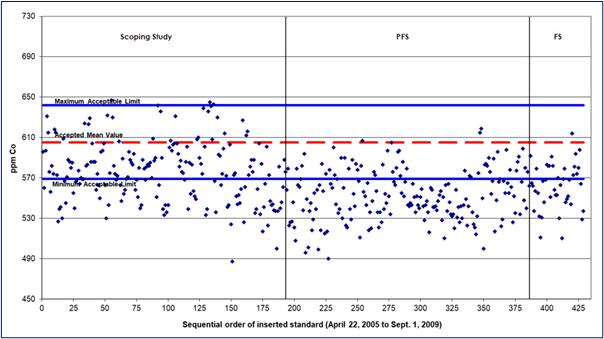
Blanks, prepared and pulverised on site from pure quartzite, were inserted into the sample series to monitor possible contamination at both sample preparation stages in Tanzania and in Perth. A total of 378 blanks were analysed from 2005 through 2009. Figure 8.22 illustrates the results for potential Ni contamination.
An increase (mainly warning level) in contamination for Ni, Cu, and Co noted in January and February 2009 was addressed at the ALS laboratory in Perth through better cleaning of the pulverising machines between samples. A 2009 QA/QC audit report recommended lowering of the acceptable level for Ni contamination to 25 ppm (approximately) from 300 ppm, which is based on the official Ni protocol of 1/20th of the cut-off grade. This discussion was deemed largely academic, as there is no significant effect on the Kabanga samples due to nickel contamination.
Figure 8.22 – Blanks – Ni Results 2005–2009
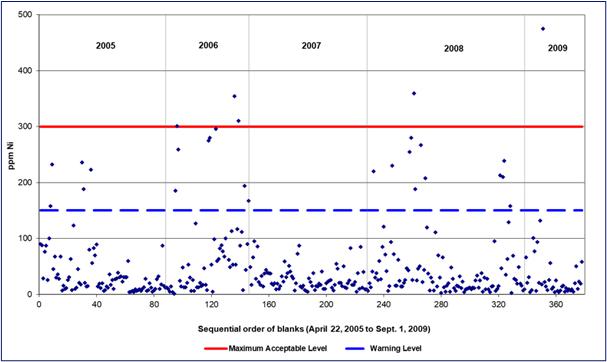
In the opinion of the QP, the sample preparation, security, and analytical procedures meets industry standards for data quality and integrity. There are no factors related to sampling or sample preparation that would materially impact the accuracy or reliability of the samples or the assay results. Recent infill drilling results have corroborated historical results. The outcomes of the QA/QC procedures indicate that the assay results are within acceptable levels of accuracy and precision and the resulting database is sufficient to support the estimation of Mineral Resources.
| 9.1 | Verifications by the QP |
The QP has worked on the Kabanga nickel project for a combined period of 12 years during the period from 2005 through 2023.
The QP is currently employed by Tembo Nickel Corporation Limited as Exploration Geology Manager and has been in this role since November 2021, based the Kabanga nickel project site.
Prior to this, the QP was employed to work at the Kabanga nickel project site by Glencore Canada Limited as Senior Geologist from 2005 through 2015.
All aspects that could materially impact the integrity of the data informing the Mineral Resource estimates (core logging, sampling, analytical results, database management, QA/QC, geological interpretation, grade estimation) were overseen by the QP.
| 9.1.2 | Verifications of Analytical Quality Control Data |
Analytical quality control data typically comprises analyses from reference material standards, blank samples, and a variety of duplicate data. Analyses of data from reference material standards and blank samples typically involve time series plots to identify extreme values (outliers), or trends, which may indicate issues with the overall data quality. To assess the repeatability of assay data, several tests can be performed, of which most rely on certain statistical tools. The following charts for duplicate data are routinely assessed:
| § | Quantile-quantile (Q-Q) plots |
| § | Mean versus half relative deviation (HRD) plots |
| § | Mean versus half absolute relative deviation plot |
| § | Ranked half absolute relative deviation (HARD) plot |
Review of results from recent drilling undertaken by KNL have corroborated the location of the mineralised zones and the tenor of the mineralisation. Assay results are pending.
In the opinion of the QP, the data is adequate for the purposes used in the 2023MRE. The drill data is considered by the QP to be adequate for the estimation of Mineral Resources.
| 10 | Mineral Processing and Metallurgical Testing |
This metallurgical testwork summary is based on the 2014 draft feasibility study report. No testwork reports for the concentrator or downstream processing have been reviewed.
The 2014 draft feasibility study provides a high-level summary of the historical metallurgical testwork undertaken in support of the development of the concentrator flow sheet as at that time (Table 10.1).
Table 10.1 – Metallurgical Testwork Summary
| | | | | |
| Year | Company | Level of Study | Zone | Activity |
| 1999 | Sutton–Anglo American JV | Scoping | North / Tembo | Mineralogy, Comminution |
| 2006 | Glencore
(Xstrata Nickel (Falconbridge))–Barrick Gold JV | Prefeasibility | North / Tembo | Mineralogy, Comminution |
| 2009 | Glencore–Barrick Gold JV | Feasibility | All | Mineralogy, Comminution Processing Variability assessment |
| 2012 | Feasibility | All | Mineralogy, Comminution Processing Variability assessment |
The metallurgical testwork was undertaken as part of previous technical studies, including the 2006 scoping study, the 2008 prefeasibility study, and the 2009 2.2 Mtpa engineering study (all commissioned by Glencore), and earlier studies such as the 1999 prefeasibility study commissioned by Anglo.
Mineralogical studies dating from 2004 and 2006 reported that the Tembo zone had a much higher ratio of pyrrhotite to pentlandite than was the case at Glencore’s (then Falconbridge) benchmark Canadian operations (Sudbury and Raglan). The North zone mineralisation was reported to be both coarser grained and endowed with less pyrrhotite (proportionally) than the Main zone mineralisation; liberation of pentlandite at the selected grind size of 80% 100 µm was reported to be very high (approximately 96%). The pyrrhotite to pentlandite ratio, and the average grain size both reduced moving from the massive sulfide mineralisation into the disseminated mineralisation material. The concentration of the smelter-associated, and environmentally deleterious elements, (As, Pb, and Bi), was assessed as being higher in the ultramafic material than the massive sulfide.
The 1999 prefeasibility study discusses flotation testwork conducted on samples from the then recently discovered North zone, complementing earlier work conducted on material from the Main zone. Variability testwork on samples of massive sulfide produced good rougher flotation grades and recoveries. Adding diluting material negatively affected grade but not recovery, requiring a cleaner stage to achieve good grades. A locked cycle test produced a concentrate assaying 14.5% Ni, 2.1% Cu, and 1.3% Co at recoveries of 91.6%, 96.9%, and 93.6% respectively.
Testwork conducted on disseminated mineralisation material (largely from the Main zone) produced much lower concentrate grades and a more sensitive grade–recovery response than the massive sulfide mineralisation, due to the much greater proportion (up to one-third) of nickel in this material associated with pyrrhotite.
Subsequent flotation testwork included work conducted by SGS Lakefield and reported in 2004. This work tested two samples, one of which was identified as being from the ‘Keel’ zone. The samples had head grades of 2.7%–3.0% Ni, 0.2%–0.4% Cu, and 0.22%–0.25% Co. This work culminated in locked cycle tests, which produced concentrates assaying 20.0%–20.3% Ni, 1.8%–3.2% Cu, and 1.7% Co at recoveries of 80%–85%, 94%–97%, and 81%–88% respectively.
Ore hardness testwork conducted during the 2008 prefeasibility study indicated that the material is relatively soft but that the surrounding waste rock is relatively hard. Dilution was therefore expected to be a significant factor in grinding circuit design and operation.
Flotation testwork was conducted by Glencore during the 2006 scoping study and the 2008 prefeasibility, culminating in the running of two mini-pilot plant campaigns in 2007.
The mini-pilot plant had a design capacity of 10 kg/h. The first campaign consisted of three runs; the first testing a baseline circuit configuration, and the last two an optimised circuit. The first two runs used a composite of mineralisation from the North zone and the third run used a life of mine (LOM) composite.
The North zone composite consisted of a blend of 47% North Shallow mineralisation and 53% North Deep mineralisation, with 18.9% dilution (14.9% sediments, 5.0% ultramafic). Its head grade was 2.60% Ni and 0.36% Cu. The first run produced a concentrate assaying 19.6% Ni and 2.86% Cu at recovery of 88.5% and 91.6% respectively. The second run, with the optimised flow sheet (shorter pre-aeration time, heated pulp to simulate site conditions and a single cleaner stage), produced a concentrate assaying 21.3% Ni and 3.20% Cu at a recovery of 86.5% and 90.7% respectively.
The LOM composite consisted of 5.4% Main, 69.3% North and 25.3% Tembo mineralisation, with 16.4% to 17.2% diluting material. The composite assayed 2.46% Ni and 0.34% Cu. The run using this material produced a concentrate assaying 19.6% Ni and 2.86% Cu at a recovery of 89.3% and 91.6% respectively.
An additional circuit was added to the flow sheet for the third run for pyrrhotite rejection from pentlandite concentrations, however the rejection rate (65%) was lower than had been achieved in laboratory testing (80%).
The second mini-pilot plant campaign likewise consisted of three runs, all using the optimised circuit from the first campaign. The first run used a blend representing the first four years of production (32% North Shallow, 45% North Deep, and 22% Tembo, with 16.9% dilution). This run produced a concentrate assaying 22.0% Ni and 2.33% Cu at a recovery of 83.3% and 78.4% respectively. The second run tested a LOM composite and produced a concentrate assaying 17.2% Ni and 2.44% Cu at a recovery of 88.5% and 86.8% respectively. The third run used mineralisation from Tembo only and produced a concentrate assaying 19.6% Ni and 3.02% Cu at a recovery of 88.6% and 93.6% respectively.
The pyrrhotite rejection circuit was used in all runs. High-pyrrhotite rejections (>90%) were achieved, however the circuit was unstable and difficult to operate due to the necessity to run with low froth levels.
The mini-pilot plant trial reports did not report cobalt assays in the concentrates.
Subsequent studies determined the mineralisation oxidised in a matter of weeks if stored in crushed form, with flotation recoveries negatively affected if the sample was stored for more than four weeks. The concentrates were also prone to self-heating, although not to the same extent as other nickel concentrate samples against which the Kabanga samples were benchmarked.
Aeration under alkaline conditions was determined to be required ahead of flotation for pyrrhotite depression (through oxidation), following which a rougher-cleaner-cleaner scavenger circuit at a grind size of 80% passing 100 µm was determined to be able to produce concentrates at 17%–18% Ni at a recovery of 89%. No material difference was found in flotation response between the North and Tembo mineralisation.
The introduction of deleterious elements to smelting into the concentrate, particularly MgO but also As and Pb, through dilution by ultramafic waste rock, was determined to be not material at dilution levels of up to 15%. The baseline Pb content of the Tembo mineralisation is higher than for the North mineralisation, and proportionally more As reports to the concentrate for the Tembo mineralisation than for the North mineralisation.
Some preliminary pre-concentration testwork was conducted in 2009 and 2010, testing both gravity separation (by heavy liquid separation) and the use of sensor-based sorting. Both techniques showed promise, more so in potentially rejecting sediments rather than ultramafics, due to the presence of sulfide minerals disseminated in this material.
| 10.2 | Downstream Processing Assumption |
KNL’s intended downstream process for metal recovery from the flotation concentrate consists of pressure oxidation (POX) followed by sequential stages of separation using solvent extraction and precipitation, with final metal recovery (nickel, copper, and cobalt separately) by electrowinning. This process would be undertaken in a multi-metal mineral processing facility (MMPF).
The process, which is supported by an extensive body of testwork on analogue concentrates of similar bulk sulfide mineralogy to that of Kabanga, is summarised in Figure 10.1, with the main unit operation stages being as follows:
| 1. | Aqueous POX in an acidic sulfate medium to dissolve the sulfides and remove the base metals. |
| 2. | Solid–liquid separation by pressure filtration with washing to recover entrained metals. |
| 3. | Pre-neutralisation of pregnant leach solution (PLS) with limestone to remove excess free acid, producing a gypsum by-product potentially suitable for use as binder at the Kabanga mine site underground backfill paste plant. |
| 4. | Copper refining from pre-neutralised PLS by solvent extraction and electrowinning. |
| 5. | Iron removal with limestone in aerated tanks to purify the solution for cobalt and nickel refining. |
| 6. | Cobalt refining by solvent extraction and electrowinning. |
| 7. | Nickel refining by solvent extraction and electrowinning. |
Figure 10.1 – Conceptual Flow Sheet for the Proposed MMPF Process
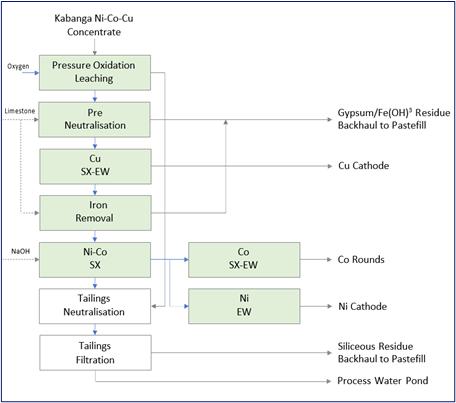
| 10.2.1 | Pressure Oxidation Testwork |
Kabanga nickel concentrate is proposed to be processed by use of Lifezone Limited’s hydrometallurgical technology. Initially samples of concentrate have been prepared to a representative Ni grade by compositing select concentrate samples from individual batch rougher flotation tests.
Two pressure oxidation (POX) leach tests were undertaken at Simulus Laboratories to provide a preliminary indication of refinery metal recoveries. POX leach extractions for these non-optimised tests were 98.5% nickel, 96.9% copper, 97.5% cobalt (POX 1) and >99% nickel, copper, and cobalt (POX 2). Calculated head grades returned within acceptable variance from assay head grades for both tests, indicating that the mass balances closed within expectations. These results indicate that the Kabanga nickel concentrate produces high extractions of nickel, copper, and cobalt through the POX process.
The testwork reported in support of the development of the comminution and flotation flow sheet for concentrate production appears to be robust. For the massive sulfide mineralisation, which is the focus of the project, the flotation concentrates grade, especially for the primary metal of interest (nickel), are good, and the recoveries for all three metals of interest (nickel, copper, and cobalt) are relatively high.
The influence of waste dilution on hardness and flotation response has been investigated, and control of the level of dilution, especially from ultramafic material, will be important. The more recent testwork has suggested that the use of pre-concentration may have benefit in controlling the effect of diluting material.
KNL is currently engaged in the drilling of additional metallurgical holes to provide bulk samples for an extensive series of planned metallurgical testing to finalise the design of the process facilities.
In the opinion of the QP, the data is adequate for the purposes used in the 2023MRE and the analytical procedures used in the analysis are of conventional industry practice.
| 11 | Mineral Resource Estimates |
In this section, parameters and methods used to arrive at Mineral Resource estimates for North zone are described, and also Tembo in some instances. Main zone and MNB zone Mineral Resource estimates were derived using the same approach.
| 11.1 | Mineral Resource Estimates – Introduction |
Mineral Resources for the Project have been estimated using industry best practices and conform to the requirements of S-K 1300 as Mineral Resource estimates.
The Mineral Resource estimates discussed in this section were last reported by previous owners as at 31 December 2016. The basis for the Mineral Resource estimate was the unpublished 2014 Technical Report on the Kabanga nickel project.
The last two formal resource estimates completed on North and Tembo are the 2008 and 2010 resource estimates, both of which were completed during the period of the Glencore-Barrick Gold JV, with the following history:
| § | The 2008 estimate was part of a prefeasibility study. In 2009, an independent technical audit of the database, QA/QC data, and the Mineral Resource estimates was commissioned. |
| § | The 2010 estimate update was completed after an infill drilling campaign and forms the basis of the 2014 draft feasibility study report. |
In 2021, an independent check resource modelling exercise was commissioned for North and Tembo. This study was based on the same drillhole database used for the 2010 estimates but used a different modelling approach. The 2021 model was undertaken as part of a process of verification of the Mineral Resource estimates and associated data with the purpose of providing confidence in the Mineral Resource estimates in a present-day context, and for guiding future exploration planning to inform future updates to the resource models.
The 2010 Mineral Resource estimate was completed using Datamine software, with macros developed for Falconbridge / Glencore (updated in February 2010 to allow for the estimations of the full suite of component elements and density). The original macros had been thoroughly audited by independent consultants in May 2009.
The estimate was completed on the MG09 grid. The MG09 grid is based on the UTM grid, with the following conversions:
| § | Subtract 200,000 from the easting, |
| § | Subtract 9,600,000 from the northing, and |
| § | Add 10,000 to the elevation. |
| 11.2 | Mineral Resource Drillhole Database |
Analytical data were not available for all fields in the historical Main and North dataset, in particular, Co, S, and density. To enable a model estimate for all fields, regression formulae and/or nickel tenor were derived from holes with analytical data. The Main zone formulae were used for the MNB zone.
Formula for missing analytical data in Main (and MNB) zone:
| § | Co = (0.0047 * S% + 0.0112); correlation coefficient (r2) = 0.915; n = 1,047 |
| § | S = (100 * Ni% + 2.59 * Cu% * 2.94 – 0.417 * Ni% * 2.94)/(2.55 * 2.94); n = 1,047 |
| § | Density = (0.0406 * S% + 2.9326); r2 = 0.9063; n = 258 |
Formula for missing analytical data at North zone:
| § | Co = (0.0611 * Ni% + 0.0353); r2 = 0.8223; n = 5,332 |
| § | S = (100 * Ni% + 2.59 * Cu% * 3.50 – 0.417 * Ni% * 3.50)/(2.55 * 3.50); n = 5,279 |
| § | Density = (0.0388 * S% + 2.9719); r2 = 0.7962; n = 4,622 |
The Tembo zone has complete analytical results for all fields to be estimated.
During the interpretation of the lithological units and the subsequent construction of the mineralised domain wireframes, a number of diamond drillholes were identified for further validation on the basis of uncertainty about collar locations or downhole surveys.
Cut-off dates for geological and analytical data for each of the individual models are as follows:
Once imported into Datamine, drillholes were viewed in conjunction with surface topography to visually inspect and validate collar locations, hole traces, lithology, and mineralisation.
| 11.3 | Mineral Resource Domain Interpretations |
Two distinct mineralisation domains were interpreted for the North and Tembo zones; the massive sulfide domain (MSSX) and the ultramafic domain (UMIN).
Estimations were completed separately at each of the zones for each of these domains and then combined to one model. Waste wall rock models were completed for both the hangingwall and footwall of the combined models.
Table 11.1 outlines the baseline economic parameters and factors established in 2010 for the Project.
These parameters were used in 2010 to generate factors to develop a nickel-equivalent (NiEq10) value.
Drillhole intervals greater than 1.0% NiEq10 were considered for inclusion in constructing the mineralised wireframes. The only exception is for the ultramafic hosted mineralisation at Tembo, where intervals greater than 1.1% Ni (note: not NiEq10) were considered for inclusion.
Table 11.1 – Parameters used Inform 2010 Mineralisation Interpretation and Estimation
| | | | |
| Metal Prices |
| Component | Source | Unit | Value |
| Copper | LME | ¢/lb | 2.68 |
| Silver | LME | $/oz | 14.67 |
| Gold | LME | $/oz | 971.00 |
| Palladium | LME | $/oz | 400.00 |
| Platinum | LME | $/oz | 1,300.00 |
| Nickel | LME | $/lb | 7.00 |
| Cobalt | Realised | $/lb | 10.00 |
| Exchange Rate |
| US / Canada | Spot | US$1 = CDN$ | 1.04 |
Wireframe surfaces were constructed for the ultramafic bodies at each zone, where applicable. Where ultramafic rock is not present, the BNPU (banded pelite) and the LRPU (lower pelite) contacts are used to guide the shape and to orient the sulfide mineralisation interpretation. Surfaces for the LRPU and LQTZ (lower quartzite) are also available for North zone.
Mineralisation was interpreted using strings that were ‘snapped’ (attached) to drillhole intersections on 12.5 m spaced west–east cross-sections. The modelled mineralisation was initially restricted to massive sulfides (MSSX) or massive sulfides with sedimentary xenoliths (MSXI) in each zone. Low-grade mineralisation (disseminated sulfides) in the adjacent ultramafic rocks was included for the semi-massive nickel mineralisation (>1.1% Ni) hosted in the UMAF_1a unit at Tembo and the UMIN mineralisation at North (>1.0% NiEq10).
At the peripheries of the drillhole dataset, strings were projected up-dip or down-dip (as appropriate) and pinched out, based on the extrapolation guidelines shown in Table 11.2.
Table 11.2 – Interpretation Extrapolation Guidelines
| | |
| Intersected Length (m) | Projected Distance (m) |
| <5.0 | 25.0 |
| 5–10 | 37.5 |
| ≥10 | 50.0 |
Occasionally, on the fringe of a mineralised wireframe, an intersection narrower than 1 m was projected <5 m up-dip or down-dip in order to capture the sample(s) and give a geologically plausible shape to the wireframe.
The basal contact of the oxidised weathering zone was also interpreted and used to trim the top of the mineralised wireframe at the Main zone and the south upper end of the North zone. Almost the entirety (98%) of the mineralisation at Tembo is below the level of oxidation. Figure 11.1 is a 3D schematic long-section of the modelled mineralised zones.
For North and Tembo, a waste halo model, for both hangingwall (3 m) and footwall (3 m) waste, outside the interpreted MSSX and UMIN mineralisation, was completed.
| 11.5 | Mineral Resource Domain Statistics |
A multivariate statistical analysis was completed for North and Tembo. It was based on the assay data limited to the samples that have the complete suite of elements assayed, i.e., 10,053 samples for North and 6,422 samples for Tembo.
The data was backcoded for the logged information enabling domaining of the assay data according to stratigraphy or other geological information for the statistical analysis.
| 11.5.1 | Grade and Lithology |
The main mineralised lithologies encountered at North and Tembo are:
| § | Massive sulfide (MSSX) and a massive sulfide with xenoliths (MSXI). |
| § | Ultramafics that contain two types of disseminated sulfides: UMAF_1a and UMAF_KAB. |
| § | Pelites: sedimentary country rock at the contact with the massive sulfides or ultramafics. Two types of pelite: the banded pelite BNPU, and the lower pelite LRPU. |
Other lithologies, (gabbro, quartz, etc.), for which samples have been assayed, are insignificant in terms of mineralisation tenor and frequency.
North
The chart presented in Figure 11.2 shows that the main lithologies, in terms of number of assayed samples, are MSSX, UMAF_KAB, BNPU, LRPU, UMAF_1a, and MSXI.
The Ni box plot in Figure 11.3 shows all the represented lithologies ordered (high-to-low) according to Ni average grades. The overall grade characteristics of the lithologies are shown in the box plots shown Figure 11.4.
Tembo
As for North, a chart and box plots are presented in Figure 11.5 through Figure 11.8. Figure 11.8 summarises the average grades for the main elements for North and Tembo by lithology.
Overall, North has higher Ni and Cu grades than Tembo in the massive sulfides, but similar (or lower) grades in the ultramafics, for similar to slightly lower S and Fe grades than Tembo.
Figure 11.1 – Schematic Long-section View of the Kabanga Mineralised Zone Wireframes with the Topography Surface (looking west)

Figure 11.2 – Pie Chart of Assayed Lithologies – North Zone
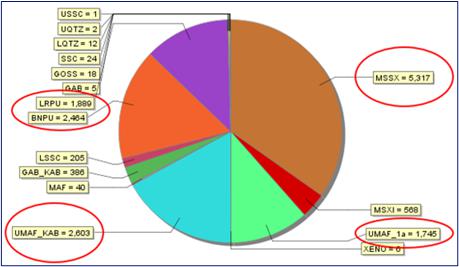
Figure 11.3 – Ni Box Plot Ranked for all Assayed Lithologies – North Zone
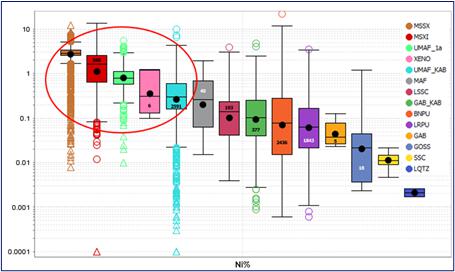
Figure 11.4 – Box Plots for a Suite of Elements for the Main Assayed Lithologies – North Zone
| 1. | The central boxes lower and upper boundaries are the 25th (Q1 lower quartile), and 75th (Q3 upper quartile) percentiles |
| 2. | The line in the box is the median (50th percentile) |
| 3. | The dot in the box is the average |
| 4. | The whiskers are the extreme values which are not outliers, the circles and triangles are extreme outliers further than 1.5 x (Q’3–Q’1) |
Figure 11.5 – Pie Chart of Assayed Lithologies – Tembo Zone
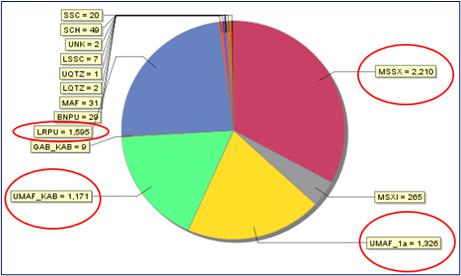
Figure 11.6 – Ni Box Plot Ranked for all Assayed Lithologies – Tembo Zone
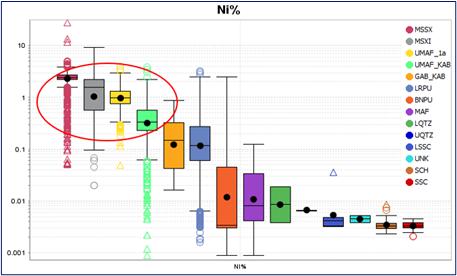
Figure 11.7 – Box Plots for a Suite of Elements for the Main Assayed Lithologies – Tembo Zone
| 1. | The central boxes lower and upper boundaries are the 25th (Q1 lower quartile), and 75th (Q3 upper quartile) percentiles |
| 2. | The line in the box is the median (50th percentile) |
| 3. | The dot in the box is the average |
| 4. | The whiskers are the extreme values which are not outliers, the circles and triangles are extreme outliers further than 1.5 x (Q’3–Q’1) |
Figure 11.8 – Average Grades (Ni, Ag, Cu, Co, S, and Fe) by Lithology for North (N) and Tembo (T)
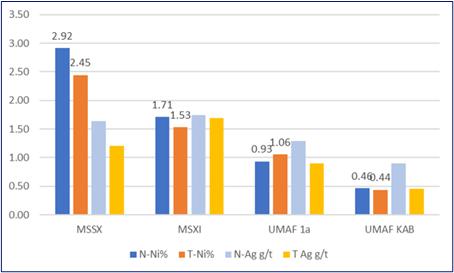
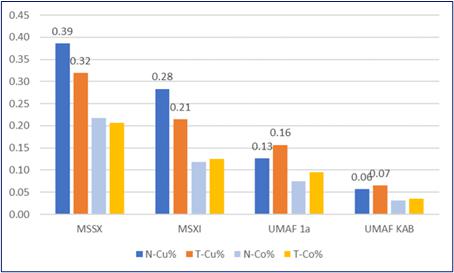
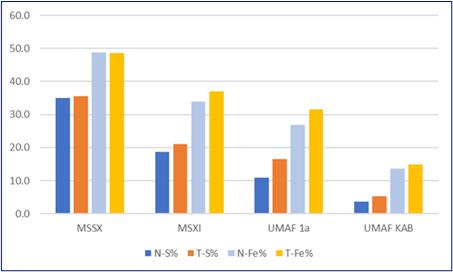
| 11.5.2 | Principal Component Analysis |
Principal component analysis (PCA) was used to identify the associations between the various elements in the massive sulfides and the ultramafics.
A PCA element correlation matrix and PC1–PC2 diagram is presented for North and Tembo in Table 11.3 and Table 11.4 respectively. Figure 11.9 and Figure 11.10 show that grade elements assemble in the three groups of correlated elements listed below, with a strong negative correlation between the Ni group and the MgO–MnO group (black arrow).
| § | Ni, Cu, Co, S, Fe, and Ag are positively correlated, and MgO with MnO are negatively correlated, to the first set of elements, forming the ‘nickel suite’. |
| § | Au, Pt, Pd, As, Pb, Bi, and Sb are positively correlated elements, forming the ‘arsenic suite’. |
| § | Cr2O3 is not correlated with any suite when looking at the global dataset. |
Figure 11.9 – PC1–PC2 Diagram – North Zone
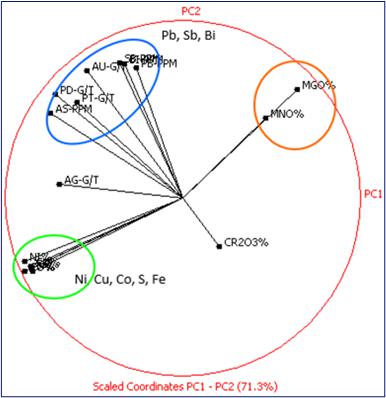
Figure 11.10 – PC1–PC2 Diagram – Tembo Zone
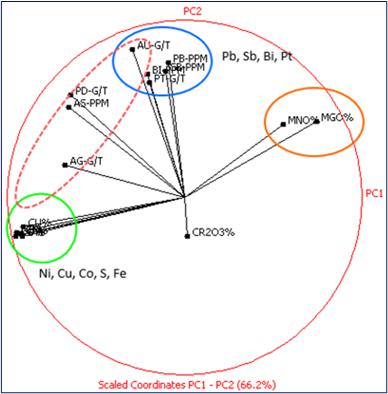
Table 11.3 – PCA Correlation Matrix – MSSX, MSXI, UMAF_la, and UMAF_KAB – North Zone

Table 11.4 – PCA Correlation Matrix – MSSX, MSXI, UMAF_la, and UMAF_KAB – Tembo Zone

The composite length selected was based on the results of an analysis of the sample length statistics. Sample length statistics for North are shown in Figure 11.11 and for Tembo in Figure 11.12.
The average sample length for both North and Tembo is 1 m, with the majority of samples in the mineralised domains being 1 m samples.
Figure 11.11 – Histograms of Sample Lengths – North Zone
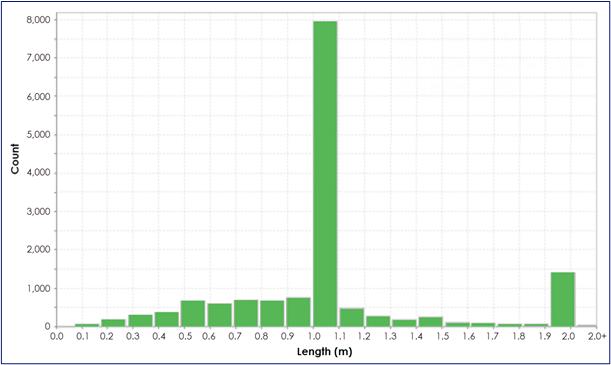
Figure 11.12 – Histograms of Sample Lengths – Tembo Zone

The need for top-cutting was reviewed for Ni, Cu, and Co grades. The coefficient of variance (CV) indicates that top-cutting is unnecessary in all zones reviewed, therefore, no top-cutting was applied.
Variograms were generated for all estimated elements, including density, for North and Tembo (MSSX and UMIN domains) in 2010. Good correlation with geology was achieved for each zone.
Estimation of grades for all elements included in the resource models was done by ordinary kriging using the variogram models that had been obtained for each component. The dimensions of the search ellipsoids used were based on the anisotropy of the variogram model.
Sample North zone variogram parameters are shown in Table 11.5 and Table 11.6.
Table 11.5 – MSSX Variogram Parameters – North Zone
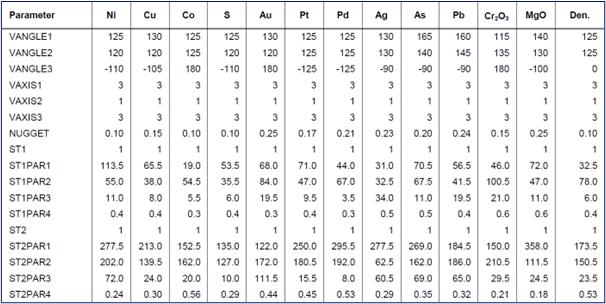
Table 11.6 – UMIN Variogram Parameters – North Zone
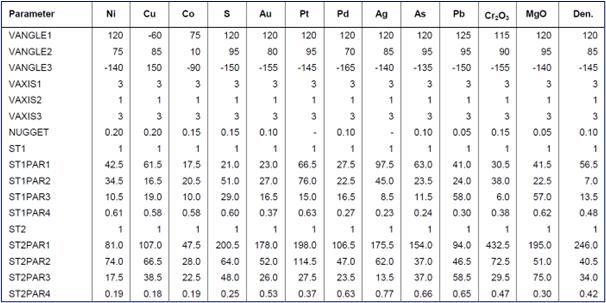
Subsequent to the variography, a search strategy was implemented, which has the first search volume equal to two-thirds of the maximum variogram range, the first multiplier is 1.5 (which brings the distance to the range of the variogram), and the final search multiplier equals six (6) which ensures all model cells receive an estimate.
Each element has its own search strategy based on the variography. No octant search or maximum number of samples per drillhole criteria was utilised. Search parameters for North are presented in Table 11.7 and Table 11.8. The North MSSX model was estimated 100% by the first search volume. The North UMIN was estimated 72% by the first search volume, 18% by the second search volume and 10% by the third search volume.
Table 11.7 – MSSX Search Parameters – North Zone
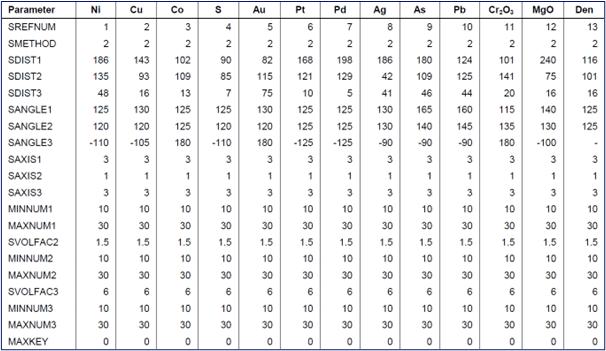
Table 11.8 – UMIN Search Parameters – North Zone
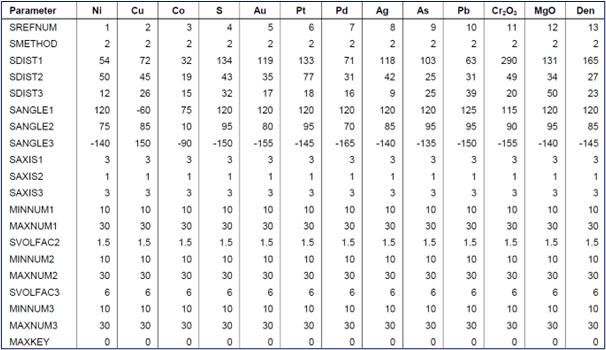
| 11.5.7 | Kriging Neighbourhood Analysis |
A kriging neighbourhood analysis performed by an independent consultancy in June 2008 resulted in selection, for all zones, of a cell size of 5 m x 15 m x 10 m (X x Y x Z), with sub-celling permitted.
Grade (and density) estimation was undertaken using ordinary kriging (OK) for each zone. The North MSSX zone required a minimum of 10 samples and a maximum of 30 samples to grade a cell. A three-pass search strategy was adopted. The initial search volume is 186 m x 135 m x 48 m, with the second search volume using a multiplier of 1.5 and the third search volume using a multiplier of 6. No restrictions were applied on the samples that fall within the search volumes.
The models were simultaneously estimated using OK (base case), inverse distance weighting to the power of 2 (ID2) and nearest neighbour (NN). The global tonnes and nickel-equivalent grades were compared for each estimation method, as a check for gross errors in the kriging parameters.
The models were validated visually and statistically for all grade elements estimated and the density.
Visually, the models were reviewed on cross-sections against the drilling input data to ensure that the models honour the grade overall values and continuity.
The following specific verification steps were taken:
| § | Cross-sections of the estimated models were reviewed to ensure the estimates honour drillhole data and the geological interpretation. |
| § | Histograms of the composited drillhole data were overlain with the regularised model Ni grades to assess distortion of grade distribution. |
| § | Cumulative frequency plots for each of the three estimation methods and the composited drillhole grades illustrate the modest grade distribution distortion. |
| § | Swath plots were generated for each of the two domains (MSSX and UMIN) to review and assess the grade distributions. |
In addition, independent and thorough audit of the work undertaken and inputs to that work was conducted.
The classification criteria and zoning used for the 2010 Mineral Resource estimates are based on the distance from the cell centroid to drillhole samples.
The higher classifications were assigned using wireframe solids defined to enclose areas of consistent geology with drill spacing meeting the recommended drill spacings based on a conditional simulation study.
| 11.6 | Other Mineralised Zones |
The information currently available for the Kima and Safari mineralised zones is not at a suitable level (specifically quantity) to be used for reporting of classified Mineral Resources. Therefore, Mineral Resources have not been included for these zones.
Further work would be required on the Kima and Safari zones, including additional drilling, before these zones could be considered for including in public classified Mineral Resource reporting for the Project.
| 11.7 | Mineral Resource Cut-off Grade |
As the Kabanga mineralised zones contain multi-element mineralisation, a grade-equivalent formula has been used for reporting from the Mineral Resource estimates.
Based on previous work on the Project, nickel was identified as the primary payable element, and therefore a nickel-equivalent was used for the cut-off grade. A formula was used to convert payable elements in a model cell, to a nickel equivalent value, by using the individual relative metal values as compared to nickel, to result in a total nickel-equivalent for a model cell.
The 2023 nickel-equivalent (NiEq23) formula is as follows:
NiEq23 (%) = Ni% + Cu% x 0.411 + Co% x 2.765
The 2023 NiEq cut-off grade is 0.58% NiEq.
Metal price and recovery assumptions used for the NiEq23 and cut-off grade determination are shown in Table 11.9.
Table 11.9 – NiEq23 Input Parameters
| | | | | | |
| Metals | Metal Prices ($/lb) | Recoveries | Net Recovered ($/lb) | NiEq Ratio |
Concentrator (%) | Refinery (%) |
| Nickel | 9.50 | 89.00 | 98.00 | 8.29 | 1.000 |
| Copper | 4.00 | 86.00 | 99.00 | 3.41 | 0.411 |
| Cobalt | 26.00 | 89.00 | 99.00 | 22.91 | 2.765 |
The Initial Assessment assumes an underground mining rate of 2.2 Mtpa. The mining method is underground stoping with backfill feeding an on-site concentrator. Concentrate is assumed to be transported to an off-site hydrometallurgical processing facility to produce final nickel, copper, and cobalt metals, with transport of final metals to Dar es Salaam, and export to markets for sale.
Modifying factors were estimated using the current project scenario and comparisons with studies of similar projects. The costs accuracy level of approximately ±50% and a contingency level of 25%.The key assumptions are as follow:
| § | Mining rate: an underground mining rate of 2.2 Mtpa. |
| § | Processing rate: a concentrator located on site with a capacity of 2.2 Mtpa feed producing a concentrate grading 18% Ni (producing approximately 220 ktpa of concentrate. |
| § | All power requirements are assumed to be supplied from the national grid. |
| § | Transport of the concentrate to an off-site hydrometallurgical processing facility for downstream processing to produce final nickel, copper, and cobalt metals. |
| § | Transport of nickel and copper cathode and cobalt rounds to Dar es Salaam for sale locally or exported. |
Table 11.10 details the input parameters used for cut-off grade determination.
Table 11.10 – 2023 Cut-off Grade Parameters
| | | |
| Description | Unit | Value |
| Metal Prices |
| Nickel | $/lb | 9.50 |
| Copper | $/lb | 4.00 |
| Cobalt | $/lb | 26.00 |
| Concentrator Recovery |
| Ni | % | 89.00 |
| Cu | % | 86.00 |
| Co | % | 89.00 |
| Refinery Recovery |
| Nickel | % | 98.00 |
| Copper | % | 99.00 |
| Cobalt | % | 99.00 |
| Concentrate |
| Nickel Grade | % | 18.00 |
| Moisture Content | % | 8.00 |
| Transport Cost | $/t.km | 0.08 |
| Royalties and Fees |
| Royalties and Fees | % of smelter payables | 8.8 |
| Refining |
| Refinery to Port Transport Cost | $/t.km | 0.06 |
| Port and Sea Freight Cost | $/t | 75.00 |
| Insurance Cost | % freight value | 0.4% |
| Refining Cost | $/lb recovered metal | 1.55 |
| Mine Operating Costs |
| Underground Mining | $/t | 50.00 |
| Processing | $/t | 13.00 |
| General and Administration | $/t | 13.71 |
| 11.8 | Reasonable Prospects for Economic Extraction |
The 2023MRE describes the Mineral Resource estimates of the Kabanga Project.
The Initial Assessment assumes an underground mining rate of 2.2 Mtpa. The mining method is underground stoping with backfill feeding an on-site concentrator. Concentrate is assumed to be transported to an off-site hydrometallurgical processing facility to produce final nickel, copper, and cobalt metals, with transport of final metals to Dar es Salaam, and export to markets for sale.
A cash flow analysis was not performed for the Project. The Initial Assessment has been prepared to demonstrate reasonable prospects of economic extraction, not the economic viability of the Mineral Resource estimates. The Initial Assessment is preliminary in nature, it includes Inferred Mineral Resources that are considered too speculative geologically to have modifying factors applied to them that would enable them to be categorised as Mineral Reserves, and there is no certainty that this economic assessment will be realised.
Macroeconomic trends, taxes, royalties, data, and assumptions, interest rates, marketing information and plans, legal matters such as statutory and regulatory interpretations affecting the mine plan and environmental matters are outside the expertise of the QP and are within the control of the registrant (see Section 25).
However, as significant environmental and social analysis has been conducted for the Project over an extended period, LHL employs professionals and other personnel with responsibility in these areas and these personnel have the best understanding of these areas, and following a review of the current supplied information, the opinion of the QP is that it is reasonable to rely on the information provided by LHL.
The QP has concluded that the Mineral Resource estimates meet reasonable prospects for eventual economic extraction.
| 11.9 | Kabanga 2023 Mineral Resource Statement |
The Kabanga 2023 Mineral Resource estimates are based on the Mineral Resources reported by Glencore and Barrick as current in their 2016 annual reports.
The nickel-equivalent grade and the modifying factors for the cut-off grade were updated with 2023 assumptions and reported only for the portion of the mineralisation attributable to the LHL interest in the property, with an effective date of 15 February 2023, (see Table 11.11).
Mineral Resource estimates have been reported in accordance with the U.S. Securities and Exchange Commission (US SEC) Regulation S-K subpart 1300 rules for Property Disclosures for Mining Registrants (S-K 1300). This is the first time of reporting using S-K 1300.
Table 11.11 – Kabanga Mineral Resource Estimates as at 15 February 2023
Based on $9.50/lb Ni Price, $4.00/lb Copper, and $26.00/lb Cobalt
| | | |
| Mineral Resource Classification | LHL Tonnage (Mt) | Grades | Contained Metal |
NiEq23
(%) | Ni
(%) | Cu
(%) | Co
(%) | NiEq23
(Mlb) | Nickel
(Mlb) | Copper
(Mlb) | Cobalt
(Mlb) |
| MAIN |
| Measured | – | – | – | – | – | – | – | – | – |
| Indicated | 2.14 | 2.44 | 1.92 | 0.28 | 0.15 | 115 | 91 | 13 | 7 |
| Inferred | – | – | – | – | – | – | – | – | – |
| Main Total | 2.14 | 2.44 | 1.92 | 0.28 | 0.15 | 115 | 91 | 13 | 7 |
| MNB |
| Measured | – | – | – | – | – | – | – | – | – |
| Indicated | – | – | – | – | – | – | – | – | – |
| Inferred | 0.51 | 1.98 | 1.52 | 0.20 | 0.13 | 22 | 17 | 2 | 2 |
| MNB Total | 0.51 | 1.98 | 1.52 | 0.20 | 0.13 | 22 | 17 | 2 | 2 |
| NORTH |
| Measured | 4.7 | 3.37 | 2.64 | 0.35 | 0.21 | 348 | 273 | 37 | 22 |
| Indicated | 11.9 | 3.80 | 3.05 | 0.41 | 0.21 | 998 | 801 | 107 | 55 |
| Inferred | 12.0 | 3.29 | 2.64 | 0.35 | 0.18 | 868 | 698 | 93 | 48 |
| North Total | 28.6 | 3.52 | 2.81 | 0.37 | 0.20 | 2,214 | 1,772 | 236 | 125 |
| TEMBO |
| Measured | 4.9 | 3.03 | 2.34 | 0.32 | 0.20 | 325 | 251 | 34 | 22 |
| Indicated | 2.2 | 2.20 | 1.69 | 0.22 | 0.15 | 108 | 83 | 11 | 7 |
| Inferred | 2.1 | 3.05 | 2.41 | 0.31 | 0.18 | 140 | 111 | 14 | 8 |
| Tembo Total | 9.2 | 2.83 | 2.20 | 0.29 | 0.19 | 573 | 445 | 60 | 37 |
| OVERALL MINERAL RESOURCE |
| Measured | 9.6 | 3.20 | 2.49 | 0.34 | 0.21 | 673 | 525 | 71 | 43 |
| Indicated | 16.3 | 3.40 | 2.71 | 0.36 | 0.19 | 1,221 | 974 | 131 | 70 |
| Inferred | 14.6 | 3.21 | 2.57 | 0.34 | 0.18 | 1,031 | 826 | 109 | 58 |
| Total | 40.4 | 3.28 | 2.61 | 0.35 | 0.19 | 2,925 | 2,325 | 311 | 171 |
| 1. | Mineral Resources are reported exclusive of Mineral Reserves. There are no Mineral Reserves to report. |
| 2. | Mineral Resources are reported showing only the LHL attributable tonnage portion, which is 69.713% of the total. |
| 3. | Cut-off uses the NiEq23 using a nickel price of $9.50/lb, copper price of $4.00/lb, and cobalt price of $26.00/lb with allowances for recoveries, payability, deductions, transport, and royalties.
NiEq23% = Ni% + Cu% x 0. 411 + Co% x 2.765. |
| 4. | The point of reference for Mineral Resources is the point of feed into a processing facility. |
| 5. | All Mineral Resources in the 2023MRE were assessed for reasonable prospects for eventual economic extraction by reporting only material above a cut-off grade of 0.58% NiEq23. |
| 6. | Totals may vary due to rounding. |
| 11.10 | Risks and Opportunities |
Risk factors that could materially impact the Mineral Resource estimates and cost / revenue assumptions, and therefore the reporting cut-off grade include:
| § | Metal price and exchange rate assumptions. |
| § | Changes in the interpretations of mineralisation geometry and continuity of mineralised zones. |
| § | Changes to geotechnical, mining, and metallurgical recovery assumptions. |
| § | Changes to the assumptions related to the continued ability to access the site, retain mineral and surface right titles, maintain environment and other regulatory permits, and maintain the licence to operate. |
The classification of the estimate of Mineral Resources may be materially affected by environmental, permitting, legal, title, taxation, socio-political, marketing, or other relevant issues. At present there are no known environmental, permitting, legal, title, taxation, socio-economic, marketing, or political issues that would adversely affect the Project Mineral Resource estimates presented in this TRS. However, Mineral Resources, which are not Mineral Reserves, do not have demonstrated economic viability. There is no assurance that KNL will be successful in obtaining any or all of the requisite consents, permits or approvals, regulatory or otherwise, for the Project.
In terms of discovery, the mineralisation has not yet been closed off between the North and Tembo zones and between the Tembo and Safari zones. There remains opportunity to identify extensions of the mineralisation in these areas. Regional targets also provide opportunities for potential additional mineralisation.
A resource model update is planned for 2023. This will incorporate KNL infill and extensional drilling. The infill drilling completed to date has succeeded in confirming the presence and location of the pre-KNL drilling and has therefore provided additional confidence in the Mineral Resource estimates.
The 2023MRE QP has not identified any relevant material technical and/or economic factors that require resolution with regards to the Mineral Resource estimates.
Based on the Initial Assessment in this TRS, the QP concludes that there are reasonable prospects for economic extraction of the Mineral Resource estimates. The Mineral Resource estimates were prepared in accordance with the definitions and standards in S-K 1300.
| 12 | Mineral Reserve Estimates |
This section not used.
This section not used.
| 14 | Processing and Recovery Methods |
This section not used.
This section not used.
| 16.1 | Marketing and Metal Prices |
The metal prices used in the 2023MRE are based on an assessment by the 2023MRE QP of recent market prices, long-term forward curve prices, and consensus prices from analysts and institutions. The metal prices selected are at the upper range of long-term consensus price forecasts over the last 10 years; this is an optimistic view of prices for use in the cut-off grade analysis to ensure that the reasonable prospect of economic extraction considerations do not exclude material that may be able to be included in future studies for defining Mineral Reserves. For the Initial Assessment analysis in the 2023MRE, the metal prices shown in Table 16.1 were used.
Table 16.1 – Metal Prices
| | |
| Metal | Value
($/lb) |
| Nickel | 9.50 |
| Copper | 4.00 |
| Cobalt | 26.00 |
A nickel concentrate is assumed to be produced on site and then transported to an off-site hydrometallurgical processing facility to produce final nickel, copper, and cobalt metals, with transport of final metals to Dar es Salaam and export to markets for sale.
Markets for nickel, copper, and cobalt metals are well established, and demand for these metals is expected to be robust in the long-term given the global trend to decarbonisation. As yet, no contracts or detailed marketing studies have been prepared by LHL.
There is a market for nickel, copper, and cobalt that supports the conclusion that KNL will be able to sell the products from the Project. Macroeconomic trends, taxes, royalties, data, and assumptions, interest rates, and marketing information and plans are outside the expertise of the QP and are within the control of the registrant (see Section 25).
| 17 | Environmental Studies, Permitting, and Plans, Negotiations, or Agreements with Local Individual or Groups |
The Project lies within the Lake Victoria basin, in a moist sub-humid climate zone dominated by a wet monsoon season from around November to May and a dry season for the rest of the year. The long-term average annual rainfall at the Project site is around 1,000 mm/year, with average annual (actual) evapotranspiration estimated at around 930–970 mm/year.
The site is located only a few kilometres upstream from the Burundi border, which is demarcated by the Muruhamba river. The proposed tailings storage facility (TSF) is located on the Nyamwongo river within the Muruhamba sub-watershed, approximately 7 km upstream from the Tanzania–Burundi border.
A comprehensive programme of field investigations and baseline monitoring was undertaken across the Project area between 2005 and 2009, including continuous and manual streamflow monitoring, packer testing, pumping tests (up to 30-day duration), continuous and manual water level measurements, seepage surveys, and a water user census.
Groundwater flow through the various bedrock units at the Project is dominated by flow within secondary porosity (fracture flow) and controlled mainly by the extent and degree of interconnection of fractures. Permeability is generally low-to-moderate (10E–7 to 10E–8 m/s) and anisotropic along the plane of dominant fracturing, which is generally orientated parallel to the main ridge (north–north-east trend). Matrix (unfractured) permeability is estimated to be in the order of 10E–10 m/s. A general trend of decreasing hydraulic conductivity with depth has been observed. In the area of the TSF, the saprolite and upper weathered bedrock were estimated to have a permeability in the order of 10E–7 m/s.
Depth to groundwater is between 5–40 m and groundwater contours follow topography. Groundwater discharge to streamflow is estimated to represent up to 70% of streamflow during low flow periods. Recharge beyond the shallow soil zone is limited due to high soil evapotranspiration rates.
Baseline water quality monitoring shows groundwater concentrations exceed Tanzanian water quality standards for Al, Fe, and Mn, and surface water exceedances for Al, Fe, Mn, and Ni.
Groundwater modelling, including inflow estimation and prediction of groundwater drawdown impacts, has been previously undertaken.
The predicted inflows to the underground mine are expected to reach a maximum of approximately 3,500 m³/day (41 L/s) at around five years after the start of decline development, before falling to 2,200–2,700 m³/day (26–31 L/s) for the remainder of the mine life.
A dirty water pumping system was selected during the 2014 draft feasibility study using modular positive displacement pumps capable of pumping water with a high suspended solids load. The proposed dewatering option sees a combination of transfer pumping and main pumping stations equipped with helical rotor pumps. Travelling decline helical rotor pumps were specified for the decline advancement. Some electrical submersible pumps have been allocated for general transfer and trash pumping duties.
A predictive water balance has been developed for the Project, which has been integrated with the TSF design studies given the critical role that the TSF plays in the Project in terms of water storage. The water balance is deterministic, using only average climate parameters. However, it did look at both a dry season and wet season starts to TSF construction. The water balance model is sensitive to mine water inflows, which have a high degree of uncertainty in their prediction. Some consideration has been made of the potential for higher or lower storage requirements in the TSF due to uncertain mine water inflows.
Potable water requirements during construction will be met by water wells located at the camp together with early mine water inflows. Mine water inflows will require treatment via a high-density sludge (HDS) plant before being pumped to the TSF. Process water demand is expected to be met by concentrate thickener overflow, treated water from the HDS plant, and return water from the TSF, with make-up water abstraction required from the Ruvubu river during the dry season only.
The site water balance is in excess from early within the Project timeline. A number of water surplus management scenarios were considered during the 2014 draft feasibility study, with the selected option requiring year-round discharge to the Ruvubu river via a HDS and reverse osmosis plant on occasions when the water balance is in excess.
| 17.1.3 | Surface Water Management |
Stormwater drainage has been designed for the Project, which includes management of contact run-off from facility areas with either potential pollutants and/or high sediment loads, as well as diversion of all other stormwater run-off around the mine facilities.
Sediment control ponds, supported by silt fences and small check dams, have been designed to contain run-off areas with potential for high sediment loads, such as the waste stockpile, decline boxcut and TSF. The sediment retention dam at the decline boxcut area is also intended to provide a source of water supply during the construction phase of the project.
Sediment control structures have been designed to manage up to a 1-in-20 year 24-hour storm, and to meet World Bank (1995) TSS standards of limiting TSS levels to 50 mg/L, 95% of the time. Design to the Tanzania Bureau of Standards (2005) TSS level of 100 mg/L not to be exceeded 100% of the time was not considered practical, resulting in excessively large sediment management structures, which still had a residual probability of failure.
The 2012 environmental impact statement (EIS) considers groundwater and surface water impacts during operations, closure, and post-closure. All of the predicted surface water and groundwater impacts were rated low or negligible.
Numerical groundwater modelling was undertaken to predict the extent of drawdown impacts from mine development, dewatering, and potable water abstraction. The zone of influence in groundwater is expected to be relatively limited and to be within the project site boundaries. There is also a drawdown associated with perpetual pumping post-closure, which is only slightly reduced from the operational footprint. Up to 56% maximum reduction in baseflow is predicted for local tributaries, although most stations are predicted to experience less than 10%.
Hydrological modelling was undertaken for a number of tributary catchments of the Nyamwongo, Muruhamba (draining south), Mu Kinyangona (draining south-west), and Muhongo (draining north) with the potential to be impacted by the Project. Flow reduction due to drainage area interception is predicted to be up to 95% for the areas directly around the mine facilities and downstream of the TSF but generally less than 10% in other areas.
The combined impact of reduction in flow when considering the cumulative effect of reduction in baseflow runoff across all tributary catchments is predicted to be up to 16% for the Nyamwongo and 4% for the Muruhamba, reducing to less than 1% at the Ruvubu. These numbers are predicted to be similar or lower post-closure.
Due to potential impacts from acid rock drainage and metal leaching (ARDML) from the mine, waste dumps, and TSF, several specific water management measures are required to limit potential water quality impacts from the project during operations and into post-closure. These are:
| § | Emplacement of a course rock fill cover over the TSF in order to maintain an elevated groundwater level and ensure that the emplaced tailings remain saturated. |
| § | Operation of the TSF seepage collection system until seepage from the TSF meets water quality criteria set out in the Closure Plan. |
| § | Collection and active water treatment (high-density sludge and reverse osmosis) of water emanating from the underground mine, quarries, ore and waste rock piles, and TSF seepage collection system to meet Tanzania in requirements for liquid effluent discharge. Treated water would be reused where possible during operations and surplus water would be discharged to the Ruvubu river. It is not clear where the resulting sludge and brine would be disposed of. |
| § | Post-closure hydraulic containment pumping around the underground mine to discharge to environment of mine water seepage, which is expected to be of poor quality due to a high-ARDML potential. Containment pumping would need to continue until mine water quality meets the criteria as set out in the Closure Plan. |
| 17.2 | Environmental, Social, and Governance |
| 17.2.1 | Key Features of the Environmental and Social Setting |
This area of Tanzania is largely devoid of large mammals. The most numerous types of fauna identified during the EIA included reptiles, birds, and small rodents. All plant communities identified during the EIA have already been affected to some degree by human activity.
There are no protected areas within the immediate vicinity of the Project site. The nearest protected area within Tanzania is a small Forest Reserve several kilometres to the north-east.
To the south-west, in Burundi, there is a National Park that shares a border with Tanzania. The national border, and the park border, are marked by the Ruvubu river that drains north-west before turning east toward Lake Victoria, (Figure 17.1).
The Project area is situated mainly within Bugarama ward, and also Bukiriro and Muganza wards. Four villages are located within the Project area, and two villages are just outside the Project area. There are an additional nine villages along the north and south access roads, (Figure 17.2). The 15 villages were included in the EIS (2012) and cover a broad area with small clusters of houses making the settlements dispersed. According to the 2014 draft feasibility study, the total population of the 15 villages is 52,000, predominantly belonging to the Shubi ethnic group, and largely practicing Christianity. The populations of these 15 villages are young, with median ages of approximately 15 years. Females generally outnumber males, particularly in the young adult age group of 20–39 years. The total working-age population is approximately 25,000.
Within the Project area, sources of domestic water include springs, tributary streams, and traditional shallow dug wells in valley bottom lands. The rivers are not used for domestic water supply.
Figure 17.1 – Project Location and Protected Areas
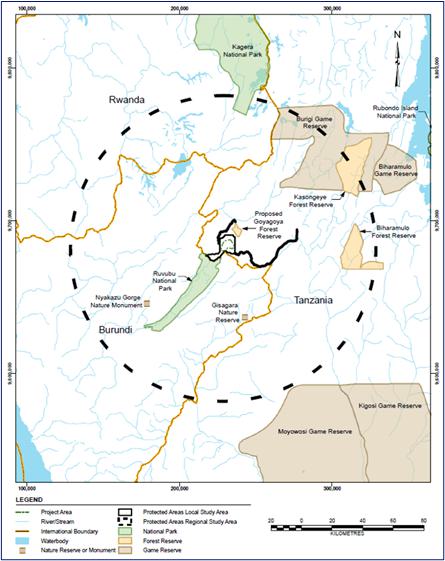
The local economy is based on subsistence agriculture and, to a lesser extent, on animal husbandry (cattle and goats). The primary natural resource use in the area is the collection of fuel wood, building materials, and medicinal plants, beekeeping, and livestock grazing. Local markets serve the villages, providing locally grown products with some imported products. Most businesses within the 15 villages are small, and include those that process and sell agricultural products, small wholesale / retail shops, and food vendors. There is limited access to workforce skills, markets, credit, and agricultural extension services that would allow the small businesses to grow in scope and diversity.
As identified in the EIS (2012), due to the proximity to Burundi, cross-border trade contributes significantly to the local economy, particularly for those villages along the south access road to Nyakahura, and in Mumiramira and Bugarama villages. Most people travel by foot or bicycle, and some villages are not serviced by roads. Anecdotal information indicates that it is common for Burundians to walk across the international boundary to visit local markets and seek day-labour opportunities during the agricultural planting and harvesting seasons.
Figure 17.2 – Local Area Plan
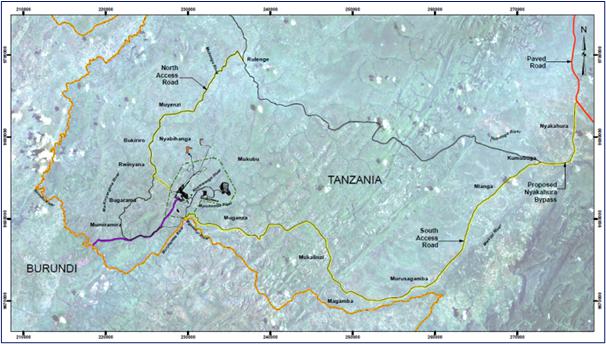
The only professional wage employment in the Project area is with various government agencies (health care, education, administration, and the army). According to the EIS (2012), there are 32 schools and 13 health facilities in the Project area.
Although all 15 villages in the Project area have at least one primary school, and all wards have secondary schools, only 60% of the working-age population completed primary school, and 10% completed secondary education. A significant barrier to wage employment is the lack of basic education and employment skills and/or experience.
One of the legacies of Tanzania’s post-colonial socialist heritage is a highly organised system of administration, which extends down to the village level. Villages are governed by elected Village Government Councils (VGCs) that have between 15 and 25 members. The villages of Bugarama, Rwinyana, Nyabihanga, Muganza, and Mukubu, have administrative control over land inside the Project area boundary.
| 17.2.2 | Environmental and Social Management |
The EIS produced for the project in 2012 contains a series of social and environmental commitments to which the Project will be required to adhere. Following the submission of the EIS to the Government Authorities, an Environmental Certificate was issued to Kabanga Nickel Mining Company in 2013. This certificate was transferred to TNCL in June 2021, and all the commitments within the EIS are therefore transferred to the new company.
The Environmental Management Plan (EMP) was developed in 2012 as part of the EIA to comply with the Mining Act 2010. The EMP has supporting management plans to mitigate the negative impacts, and enhance the positive impacts, including the biophysical management plan, the social management plan, the relocation–resettlement action plan (RRAP), the local stakeholder engagement plan (LSEP), plus various operational management plans.
The EIS states the Company’s commitment to the goal of sustainable development through its sustainable development policy and framework. The framework provides the organisational arrangements for implementing, reviewing, and continually improving the organisation’s management of sustainability, and guided the development of the EMP and the supporting management plans. The sustainable development framework is supported by a detailed set of 17 sustainable developments standards, and is also aligned with international guidelines, such as the UN Global Compact, and ICMM’s sustainable development framework.
KNL has also made public commitments via its website to adhere to industry leading practices for the production of nickel metal and is in the process of adding to the existing ESG management team, including the recruitment of community relations personnel to re-engage with the local project stakeholders.
| 17.2.3 | Stakeholder Engagement and Grievance Management |
Stakeholder engagement is an integral part of KNL’s corporate responsibility. A local stakeholder engagement plan (LSEP), developed in 2013, describes the Company’s strategy and programme for engaging with stakeholders in a culturally appropriate manner through the timely provision of relevant and understandable information.
The LSEP documents engagement activities prior to 2007, through the EIA process and during the development of the RRAP. According to the LSEP over 170 consultation meetings were held in 2007, 2008, 2009, and 2011, with local stakeholder representatives from various groups, including potentially-affected villages, government officials at the national, regional, district, and village level, and other interested groups.
At the time, there was overall support for the Project particularly due to limited alternative large-scale economic opportunities, however people from the local villages were increasingly voicing impatience with the slow pace of project development. Other local community concerns frequently raised during the ongoing engagement included concerns around water quality, resettlement and compensation, and in-migration.
Another key point of importance noted in the LSEP is the high expectations placed on the Project to contribute to improved living standards of the local community through transparent, and gender sensitive employment opportunities of local people, procurement of local goods and services, and community development activities.
A grievance management process has been developed for the Project, and the 2013 LSEP and the documented grievance resolution mechanism will be the process followed by the Project going forwards.
The company has engaged independent consultants to carry out a survey of current relations with both the local administrative personnel and local community members, and that it intends to use the findings of this survey to re-establish formal engagement as per the LSEP. This process will be critical as there is likely to be an increased demand by local stakeholders for information on the Project that is transparent and consistent.
The relocation–resettlement action plan (RRAP) prepared in 2013 describes the baseline conditions and anticipated impacts of land acquisition and resettlement on affected persons. This RRAP also serves as the foundational resettlement policy framework (RPF) to guide the overall resettlement process for the Project.
The RRAP details the consultation process that took place through the resettlement planning process between KNL, displaced households, and other stakeholders. It includes the negotiations with regards to entitlements, compensation, and mitigation measures. In compliance with Tanzanian legislation, this RRAP was submitted as part of the application for the SML.
A resettlement execution plan was also prepared in 2013 detailing the structure and process for undertaking the resettlement activities. This plan covers all work elements including the engineering, procurement, construction and handover of the resettlement houses, community buildings, and associated infrastructure.
According to the resettlement execution plan, the overall period for the resettlement construction execution work, including the design, engineering, and planning, is expected to take approximately two years, and is planned to be completed 18 months after project approval. There is also a well-resourced proposed organogram for the resettlement integrated management team (RIMT).
Five potential host sites had been identified in 2013, and signed agreements had been obtained, but it is not clear if these agreements are still valid or will need to be renegotiated. The resettlement sites will remain under the authority of the local Village Councils, with resettled households acquiring customary rights of occupancy from the relevant Village Council, with KNL providing necessary support to ensure early grant and registration of rights of occupancy.
The resettlement programme has been costed with costs allocated between resettlement planning, and resettlement implementation. The former is associated with land acquisitions, compensation, livelihood restoration, and the latter associated largely with the replacement of physical infrastructure.
KNL engaged independent consultants to undertake a new RRAP in 2022 and to date, the land survey, and the asset and valuation survey has been completed over the Project area. The socio-economic survey will be complete shortly. Further analysis of these surveys is ongoing including livelihood assessment and planning, as the RRAP moves to the next stage and then implementation.
KNL has committed to being an active participant in the sustainable development of the local community, in partnership with affected people, the government and other development partners. Previous community development initiatives have been implemented in response to participatory engagements with the local communities and local government authorities.
As part of its social performance programme, KNL’s strategy for community development will be guided by community development plans aimed at generating shared value for both the community and company that are also appropriate for the stage of the project. KNL has identified key areas through consultation with local stakeholders including health and hygiene and education. As the project advances, the community development strategy will look to include further areas such as institutional capacity building, local livelihoods development, education, and environmental health. Decisions around the development and implementation of initiatives will be led by a multi-stakeholder and participatory forum.
| 17.5 | Local Employment, Procurement, and Training |
To ensure compliance with Tanzanian legislation and regulations, the Project will provide local employment, procurement, and training opportunities. A local procurement plan has been prepared to maximise opportunities for farmers and local businesses and in alignment with the CD strategy.
KNL has made preferential employment commitments through a concentric hiring approach. It is expected that for entry level jobs priority will be given first to those residents in the six villages adjacent to the Project area and then to the residents of the nine villages along the access roads before looking further afield for potential candidates.
An Employment, Learning and Development Plan and associated recruitment procedure has been developed to guide the process through which the company will provide technical skills training, entry level apprenticeship positions for higher skilled jobs, and scholarship initiatives with local secondary schools. KNL is also committed to investing and developing the local workforce to prepare them for advancement opportunities within the organisation through its Succession Planning.
The project has a detailed closure plan prepared during the EIA process. The plan is comprehensive and has been incorporated in the project execution as part of the 2014 draft feasibility study programme. A detail cost breakdown has also been prepared that includes severance payments and other social costs linked to social transitioning post closure, though this will require updating to reflect the Project as now envisaged.
Data for the social and environmental baseline is outdated and the social baseline in particular is likely to have altered in the 10 years (approximately) since the main data collection was carried out as part of the ESIA and RAP planning.
| 17.7.2 | Environmental Certificate |
The Tanzanian authorities have recognised the validity of the 2013 EIA certificate and authorised the transfer of the certificate to TNCL. However, there are a number of project design changes being considered and it will need to be ensured that these are taken into account with regards to environmental and social management.
| 17.7.3 | Stakeholder Expectations |
Given the high importance of the project at national level, the expectations that result at a community level are high. This expectation is also built on the legacy of the project given the project has had a number of false starts. Despite this, key community relations personnel continued to work with the community stakeholders from when the project was shelved by the previous owners through the transition of ownership to KNL. These community relations personnel are key members of the current KNL community relations and community development team at site, which has grown to almost 20 employees with capability for engagement, development, grievance resolution, livelihoods, and vulnerable support.
The KNL community relations team has re-engaged as new owners and as TNCL with the local communities and other local stakeholders. Their focus includes:
| § | Ensuring inclusive two-way dialogue that incorporates feedback into project or programme design, |
| § | Managing the grievance resolution mechanism, |
| § | Supporting the resettlement consultant with the RRAP, |
| § | Maintaining engagement records and the commitments register, and |
| § | Meeting the high employment, procurement and development expectations of local stakeholders and the commitments made in the various social management plans. |
Resettlement typically has a long lead time and requires intensive stakeholder engagement and planning prior implementation. The legacy of previous efforts to resettle the affected communities that were not carried through at the time will likely add to the challenges of the resettlement process.
KNL has started the resettlement update process for the Project and has prepared a scoping report following a field study visit in May 2021. The report has identified some areas that will require immediate attention including updating the LSEP, preparing a resettlement specific engagement plan.
The agreements established with the village authorities has been initiated and has involved engagement with the affected households to understand if there has been any change in their preference for relocation sites. Some of these host villages were visited as part of the scoping study and the report recommends that the suitability of these locations will need to be confirmed.
The resettlement working groups and sub-committees have been re-established and a new census and asset survey will need to be completed to update the previously collected baseline data.
A project of this scale in a remote setting will lead to significant in-migration associated with job opportunities. The risks associated with this in terms of community health, crime, social disruption, natural resource pressure, etc., are well documented. Mitigation of the negative impacts associated with in-migration will require a coordinated approach from the district authorities and the mine management to minimise the effects.
The 2012 EIA lacks commentary and detail on energy requirements for the project, assessment of renewable energy options, and opportunities to improve energy efficiency and minimise the project carbon footprint. This is a fundamental expectation for mining projects in the current era and should be considered in any EIA update and addendum report.
| 17.7.7 | Water and Geochemistry |
Several changes are being considered as part of the introduction of the hydrometallurgical process. This includes:
| § | The production of a gypsum material that will be transported back to site and used as part of the paste backfill recipe to take advantage of its paste-binding properties, and |
| § | The potential to use more tailings with the paste backfill. This will need to be assessed from a geochemistry perspective and updates included in the ESIA addendum with changes to mitigating and management measures as required. |
Previous geochemistry work on the project identified potential for acid generation and metal release from the mine, waste rock, and tailings. Due to the mine site positive water balance and requirement to discharge water to the Ruvubu river, water management and water treatment to appropriate discharge standards is required.
The planned work programme therefore should include an assessment of the project water management within the wider catchment within which the project is located. Good practice now requires mine water use to be approached as part of a holistic water stewardship assessment taking into account other water users within the wider catchment. In particular, water discharge criteria should be considered in this context.
| 18 | Capital and Operating Costs |
This section not used.
This section not used.
Adavale Resources Limited (ASX: ADD) (Adavale) has conducted exploration activities since 2021 on prospecting licences surrounding SML 651 / 2021. Adavale refers to its collective tenements as the Kabanga Jirani Nickel Project.
Work undertaken to date by Adavale’s at its Kabanga Jirani Nickel Project has been reported to have included soil geochemistry, a helicopter-borne EM / magnetics survey, ground / borehole EM surveys, ground gravity surveys, and diamond / RC drilling.
To date, Adavale’s activities on, and results from, its Kabanga Jirani Nickel Project are not considered material to LHL’s Kabanga nickel project.
Further information on Adavale can be obtained from its website: www.adavaleresources.com
| 21 | Other Relevant Data and Information |
This section not used.
| 22 | Interpretation and Conclusions |
The Mineral Resource estimates are based on Mineral Resources originally disclosed by the previous owners of the Project as being current as at 31 December 2016.
Studies undertaken and data subsequently collected by LHL support the Mineral Resource tabulations disclosed by the previous owners of the Project. The 2023MRE QP has reviewed the supplied data and information and it appears acceptable to use as Mineral Resource estimates.
The Mineral Resource estimates in the 2023MRE are reported in accordance with subpart 1300 of US Regulation S-K Mining Property Disclosure Rules (S-K 1300).
Macroeconomic trends, taxes, royalties, data and assumptions, interest rates, marketing information and plans, legal matters such as statutory and regulatory interpretations affecting the mine plan, and environmental matters are outside the expertise of the QP and are within the control of the registrant, (see Section 25).
Mineral Resource estimates in the 2023MRE are reported in accordance with subpart 1300 of US Regulation S-K subpart 1300 rules for Property Disclosures for Mining Registrants (S-K 1300).
The Mineral Resource estimates were shown to meet reasonable prospects for eventual economic extraction through an Initial Assessment analysis. The Initial Assessment has been prepared to demonstrate reasonable prospects of economic extraction, not the economic viability of the Mineral Resource estimates. A cash flow analysis was not performed for the Project. The Initial Assessment is preliminary in nature, it includes Inferred Mineral Resources that are considered too speculative geologically to have modifying factors applied to them that would enable them to be categorised as Mineral Reserves, and there is no certainty that this economic assessment will be realised.
The QP has reviewed the conclusions and agrees with the findings of the 2023MRE.
This section provides an overview of the recommendations and the proposed workplan developed by LHL to address these and advance the Project to the next stage. In the opinion of the QP the LHL proposed workplans are adequate for the purposes of the 2023MRE.
The scope of the Project includes:
| § | The resettlement of families currently residing within the Project impact zone, |
| § | An underground mine, and |
| § | A conventional grinding and flotation concentrator to produce a nickel sulfide concentrate plus an (off-site) concentrate treatment plant (CTP) and refinery located at Kahama, 340 km from the mine site, to produce nickel, cobalt, and copper metal products, plus the associated infrastructure, services, and facilities to support both these operations. |
Key recommendations from the 2023MRE are to:
| § | Continue targeted resource definition drilling and exploration drilling, |
| § | Conduct geotechnical studies, |
| § | Continue to evaluate and update the Mineral Resources, |
| § | Prepare further studies of the Project, |
| § | Continue to collect and update the social and environmental baseline data, |
| § | Ensure any project design changes being considered are taken into account with regards to environmental and social management, |
| § | Continue engagement with the local communities and other local stakeholders and retaining the key members of the previous community relations team, and |
| § | Conduct further study of the 2023MRE Initial Assessment scenario and advance to next stage of study: |
| - | Update Mineral Resources |
| 23.1 | Environment, Social, and Governance |
The primary social and environmental data was collected as part of an EIA process almost ten years ago and will require validating and/or updating.
Expectations for mining project environmental and social assessments have also evolved significantly in the last few years. The validity of the social and environmental baselines, which date back to between 2009 and 2011, and the assessment was carried out on the basis of a project design that has changed over time. KNL is preparing a new ESIA that includes analysis of greenhouse gas emissions, a climate change assessment, and consideration of climate change adaptation.
The hydrometallurgical plant situated in Kahama, will also require a new ESIA process and related permitting as this is a new project component.
The new ESIA, which includes the updated EIS and subsequent annexures reflecting the updated feasibility study, should cover the following:
| § | Updated / validated baseline information. |
| § | A review of project updates and design modifications currently being contemplated against the modelled impacts and associated mitigation and management measures. |
| § | Assessment of the overall water management strategy taking into consideration climate change predictions and a catchment management approach to water use. |
| § | Quantitative assessment of acid generation and metal release to optimise water management and treatment strategies for operations and closure. |
| § | A review of energy use and options for the use of electrical equipment as well as renewable energy options for the mine site. |
| § | Consideration of opportunities to reduce the project footprint, and in so doing, review the requirements for resettlement. |
| § | Continued stakeholder engagement and associated communication channels along with a formal recording and feedback mechanism linked to all stakeholder interactions. This includes the formalised grievance resolution mechanism. |
| § | An update to the resettlement action plan and initiation of the plan in a timely manner as this is likely to be on the project critical path. An updated EIA was be submitted to the National Environment Management Council (NEMC) in December 2022. The EIA will be updated according to the updated feasibility study and aligned to international standards. |
| 23.1.1 | Stakeholder Expectations and Resettlement |
Previous project proponents carried out several rounds of stakeholder engagement and resettlement negotiations. KNL and its appointed consultants have started the process of re-engaging with the local communities with a view to managing community expectations for the project and re-establishing the basis for the resettlement programme. The lead time for the resettlement programme will have to be factored into the overall project execution schedule.
A project of this scale in a remote setting will lead to significant in-migration associated with job opportunities. The risks associated with this in terms of community health, crime, social disruption, natural resource pressure, etc., are well documented. Mitigation of the negative impacts associated with in-migration will require a coordinated approach from the district authorities and the mine management to minimise the effects.
| 23.1.3 | Water and Geochemistry |
Geochemistry studies have identified the potential for acid generation and metal leaching from the mine, waste rock, and tailings. The studies require updating in light of planned changes to the overall design. Water management requires review to ensure that the project is considered as part of the overall catchment management for the wider area and that suitable discharge criteria are established and can be achieved.
The work plan and budget has been developed by KNL from reports previously prepared for various studies of the Project, geological review, preliminary mine designs and processing conceptual analysis by LHL. The following activities have been incorporated in the work plan:
| § | Resource confirmation: infill and expansion |
| § | Update the Mineral Resource estimates |
| § | Concentrate treatment and refinery testwork |
| § | Prepare studies for the Project development |
| § | Continue baseline monitoring programmes for the EIA / EIS revision |
| § | Complete the ESIA for the MMPF to be located on the Buzwagi SML in Kahama |
| § | Resettlement implementation at the Project site |
| 23.2.1 | Work Plan Cost Estimate |
The work plan covers a period of 18 months commencing immediately and summarises the LHL budget for the Project. The work plan cost estimate is presented in Table 23.1. Cost estimates have been broken down by cost area and are subject to a 25% contingency.
Table 23.1 – Work Programme Cost Estimate
| | | | | |
| Cost Area | Description | $’000 |
| Estimate | Contingency | Total Cost |
| Drilling | Resource, geotechnical, metallurgy | 11,675 | 2,920 | 14,595 |
Testwork | Paste fill testwork | 75 | 19 | 94 |
| Concentrate treatment and refinery testwork | 2,000 | 500 | 2,500 |
Studies | Mining-related studies | 2,989 | 747 | 3,736 |
| Concentrator and site facilities | 12,500 | 3,125 | 15,625 |
| Refinery | 2,200 | 550 | 2,750 |
| Tailings storage facility | 1,000 | 250 | 1,250 |
| Water Balance | 1,300 | 325 | 1,625 |
Environmental | EIA / EIS revision and update | 220 | 55 | 275 |
| Kahama MMPF / refinery EIA / EIS | 280 | 70 | 350 |
| Wastewater treatment plan | 30 | 8 | 38 |
| Social | Resettlement planning and implementation | 25,000 | 6,250 | 31,250 |
| Owners Costs | Exploration geology, Kabanga and Kahama sites | 12,000 | 3,000 | 15,000 |
| Corporate | Head office and regional offices | 13,500 | 3,375 | 16,875 |
| Total | | 84,769 | 21,194 | 105,963 |
| | | | | | | |
LHL has prepared a work plan for the Project to increase and update the available information and understanding of the project development requirements. LHL should continue to assess information as it is prepared and adapt the development plans to suit the findings.
AMEC (2009), AMEC Kabanga Mineral Resource Audit Final, September 2009, AMEC Pty Ltd.
AMEC (2009), AMEC Kabanga Ni Resource Audit Geology Database QAQC Final, September 2009, AMEC Pty Ltd.
Barrick (2016), Announcement; Barrick Gold Corporation Annual Information Form For the year ended December 31, 2016, 24 March 2017.
Glencore (2017). Announcement: Glencore 2016 Annual Report, 1 March 2017.
KNCL (2010), Technical Report on the Kabanga Nickel Project, 31 December 2010.
KNCL (2014), Unpublished Technical Report on the Kabanga Nickel Project, 31 December 2014.
KNCL (2014), Draft Feasibility Study, 15 January 2014.
LHL (2022), Internal Report: Kabanga Nickel Project – 2022 ESG Status Report, 30 November 2022.
LHL (2022), Internal Report: Kabanga Nickel Project – 2022 Forward Work Plan, 30 November 2022.
LHL (2022), Internal Report: Kabanga Nickel Project – 2022 Ownership Report, 30 November 2022.
Internal Company reports:
| § | Feasibility Study Report North Resource Update 2010 |
| § | Feasibility Study Report Tembo Resource Update 2010 |
| § | Feasibility Study Report Main Resource Update 2010 |
| § | Feasibility Study Report MNB Resource Update 2010 |
| 25 | Reliance on Information Provided by the Registrant |
The 2023MRE QP has relied on the following information provided by KNL in preparing the findings and conclusions in this Technical Report Summary regarding the following aspects of modifying factors:
| § | Macroeconomic trends, taxes, royalties, data and assumptions, and interest rates. |
| § | This has been used in Section 11, as described in that section |
| § | Marketing information and plans within the control of the registrant. |
| § | This has been used in Sections 11 and 16, as described in those sections |
| § | Legal matters outside the expertise of the QP, such as statutory and regulatory interpretations affecting the mine plan. |
| § | Content in Sections 3 and 17 are based exclusively on information and data supplied by KNL. |
| § | Environmental matters outside the expertise of the QP. |
| § | Content in Sections 3 and 17 are based exclusively on information and data supplied by KNL. |
| § | Accommodations the registrant commits or plans to provide to local individuals or groups in connection with its mine plans. |
| § | Content in Sections 3 and 17 are based exclusively on information and data supplied by KNL. |
| § | Governmental factors outside the expertise of the QP. |
| § | Content in Sections 3 and 17 are based exclusively on information and data supplied by KNL. |
Following a review of the information supplied, the opinion of the QP is that it is reasonable to rely on the information provided by KNL as outlined above for use in the 2023MRE, because a significant environmental and social analysis has been conducted for the Project over an extended period, KNL employs professionals with responsibility in these areas and these personnel have the best understanding of these areas.
















































